Search Result
Results for "
anti-malarial
" in MedChemExpress (MCE) Product Catalog:
1
Biochemical Assay Reagents
27
Isotope-Labeled Compounds
| Cat. No. |
Product Name |
Target |
Research Areas |
Chemical Structure |
-
- HY-114197
-
-
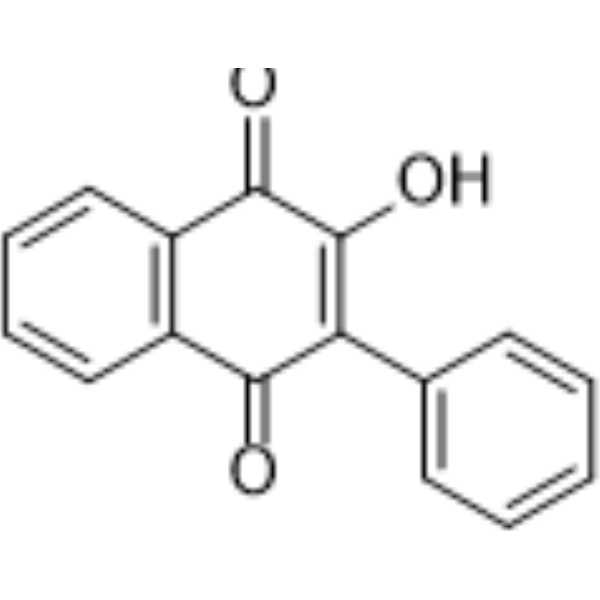
-
- HY-W009109
-
-
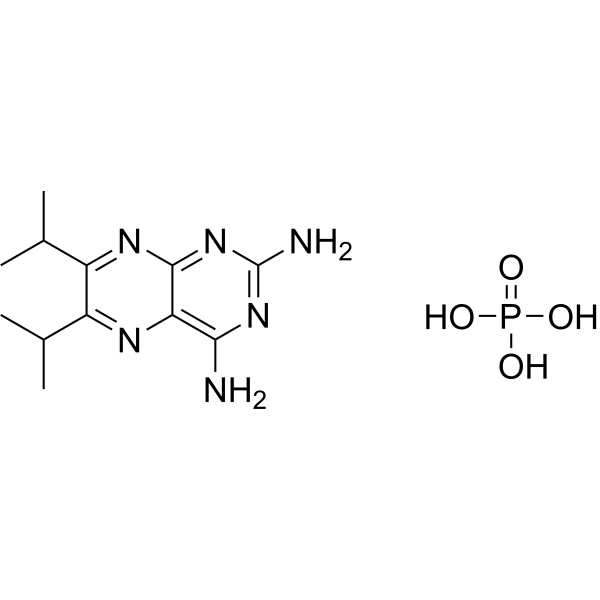
-
- HY-W131282
-
|
|
Parasite
|
Infection
|
|
Antimalarial agent 39 (compound 1) is an intermediate in the synthesis of antimalarial agents .
|
-

-
- HY-149938
-
|
|
Parasite
|
Infection
|
|
Antimalarial agent 25 is an orally active 1,4-naphthoquinones derivative with antimalarial activity. Antimalarial agent 25 shows cytotoxicity against P. falciparum. Antimalarial agent 25 inhibits P. burghei induced parasitemia in vivo .
|
-
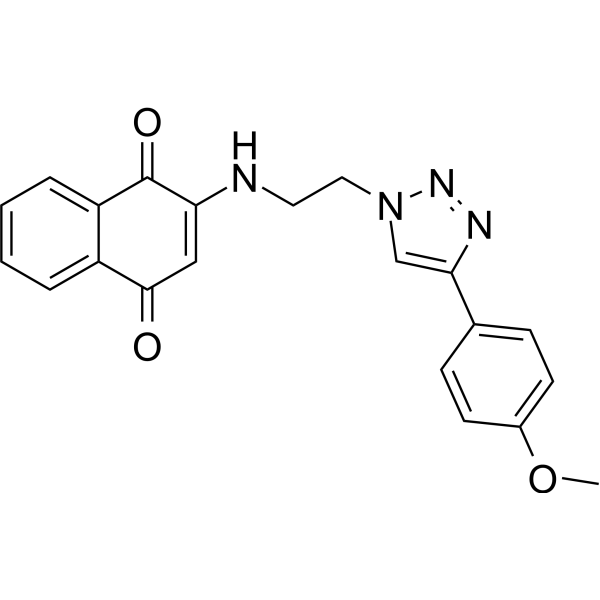
-
- HY-115905
-
|
|
Parasite
|
Infection
|
|
Antimalarial agent 9 (Compound 11) is a potent antimalarial agent. Antimalarial agent 9 is a quinoline-imidazole derivative compound. Antimalarial agent 9 exhibits significant antimalarial efficacy in-vitro against both CQ-sensitive (IC50-0.14 μM) and MDR strain (IC50-0.41 μM) with minimal cytotoxicity and high selectivity .
|
-
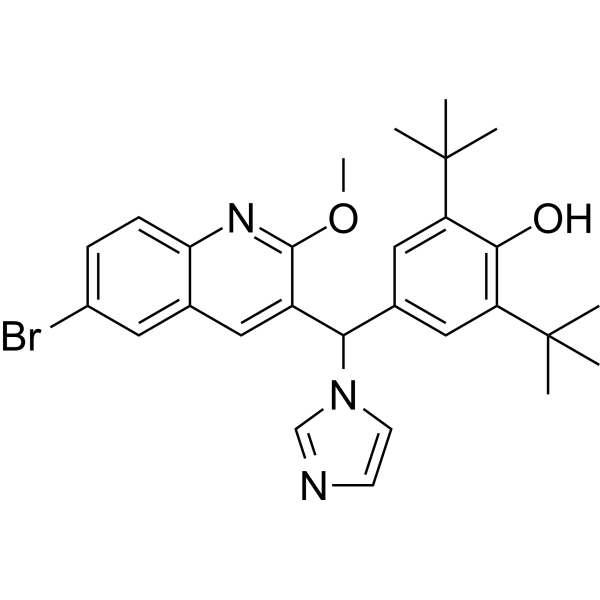
-
- HY-152614
-
|
|
Parasite
|
Infection
|
|
Antimalarial agent 19 (compound 6e) is an antimalarial active agent. Antimalarial agent 19 has antimalarial activity for the blood stage of P. falciparum K1 and P. berghei with EC50 values of 0.3 µM, 15.3 µM, respectively. Antimalarial agent 19 has good aqueous solubility, intestinal permeability and microsomal stability compared to gamhepathiopine .
|
-
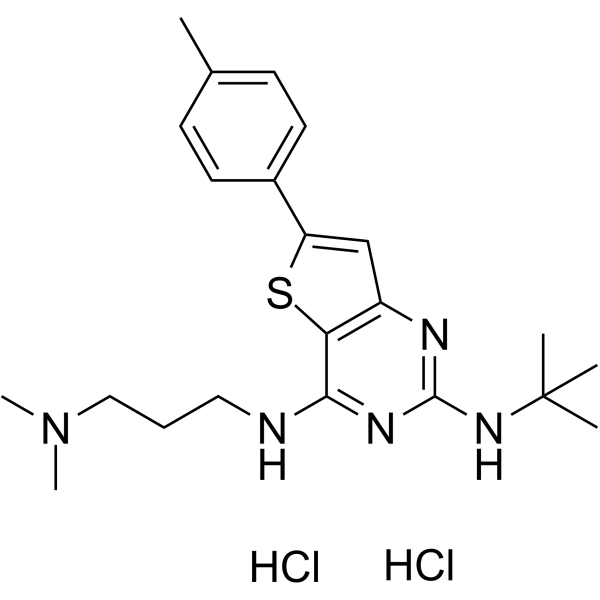
-
- HY-149939
-
|
|
Parasite
|
Infection
|
|
Antimalarial agent 26 is an orally active 1,4-naphthoquinones derivative with antimalarial activities. Antimalarial agent 26 shows cytotoxicity against P. falciparum and selectivity over mammalian cell lines. Antimalarial agent 26 inhibits P. burghei induced parasitemia in vivo .
|
-
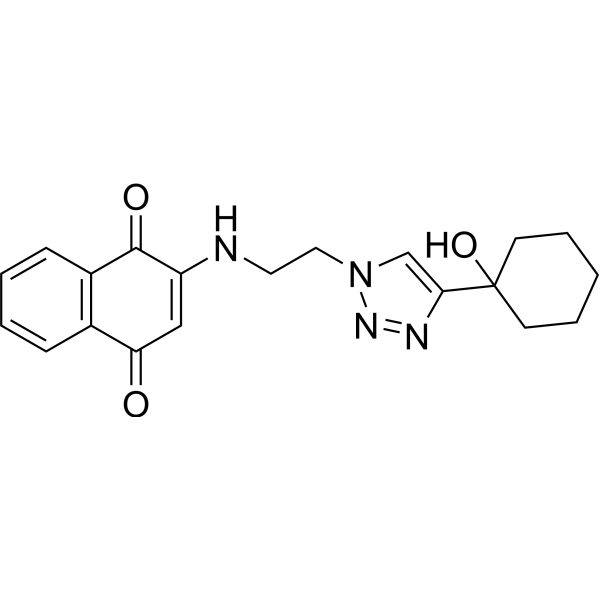
-
- HY-148429
-
|
|
Parasite
|
Others
|
|
Antimalarial agent 17 is an antimalarial agent, also acts as a herbicide. Antimalarial agent 17 is photosystem II inhibitor, shows post-emergence herbicidal activity equal to commercial herbicides .
|
-
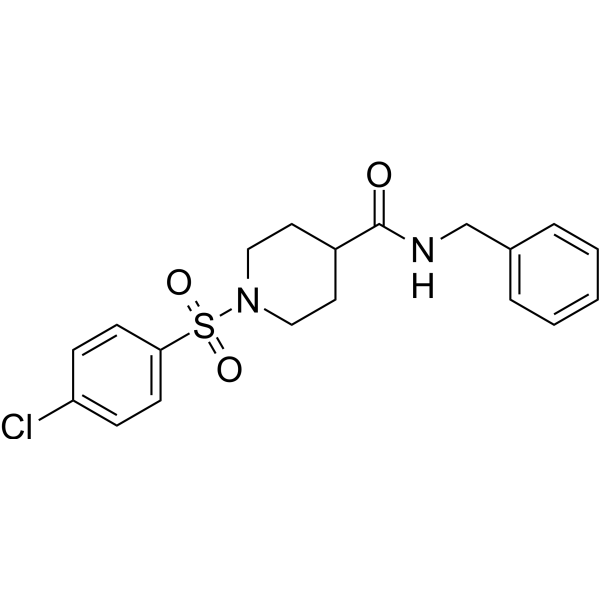
-
- HY-149937
-
|
|
Parasite
|
Infection
|
|
Antimalarial agent 24 (Compound 7) is an antimalarial agent in vitro. Antimalarial agent 24 inhibits P. falciparum W2 strain with an IC50 of 0.81 μM. Antimalarial agent 24 displays a CC50 higher than 200 μM against HepG2 cells .
|
-

-
- HY-115721
-
|
|
Parasite
|
Infection
|
|
Antimalarial agent 2 is a novel orally efficacious antimalarials that suggests a fast in vitro killing profile.
|
-
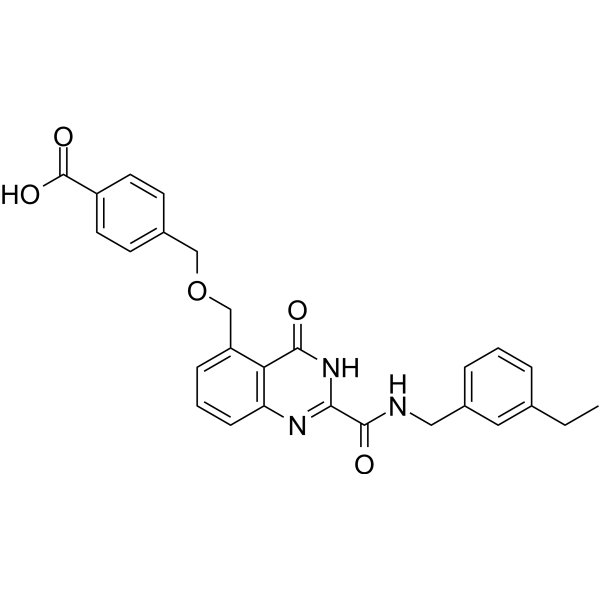
-
- HY-161170
-
|
|
Parasite
|
Infection
|
|
Antimalarial agent 36 (compound 1) is an antimalarial agent, with the EC50s of 58 nM and 42 nM, for Dd2 and 3D7, respectively. Antimalarial agent 36 targets EphA2 .
|
-

-
- HY-149919
-
|
|
Parasite
|
Infection
|
|
Antimalarial agent 23 is an antimalarial benzimidazole with IC50s of 0.08 μM and 0.10 μM for PfNF54 and PfK1, respectively. Antimalarial agent 23 has potent β-hematin inhibition activity. Antimalarial agent 23 does not directly inhibit the conversion of heme to hemozoin .
|
-
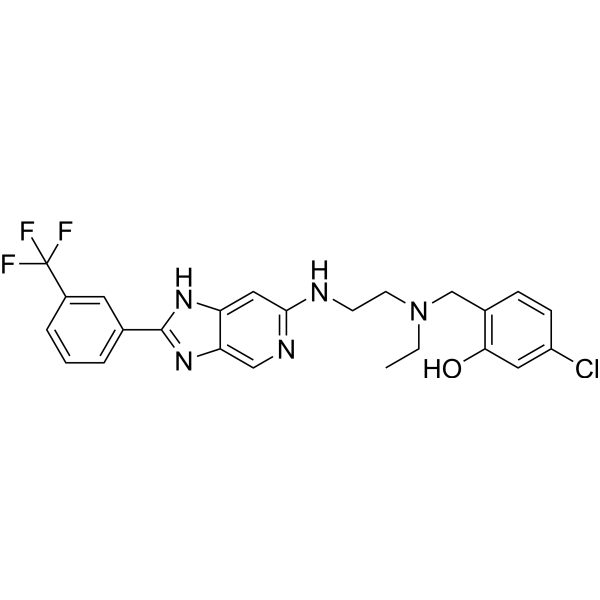
-
- HY-150066
-
|
|
Parasite
|
Infection
Inflammation/Immunology
|
|
Antimalarial agent 16 (Compound 4h) is a parasite inhibitor. Antimalarial agent 16 shows antimalarial activity, and can inhibit P. falciparum parasite growth (IC50=2.0 nM) .
|
-
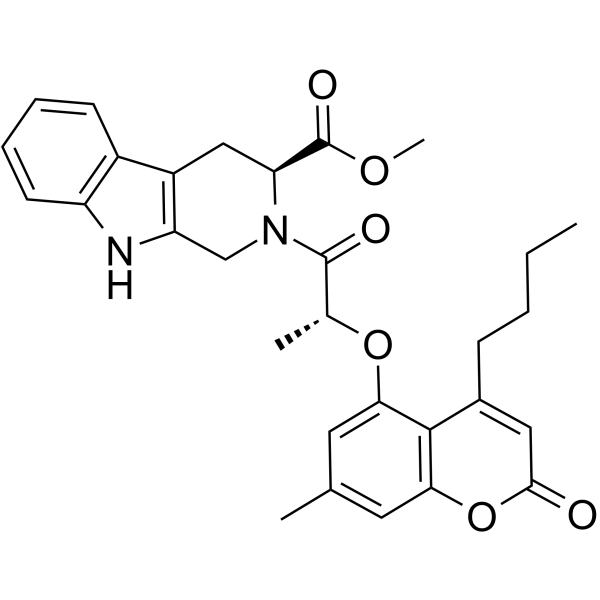
-
- HY-163070
-
|
|
Others
|
Infection
|
|
Antimalarial agent 35 (compound QP11) is a selective inhibitor FP2. Antimalarial agent 35 has antimalarial activity and shows synergistic effects when combined with chloroquine(HY-17589A) .
|
-
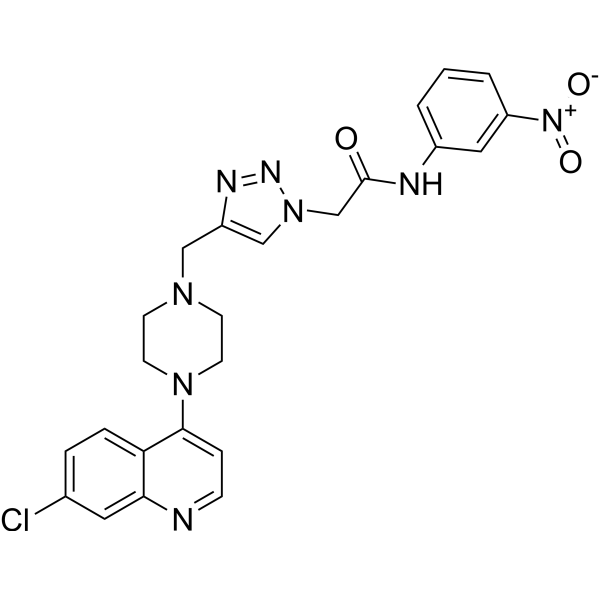
-
- HY-147198
-
|
|
Parasite
|
Infection
|
|
Antimalarial agent 13 (Compound 1) is a potent antimalarial agent. Antimalarial agent 13 shows inhibition with EC50 values of 124 nM and 2.5 μM against P. falciparum parasite and HepG2, respectively .
|
-
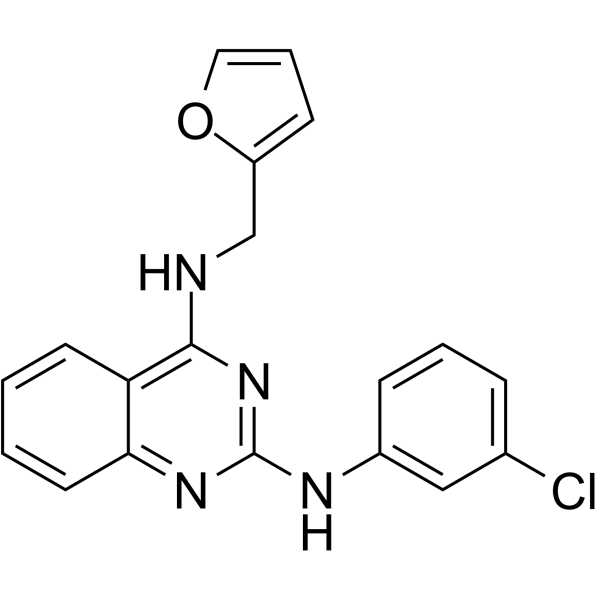
-
- HY-145704
-
|
|
Parasite
|
Infection
|
|
Antimalarial agent 8 (Compound 7e) is a novel orally active class of antimalarials. Antimalarial agent 8 is potent in vitro against P. falciparum and is orally efficacious (40 mg/kg) in an in vivo mouse model of malaria .
|
-
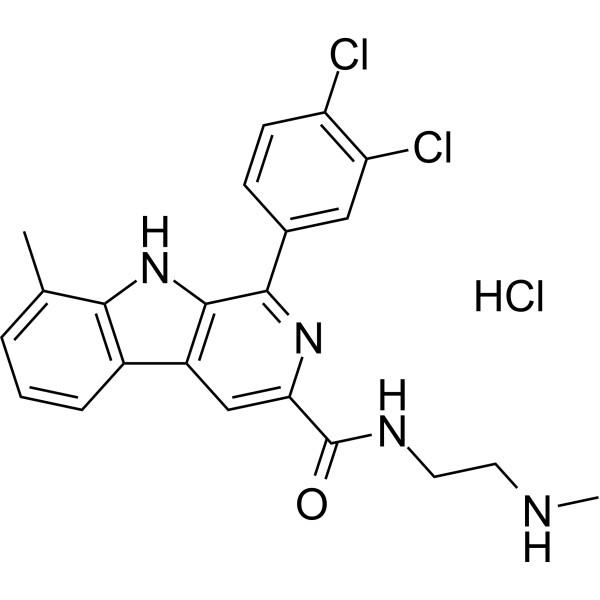
-
- HY-150065
-
|
|
Parasite
|
Infection
Inflammation/Immunology
|
|
Antimalarial agent 15 (Compound 4e) is a parasite inhibitor. Antimalarial agent 15 shows antimalarial activity, and can inhibit P. falciparum 3D7 parasite growth (IC50=20 nM) .
|
-
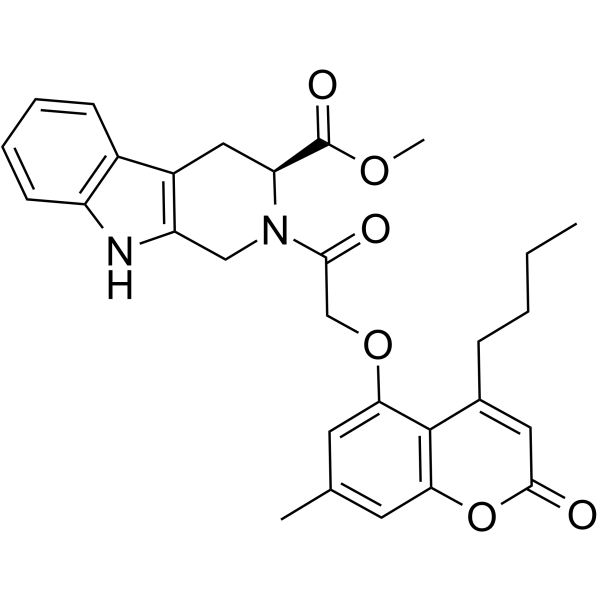
-
- HY-151965
-
|
|
Parasite
|
Infection
|
|
Antimalarial agent 18 is an potent antimalarial agent, based on electronic, highly lipophilic and siderophoric properties. Antimalarial agent 18 belongs to acyloxymethyl series, as a fosmidomycin surrogate, which is potent IspC inhibitor against the non-mevalonate isoprenoid biosynthesis pathway. Antimalarial agent 18 inhibits P. falciparum (IC50=50 nM) and A. baumanii (IC50=390 nM) .
|
-
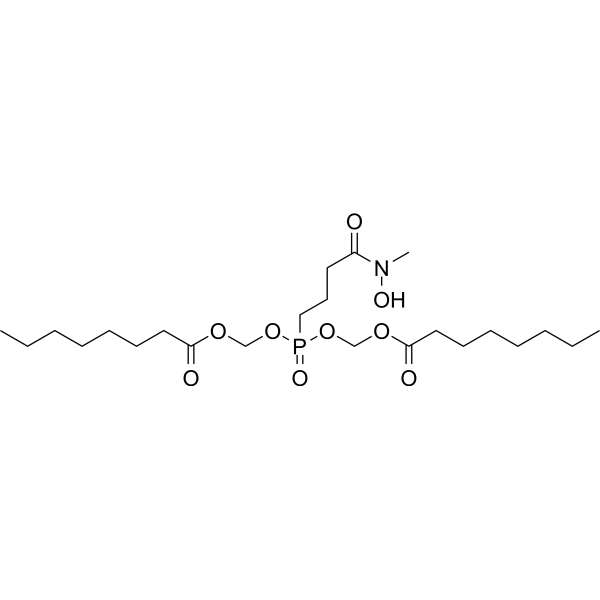
-
- HY-143487
-
|
|
Parasite
|
Infection
|
|
Antimalarial agent 12 (compound R-3b) is a potent antimalarial agent. Antimalarial agent 12 shows growth inhibition on P. falciparum Dd2 Strain (EC50=155 nM), 3D7 strain (EC50=136 nM). Antimalarial agent 12 has CC50 values of 10,000 to 50,000 nM for HEK-293 and hPHep cell lines. Antimalarial agent 12 has a MIC of >250,000 nM for Escherichia coli .
|
-

-
- HY-146769
-
|
|
Parasite
|
Infection
|
|
Antimalarial agent 11 (compound 1), a spirocyclic chromane, is a potent antimalarial agent. Antimalarial agent 11 exhibits excellent potency with an EC50 of 350 nM against the Chloroquine-resistant Dd2 strain. Antimalarial agent 11 has EC50s of 1.48 µM and 1.81 µM against D6 and ARC08-022 strains, respectively .
|
-
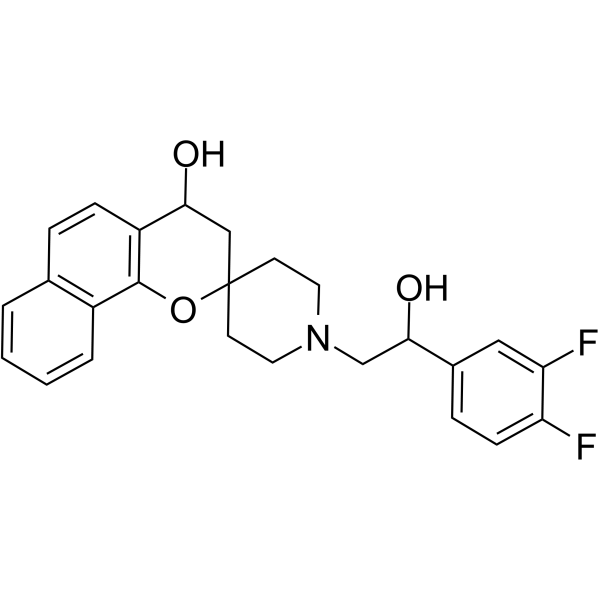
-
- HY-155689
-
|
|
Parasite
|
Infection
|
|
Antimalarial agent 30 (compound 11) is an antimalarial agent that inhibits P. berghei liver stage parasite load with an EC50 of 5.2 μM .
|
-
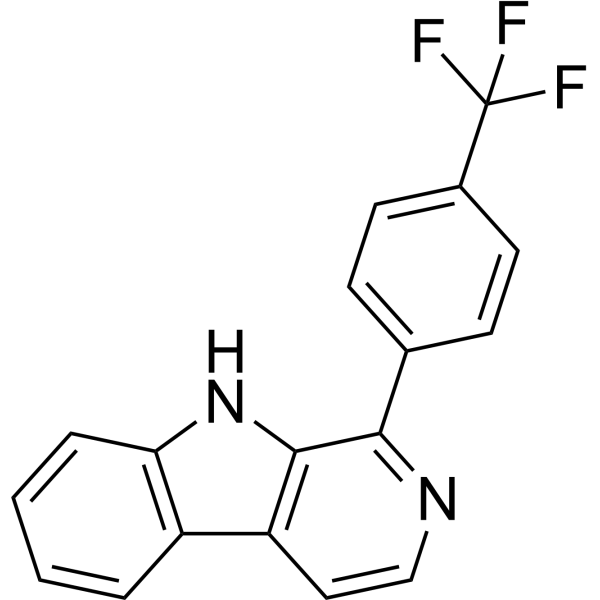
-
- HY-155688
-
|
|
Parasite
|
Infection
|
|
Antimalarial agent 29 (compound 16) is an antimalarial agent that inhibits P. berghei liver stage parasite load with an EC50 of 5.2 μM .
|
-
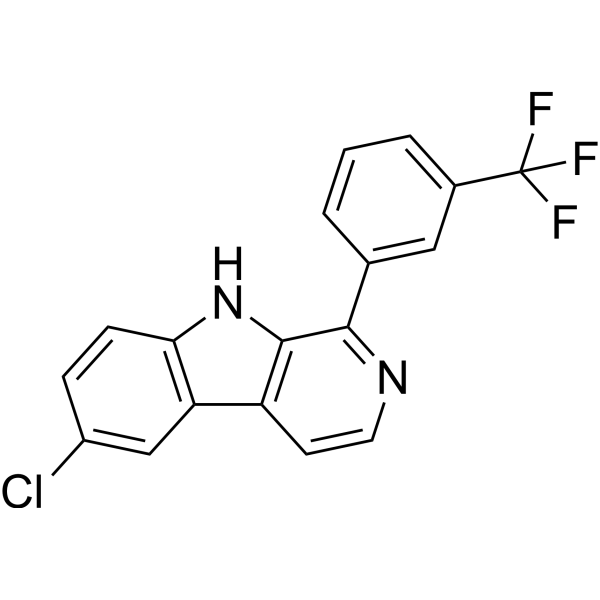
-
- HY-143409
-
|
|
Parasite
|
Infection
|
|
Antimalarial agent 10 (Compound 17b) is an aminoalcohol quinoline compound. Antimalarial agent 10 is an antimalarial agent with IC50 values of 14.9 nM and 11.0 nM against respectively Pf3D7 and PfW2 and a selectivity index higher than 770 whatever the cell line is .
|
-
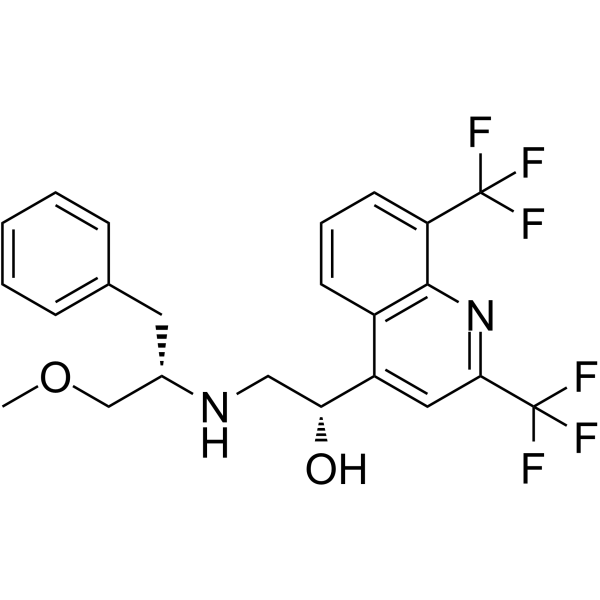
-
- HY-123915
-
|
|
Parasite
|
Infection
|
|
Antimalarial agent 20 (Compound 49c) is an antimalarial agent with an IC50 of 0.6 nM against P. falciparum NF54 parasite strain in the NF54 albumax assay .
|
-
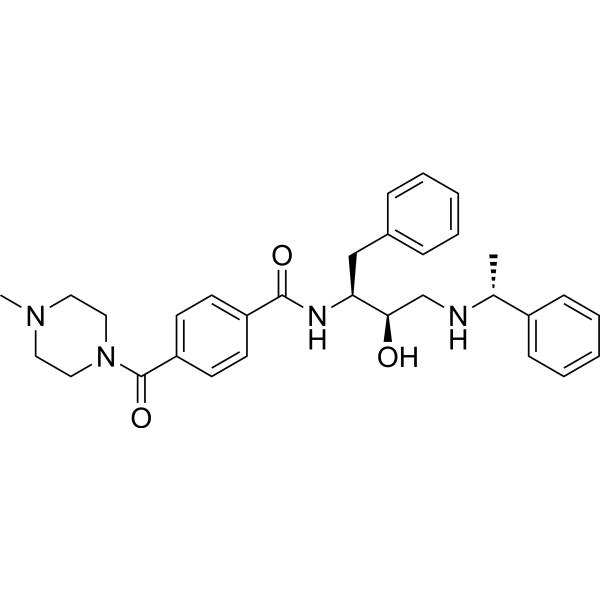
-
- HY-149882
-
|
|
Parasite
|
Infection
|
|
Antimalarial agent 27 (compound 11a) is an antimalarial agent, potently targeting to P.falciparum (IC50=0.37 μM). Antimalarial agent 27 acts function via P.falciparum DXR (1-deoxy-D-xylulose-5-phosphate reductoisomerase) inhibition (IC50=0.11 μM) .
|
-
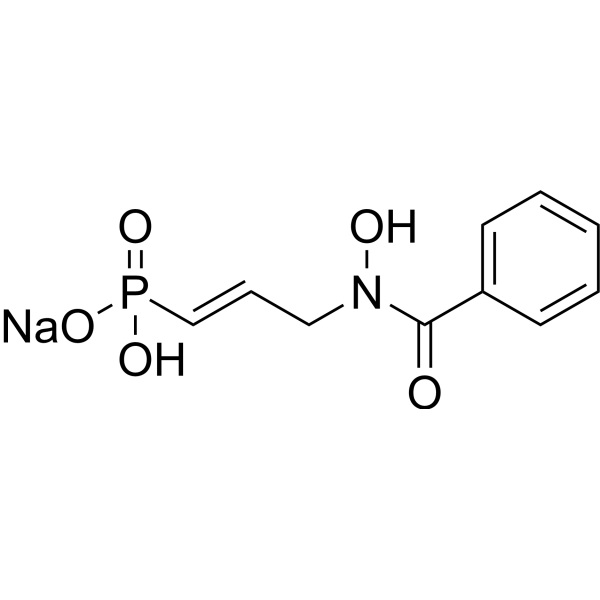
-
- HY-145327
-
|
|
Na+/K+ ATPase
Parasite
|
Infection
|
|
Antimalarial agent 7 is a potent inhibitor of PfATP4. PfATP4 is an essential ion pump on the parasite surface. Antimalarial agent 7 has the potential for the research of human malaria parasite, Plasmodium falciparum .
|
-

-
- HY-155354
-
|
|
Parasite
|
Infection
|
|
Antimalarial agent 33 (compound 5g) has antiplasmodial activity against erythrocytic and hepatic stages of Plasmodium with an EC50 of 1.1 μM for K1 P. falciparum strain. Antimalarial agent 33 demonstrats enhanced microsomal stability (T1/2=29 min). Antimalarial agent 33 has no significant cytotoxicity against primary hepatocytes .
|
-
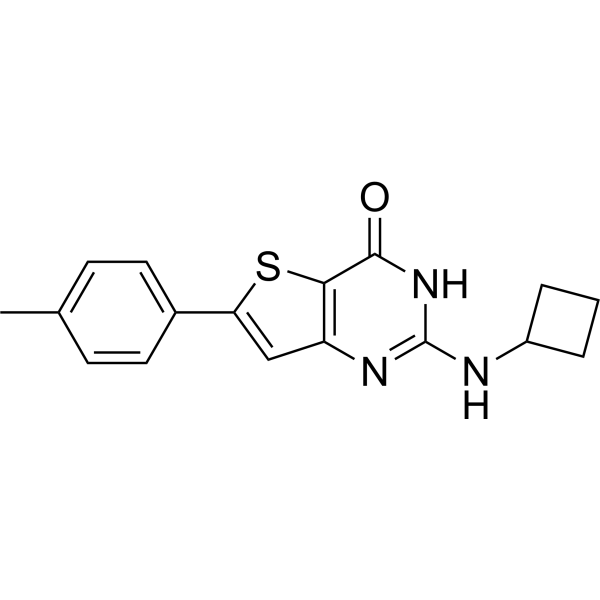
-
- HY-161171
-
|
|
Parasite
Ephrin Receptor
|
Cancer
|
|
Antimalarial agent 37 (compound 33) is a selective inhibitor against Type Ⅱ kinase with antiplasmodial activity. Antimalarial agent 37 exhibited cytotoxicity and selectivity towards cancer cells HepG2 and MCF 7 .
|
-

-
- HY-155536
-
|
|
Parasite
|
Infection
|
|
Antimalarial agent 28 (Compound 2i) is an antiplasmodial agent. Antimalarial agent 28 inhibits P. berghei, with IC50s of 0.561 μM, 0.14 μM, 4.34 μM for Liver stage, early gametocytes and ring stages of P. falciparum .
|
-

-
- HY-157892
-
|
|
Parasite
|
Infection
|
|
Antimalarial agent 38 (Compound 1) exhibits activity against antiplasmodial, which inhibits Plasmodium falciparum D6 strain, chloroquine-sensitive Thai strain and chloroquine-resistant FcB1 strain and K1 strain, with IC50s of 0.5, 13, 1 and 13 μM, respectively. Antimalarial agent 38 is non-cytotoxic for mammalian cells MCR58 (IC50 >140 μM). Antimalarial agent 38 improves the survival rate of Plasmodium yoelii nigeriensis infected mouse model .
|
-

-
- HY-155130
-
|
|
Parasite
|
Infection
|
|
Antimalarial agent 31 (compound 7k) is an orally active Plasmodium falciparum aspartic protease plasmepsin X (PMX) inhibitor .
|
-
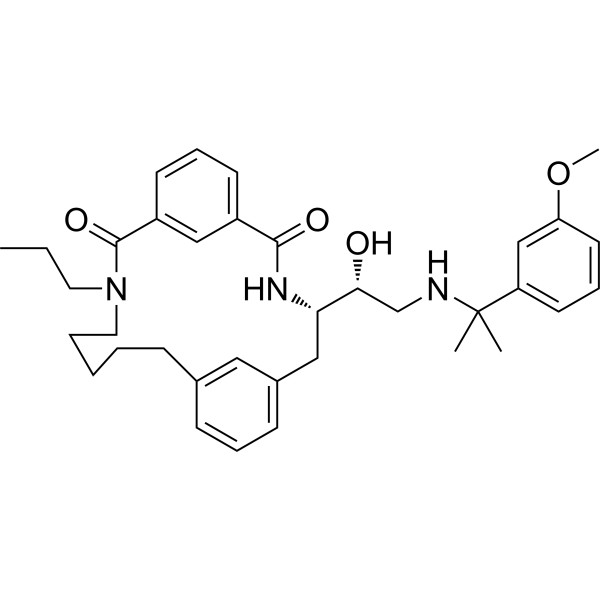
-
- HY-163063
-
|
|
Parasite
|
Infection
|
|
Antimalarial agent 34 is a modest PfARK1/3 inhibitor and shows potent antiplasmodial activity (EC50 = 0.16 μM) .
|
-
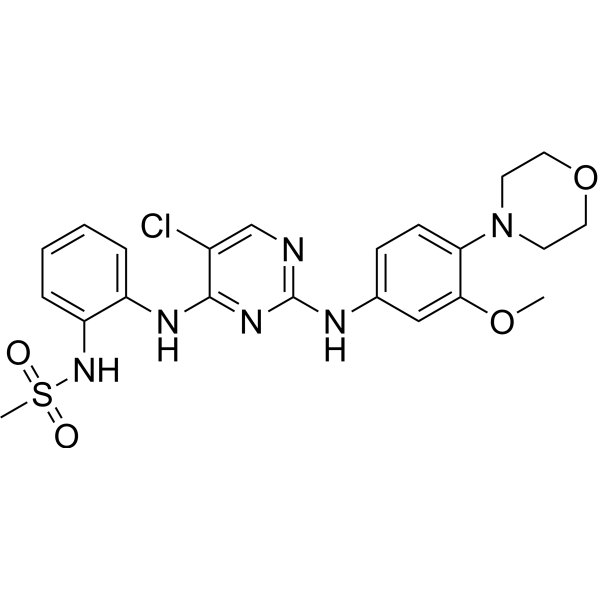
-
- HY-132906
-
|
|
Parasite
|
Infection
|
|
Antimalarial agent 3 shows nanomolar antiplasmodial activity (IC50 = 0.035 μM) and has a very high selectivity index with respect to mammalian cells.
|
-
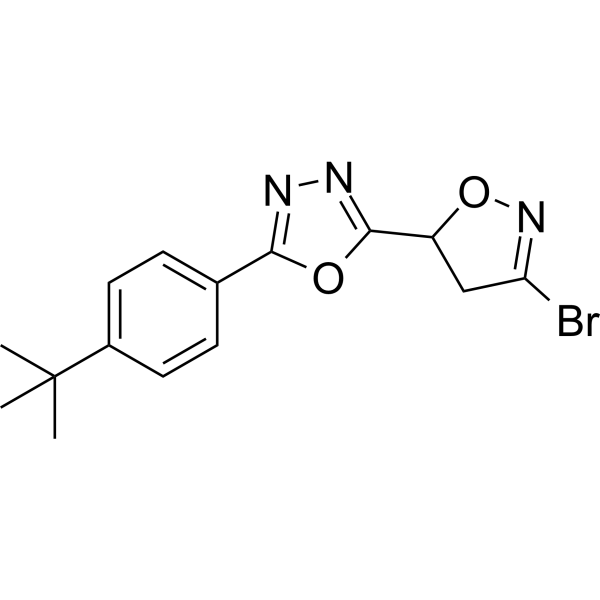
-
- HY-N2899
-
|
|
Parasite
|
Infection
|
|
Arteannuin M can be isolated from Artemisia annua, and can be used for anti-malarial research .
|
-
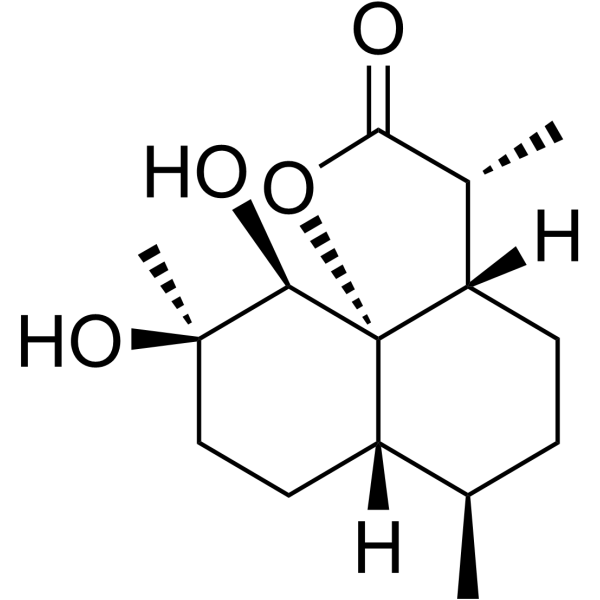
-
- HY-N2900
-
|
|
Parasite
|
Infection
|
|
Arteannuin N can be isolated from Artemisia annua, and can be used for anti-malarial research .
|
-
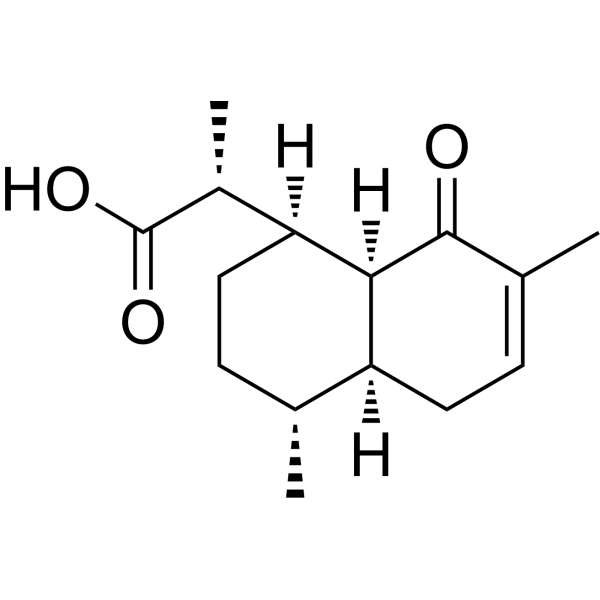
-
- HY-N2903
-
|
|
Parasite
|
Infection
|
|
Artoheterophyllin B can be isolated from A. heterophyllus. Artoheterophyllin B shows antiplasmodial activity (IC50: 13.7 μM against FcB1 strain). Artoheterophyllin B can be used for anti-malarial research .
|
-
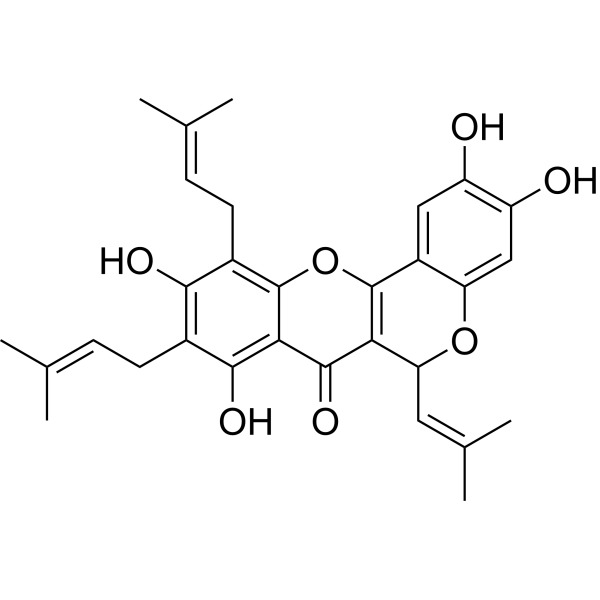
-
- HY-16762
-
|
OZ439
|
Parasite
Ferroptosis
SARS-CoV
|
Infection
|
|
Artefenomel (OZ439) is an orally active, synthetic anti-malarial compound containing an artemisinin pharmacophore with a mechanism of action similar to that of artemisinin. Artefenomel has antiviral activity against SARS-CoV-2 .
|
-
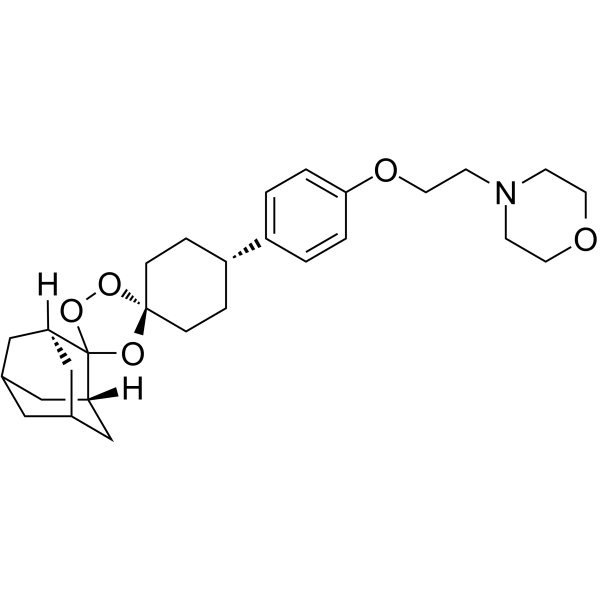
-
- HY-B0433A
-
|
|
Flavivirus
Dengue virus
Parasite
Potassium Channel
|
Infection
|
|
Quinine hydrochloride dihydrate (Qualaquin) is an orally active and can be used in anti-malarial studies. Quinine hydrochloride dihydrate is a potassium channel inhibitor that inhibits WT mouse Slo3 (KCa5.1) channel currents evoked by voltage pulses to +100 mV with an IC50 of 169 μM .
|
-
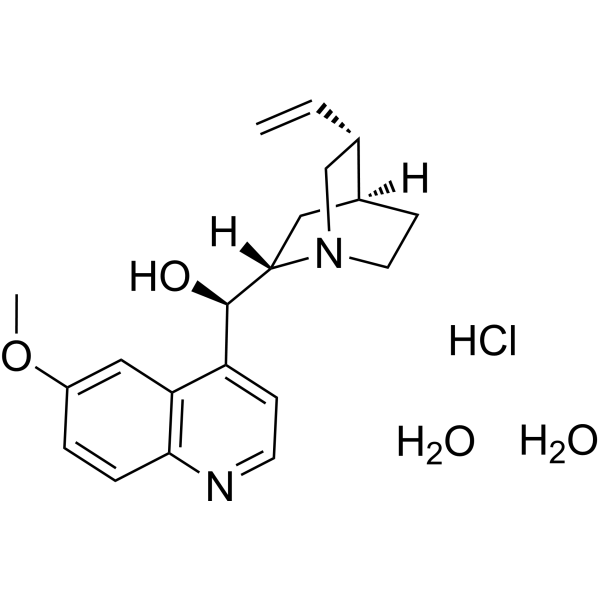
-
- HY-D0143A
-
|
|
Flavivirus
Dengue virus
Parasite
Potassium Channel
|
Infection
|
|
Quinine dihydrochloride is an orally active alkaloid extracted from cinchona bark and can be used in anti-malarial studies. Quinine dihydrochloride is a potassium channel inhibitor that inhibits WT mouse Slo3 (KCa5.1) channel currents evoked by voltage pulses to +100 mV with an IC50 of 169 μM .
|
-
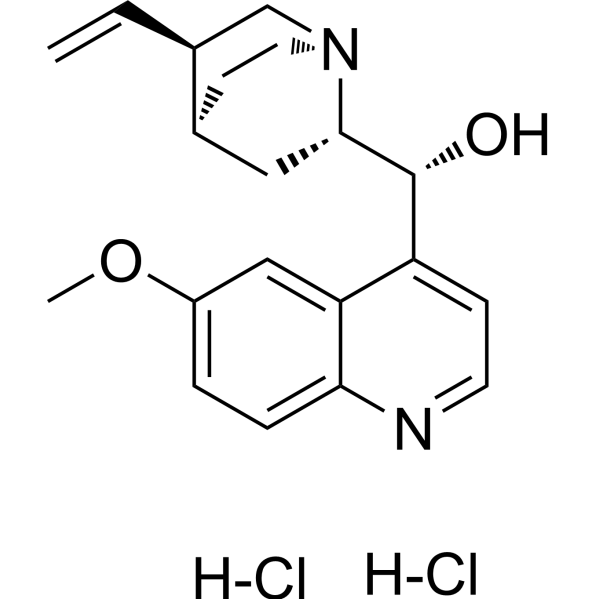
-
- HY-B0433B
-
|
|
Flavivirus
Dengue virus
Parasite
Potassium Channel
|
Infection
|
|
Quinine hemisulfate is an orally active alkaloid extracted from cinchona bark and can be used in anti-malarial studies. Quinine hemisulfate is a potassium channel inhibitor that inhibits WT mouse Slo3 (KCa5.1) channel currents evoked by voltage pulses to +100 mV with an IC50 of 169 μM .
|
-

-
- HY-W010668
-
|
|
Flavivirus
Dengue virus
Parasite
Potassium Channel
|
Others
|
|
Quinine sulfate hydrate (2:1:4) is an orally active alkaloid extracted from cinchona bark and can be used in anti-malarial studies. Quinine sulfate hydrate (2:1:4) is a potassium channel inhibitor that inhibits WT mouse Slo3 (KCa5.1) channel currents evoked by voltage pulses to +100 mV with an IC50 of 169 μM .
|
-
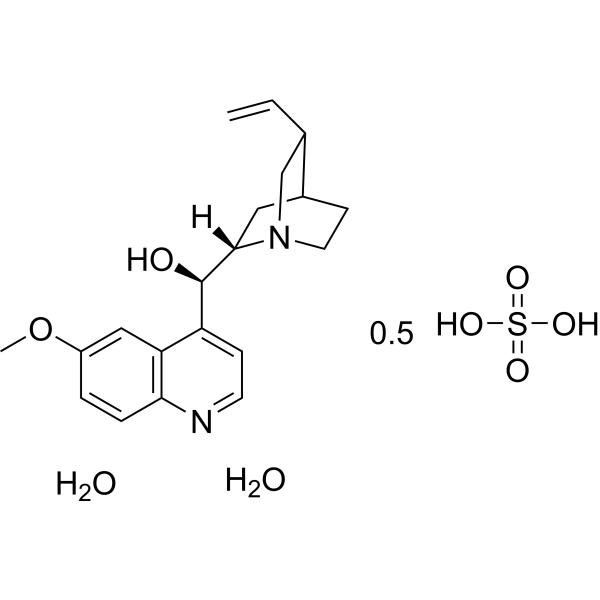
-
- HY-13557
-
|
Immunomycin; FR-900520; FK520
|
FKBP
Parasite
Fungal
Antibiotic
|
Infection
Neurological Disease
Inflammation/Immunology
|
|
Ascomycin (Immunomycin; FR-900520; FK520) is an ethyl analog of Tacrolimus (FK506) with strong immunosuppressant properties. Ascomycin is also a macrocyclic polyketide antibiotic with multiple biological activities such as anti-malarial, anti-fungal and anti-spasmodic. Ascomycin prevents graft rejection and has potential for varying skin ailments research .
|
-
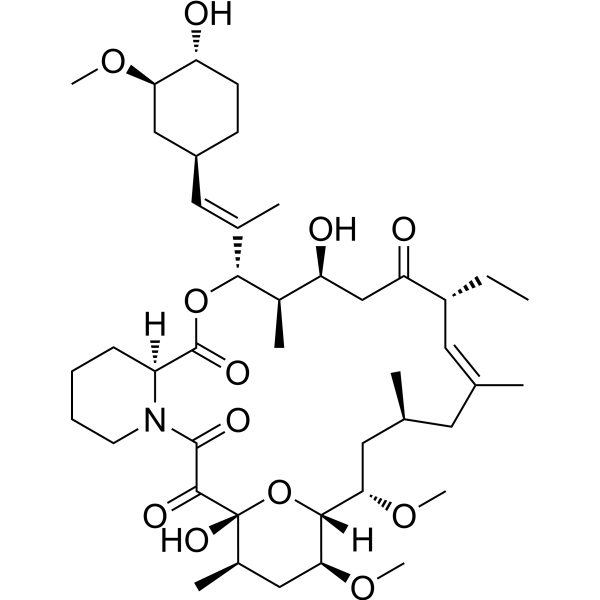
-
- HY-N0402
-
-
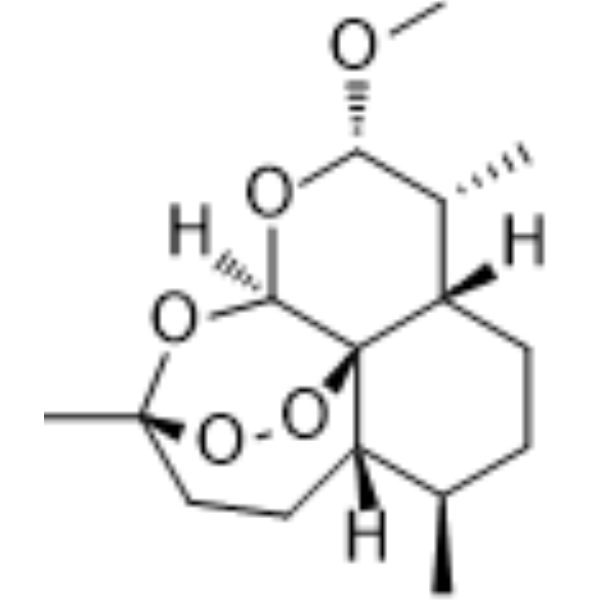
-
- HY-111529
-
|
WR 238605
|
Parasite
|
Infection
|
|
Tafenoquine (WR 238605) is an 8-aminoquinoline. Tafenoquine is an anti-malarial prophylactic agent .
|
-
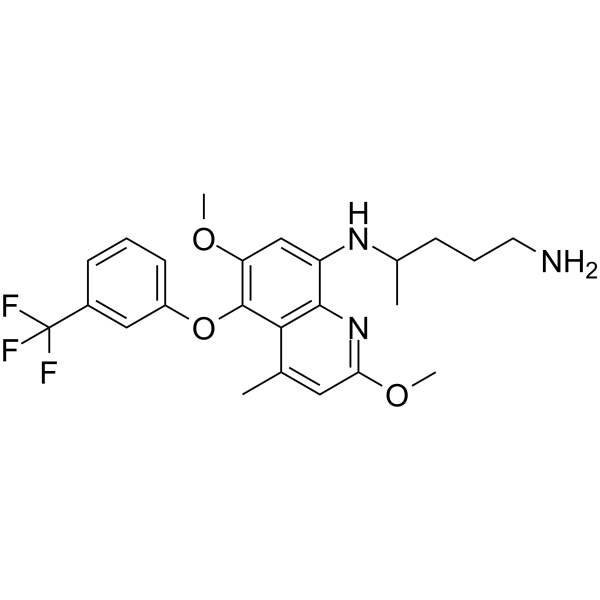
-
- HY-N7030
-
|
|
Fungal
Parasite
Bacterial
|
Infection
|
|
5,7,3',4'-Tetramethoxyflavone, an orally active polymethoxyflavones (PMFs) that can be isolated from M. exotica, possesses various bioactivities, including anti-fungal, anti-malarial, anti-mycobacterial, and anti-inflammatory activities. 5,7,3',4'-Tetramethoxyflavone exhibits chondroprotective activity by targeting β-catenin signaling .
|
-
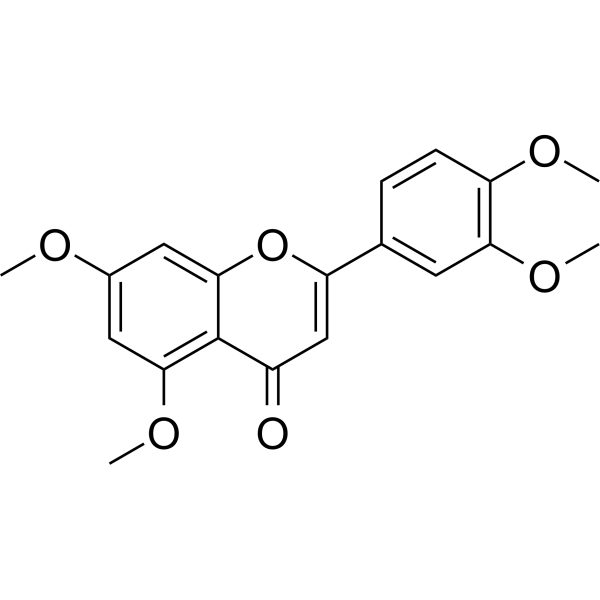
-
- HY-111529A
-
|
WR 238605 (Succinate)
|
Parasite
|
Infection
|
|
Tafenoquine Succinate (WR 238605 Succinate) is an 8-aminoquinoline. Tafenoquine is an anti-malarial prophylactic agent .
|
-
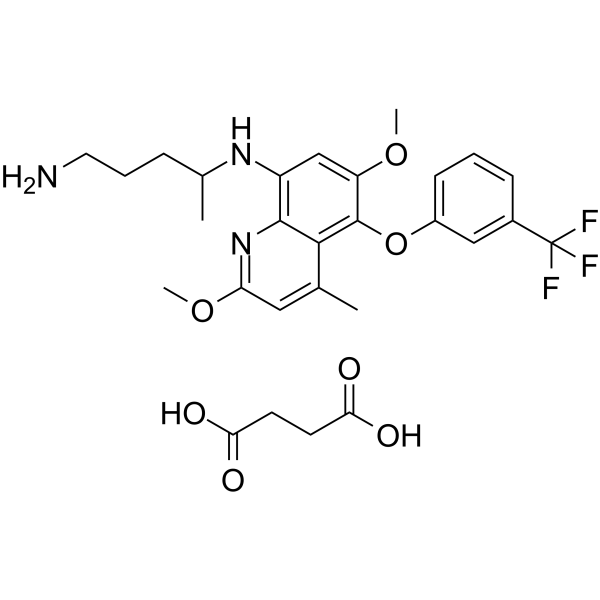
-
- HY-B0803S1
-
|
Benflumetol-d9
|
Isotope-Labeled Compounds
Parasite
Autophagy
|
Infection
|
|
Lumefantrine-d9 is the deuterium labeled Lumefantrine. Lumefantrine is an antimalarial drug, used in combination with Artemether. The artemether-lumefantrine (AL) as the first- and second-line anti-malarial drugs.
|
-
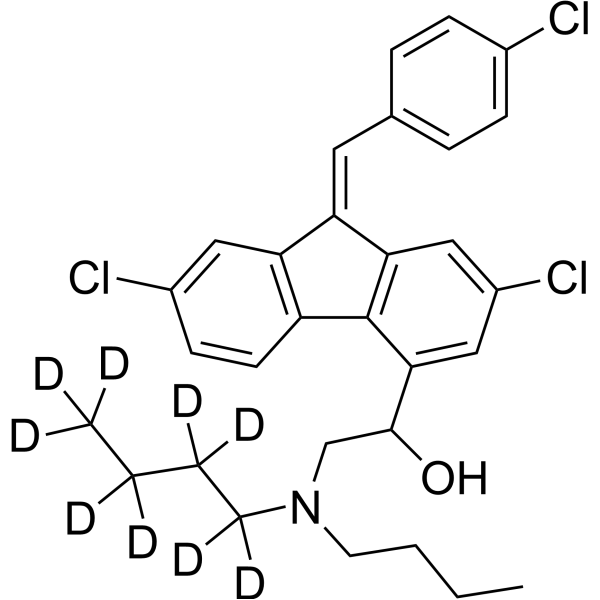
-
- HY-147850
-
|
|
Parasite
|
Infection
|
|
JMI-346 is a potent PfFP-2 (Plasmodium falciparum falcipain-2 protease) inhibitor. JMI-346 inhibits the growth of CQ S (3D7; IC50=13 µM) and CQ R (RKL-9; IC50=33 µM) strains of P. falciparum. JMI-346 has the potential to be used as an anti-malarial agent .
|
-

-
- HY-14749
-
|
|
Parasite
|
Infection
|
|
Pyronaridine is an orally active Mannich base anti-malarial agent. Pyronaridine is active against P. falciparum and Echinococcus granulosus infection .
|
-

-
- HY-14749A
-
|
|
Parasite
|
Infection
|
|
Pyronaridine tetraphosphate is an orally active Mannich base anti-malarial agent. Pyronaridine tetraphosphate is active against P. falciparum and Echinococcus granulosus infection .
|
-
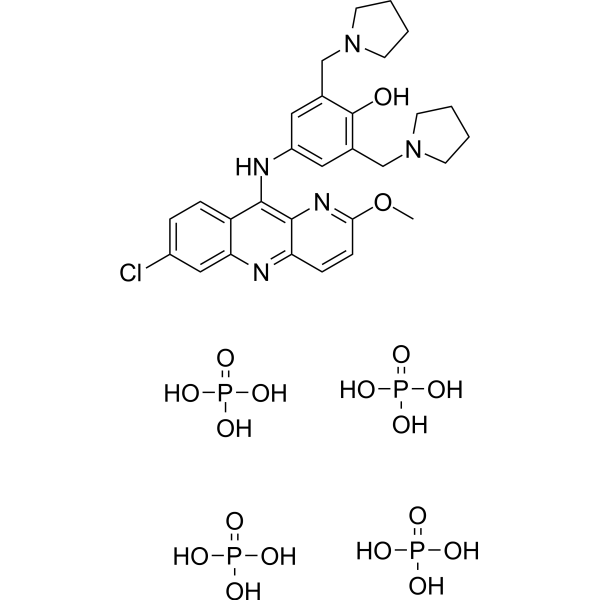
- HY-N2281
-
|
|
Apoptosis
|
Inflammation/Immunology
Cancer
|
|
Leachianone A, isolated from Radix Sophorae, has anti-malarial, anti-inflammatory, and cytotoxic potent .
Leachianone A induces apoptosis involved both extrinsic and intrinsic pathways .
|
-
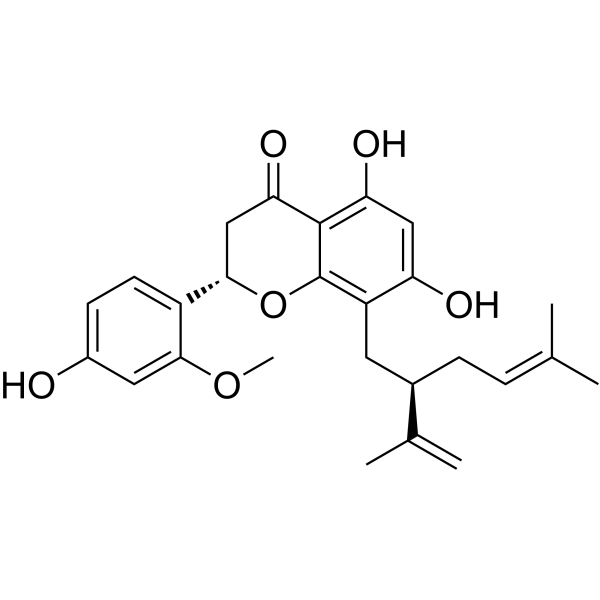
- HY-149961
-
|
|
Parasite
|
Infection
Inflammation/Immunology
|
|
Anti-inflammatory agent 40 is a potential and orally active anti-malarial and anti-inflammatory agent. Anti-inflammatory agent 40 inhibits carrageenan induced paw swelling in vivo.
|
-

- HY-147849
-
|
|
Parasite
|
Infection
|
|
JMI-105 is a potent PfFP-2 (Plasmodium falciparum falcipain-2 protease) inhibitor. JMI-105 inhibits the growth of CQ S (3D7; IC50=8.8 µM) and CQ R (RKL-9; IC50=14.3 µM) strains of P. falciparum. JMI-105 significantly decreases parasitemia and prolonged host survival in a murine model with P. berghei ANKA infection. JMI-105 has the potential to be used as an anti-malarial agent .
|
-
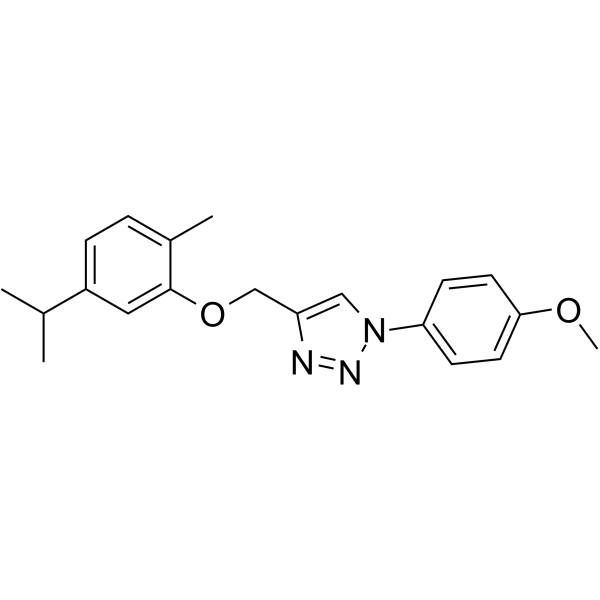
- HY-10529
-
-

- HY-N12077
-
|
|
Parasite
|
Infection
|
|
Eurycomanol 2-O-β-D-glucopyranoside (compound 4) is a natural product that can be obtained from Eurycoma longifolia. Eurycomanol 2-O-β-D-glucopyranoside has the potential for anti-malarial research .
|
-
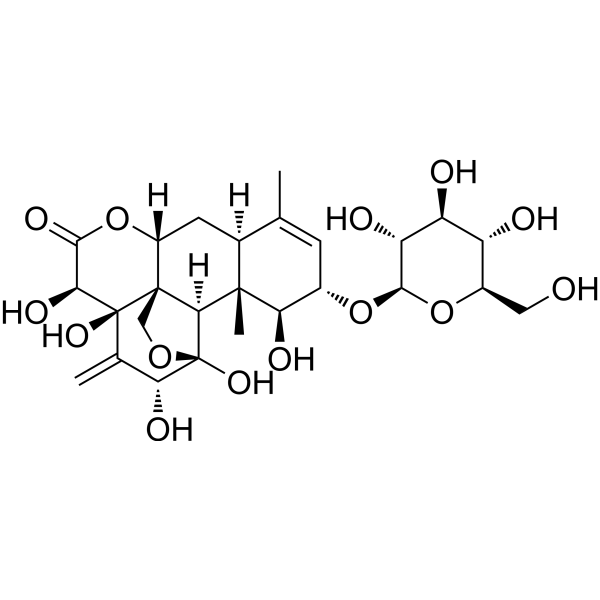
- HY-131708A
-
|
|
HDAC
Parasite
|
Infection
|
|
FNDR-20123 is a safe, first-in-class, and orally active anti-malarial HDAC inhibitor with IC50s of 31 nM and 3 nM for Plasmodium and human HDAC, respectively. FNDR-20123 exerts anti-malarial activity against Plasmodium falciparum asexual stage (IC50=41 nM) and sexual blood stage (IC50=190 nM for male gametocytes). FNDR-20123 inhibits HDAC1, HDAC2, HDAC3, HDAC6, and HDAC8 (IC50=25/29/2/11/282 nM, respectively.) and inhibits Class III HDAC isoforms at nanomolar concentrations .
|
-

- HY-107566
-
|
|
Histamine Receptor
Parasite
|
Infection
|
|
Conessine, a steroidal alkaloid, is a potent and selective histamine H3 receptor antagonist with Kis of 5.4, 6.0, 5.7 and 25 nM for human, dog, guinea pig, and rat H H3 receptor, respectively. Anti-malarial activity .
|
-

- HY-14749AS
-
|
|
Parasite
|
Infection
|
|
Pyronaridine-d4 (tetraphosphate) is the deuterium labeled Pyronaridine tetraphosphate[1]. Pyronaridine tetraphosphate is an orally active Mannich base anti-malarial agent. Pyronaridine tetraphosphate is active against P. falciparum and Echinococcus granulosus infection[2][3].
|
-
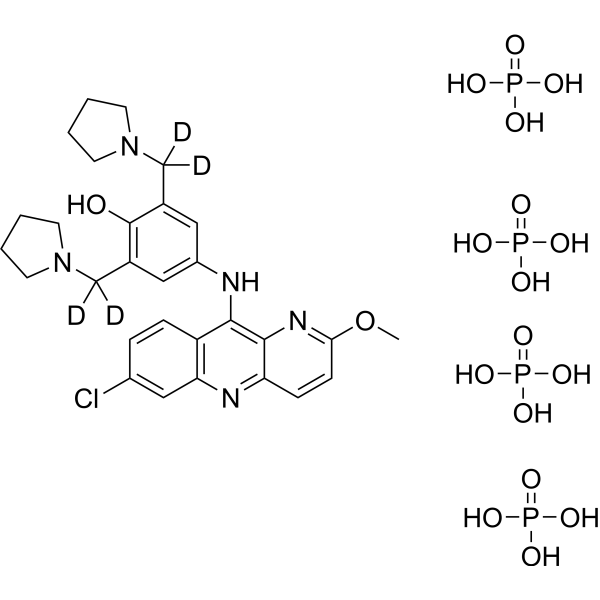
- HY-14749AR
-
|
|
Parasite
|
Infection
|
|
Pyronaridine (tetraphosphate) (Standard) is the analytical standard of Pyronaridine (tetraphosphate). This product is intended for research and analytical applications. Pyronaridine tetraphosphate is an orally active Mannich base anti-malarial agent. Pyronaridine tetraphosphate is active against P. falciparum and Echinococcus granulosus infection .
|
-

- HY-N2795
-
|
Xanthone I
|
Parasite
Bacterial
|
Infection
|
|
9-Hydroxycalabaxanthone (Xanthone I) is a known xanthone isolated from Garcinia mangostana Linn. 9-Hydroxycalabaxanthone has quorum-sensing inhibitory, anti-microbial, and anti-malarial activities (IC50=1.2-1.5 µM) .
|
-
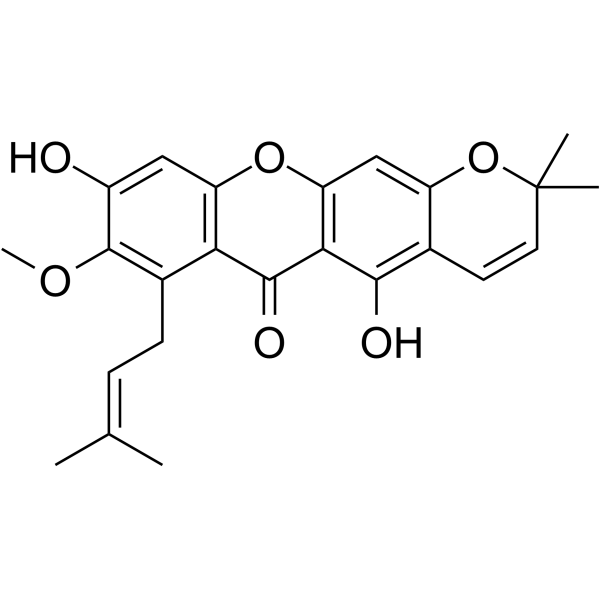
- HY-131708
-
|
|
HDAC
Parasite
|
Infection
|
|
FNDR-20123 free base is a safe, first-in-class, and orally active anti-malarial HDAC inhibitor with IC50s of 31 nM and 3 nM for Plasmodium and human HDAC, respectively. FNDR-20123 free base exerts anti-malarial activity against Plasmodium falciparum asexual stage (IC50=41 nM) and sexual blood stage (IC50=190 nM for male gametocytes). FNDR-20123 free base inhibits HDAC1, HDAC2, HDAC3, HDAC6, and HDAC8 (IC50=25, 29, 2, 11, and 282 nM, respectively) and inhibits Class III HDAC isoforms at nanomolar concentrations .
|
-

- HY-156843
-
|
|
Others
|
Cancer
|
|
Antiproliferative agent-38 (com 18) is a tetracyclic ring, but its most reactive ring nitrogen (probably the quinoline moiety) cannot undergo N-alkylation. Antiproliferative agent-38 lacks anti-malarial activity and lacks anti-cancer cell proliferation activity .
|
-
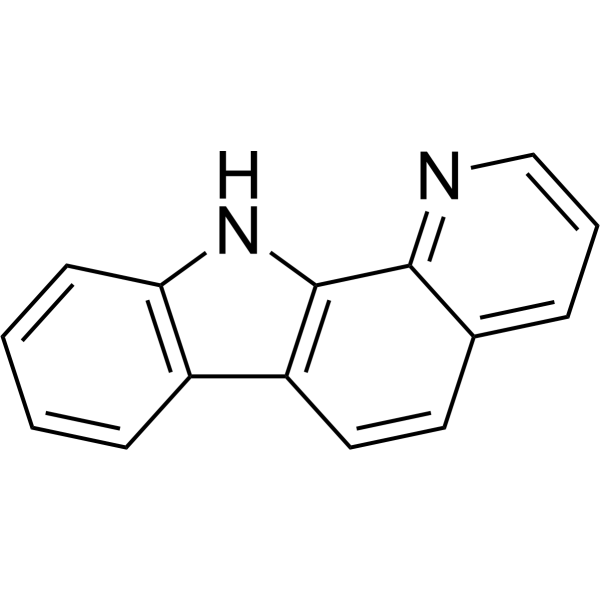
- HY-B0094
-
|
Qinghaosu; NSC 369397
|
HCV
Parasite
Akt
Ferroptosis
|
Infection
Neurological Disease
Cancer
|
|
Artemisinin (Qinghaosu), a sesquiterpene lactone, is an anti-malarial agent isolated from the aerial parts of Artemisia annua L. plants . Artemisinin inhibits AKT signaling pathway by decreasing pAKT in a dose-dependent manner. Artemisinin reduces cancer cell proliferation, migration, invasion, tumorigenesis and metastasis and has neuroprotective effects .
|
-

- HY-N1074
-
|
Scandenolone
|
Parasite
PKA
|
Infection
Inflammation/Immunology
|
|
Warangalone is an anti-malarial compound which can inhibit the growth of both strains of parasite 3D7 (chloroquine sensitive) and K1 (chloroquine resistant) with IC50s of 4.8 μg/mL and 3.7 μg/mL, respectively. Warangalone can also inhibit cyclic AMP-dependent protein kinase catalytic subunit (cAK) with an IC50 of 3.5 μM.
|
-
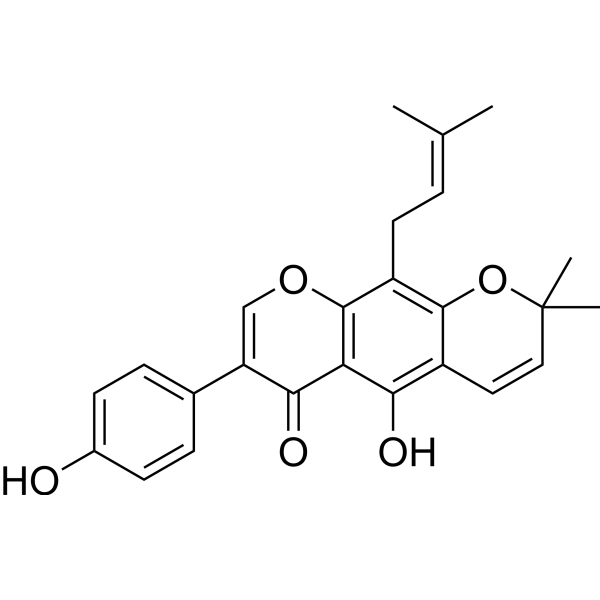
- HY-B0094S
-
|
Qinghaosu-d3; NSC 369397-d3
|
Akt
Ferroptosis
HCV
Parasite
|
Infection
Neurological Disease
Cancer
|
|
Artemisinin-d3 is the deuterium labeled Artemisinin. Artemisinin (Qinghaosu), a sesquiterpene lactone, is an anti-malarial agent isolated from the aerial parts of Artemisia annua L. plants[1]. Artemisinin inhibits AKT signaling pathway by decreasing pAKT in a dose-dependent manner. Artemisinin reduces cancer cell proliferation, migration, invasion, tumorigenesis and metastasis and has neuroprotective effects[2].
|
-

- HY-N1457
-
|
|
P-glycoprotein
Cytochrome P450
Ferroptosis
|
Metabolic Disease
|
|
Chrysosplenetin is one of the polymethoxylated flavonoids in Artemisia annua L. (Compositae) and other several Chinese herbs. Chrysosplenetin inhibits P-gp activity and reverses the up-regulated P-gp and MDR1 levels induced by artemisinin (ART). Chrysosplenetin significantly augments the rat plasma level and anti-malarial efficacy of ART, partially due to the uncompetitive inhibition effect of Chrysosplenetin on rat CYP3A .
|
-

- HY-153612
-
|
|
GLUT
Parasite
|
Infection
Inflammation/Immunology
|
|
MMV009085 is a potent PfHT1 (Plasmodium falciparum hexose transporter)-specific inhibitor and a potential anti-malarial agent . MMV009085 is also a human glucose transporter inhibitor, it has high potency in inhibiting both glucose uptake (IC50: 2.6 μM in glucose uptake assay) and growth of the parasites (EC50: 1.23±0.04 μM against 3D7) .
|
-
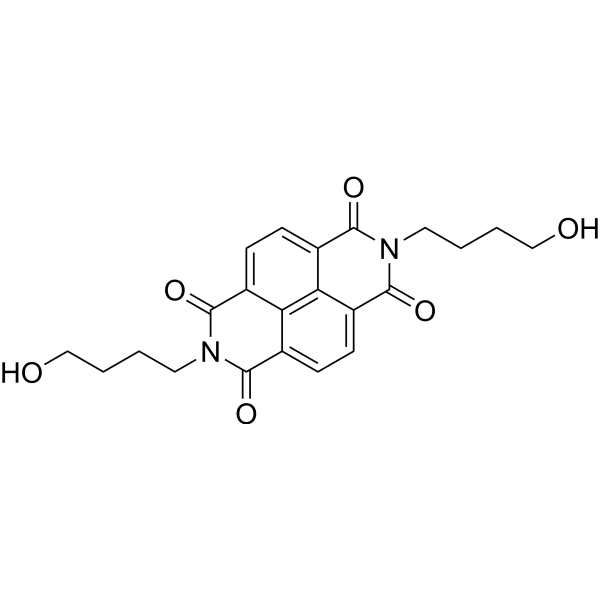
- HY-N0674A
-
|
13-Methylpalmatine chloride
|
Bcl-2 Family
Caspase
PARP
p38 MAPK
Parasite
Autophagy
|
Infection
Cancer
|
|
Dehydrocorydaline chloride (13-Methylpalmatine chloride) is an alkaloid that regulates protein expression of Bax, Bcl-2; activates caspase-7, caspase-8, and inactivates PARP . Dehydrocorydaline chloride elevates p38 MAPK activation. Anti-inflammatory and anti-cancer activities . Dehydrocorydaline chloride shows strong anti-malarial effects (IC50 =38 nM), and low cytotoxicity (cell viability > 90%) using P. falciparum 3D7 strain .
|
-
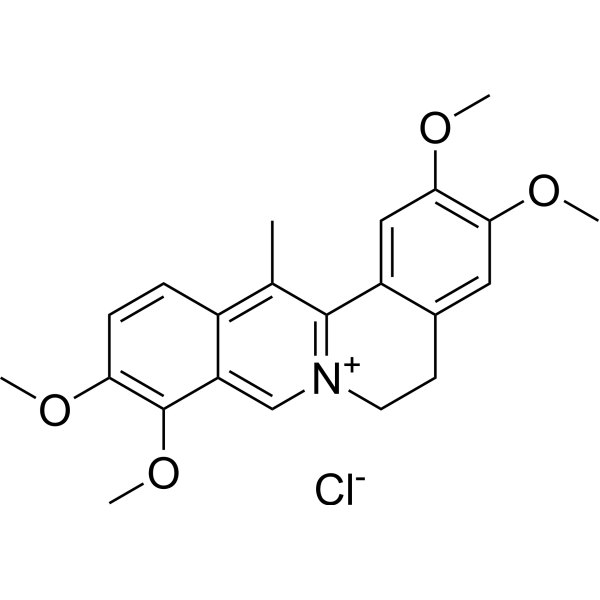
- HY-B0094S3
-
|
Qinghaosu-13C,d4; NSC 369397-13C,d4
|
Ferroptosis
Akt
Parasite
HCV
Isotope-Labeled Compounds
|
Infection
Neurological Disease
Cancer
|
|
Artemisinin- 13C,d4 is 13C and deuterated labeled Artemisinin (HY-B0094). Artemisinin (Qinghaosu), a sesquiterpene lactone, is an anti-malarial agent isolated from the aerial parts of Artemisia annua L. plants . Artemisinin inhibits AKT signaling pathway by decreasing pAKT in a dose-dependent manner. Artemisinin reduces cancer cell proliferation, migration, invasion, tumorigenesis and metastasis and has neuroprotective effects .
|
-

- HY-N0674
-
|
13-Methylpalmatine
|
Bcl-2 Family
Caspase
PARP
p38 MAPK
Parasite
Autophagy
|
Infection
Cancer
|
|
Dehydrocorydaline (13-Methylpalmatine) is an alkaloid that regulates protein expression of Bax, Bcl-2; activates caspase-7, caspase-8, and inactivates PARP . Dehydrocorydaline elevates p38 MAPK activation. Anti-inflammatory and anti-cancer activities . Dehydrocorydaline shows strong anti-malarial effects (IC50=38 nM), and low cytotoxicity (cell viability > 90%) using P. falciparum 3D7 strain .
|
-

- HY-N0498
-
|
|
Parasite
Apoptosis
STAT
Topoisomerase
ERK
FAK
p38 MAPK
NF-κB
|
Inflammation/Immunology
Cancer
|
|
Nitidine chloride, a potential anti-malarial lead compound derived from Zanthoxylum nitidum (Roxb) DC, exerts potent anticancer activity through diverse pathways, including inducing apoptosis, inhibiting STAT3 signaling cascade, DNA topoisomerase 1 and 2A, ERK and c-Src/FAK associated signaling pathway. Nitidine chloride inhibits LPS-induced inflammatory cytokines production via MAPK and NF-kB pathway .
|
-
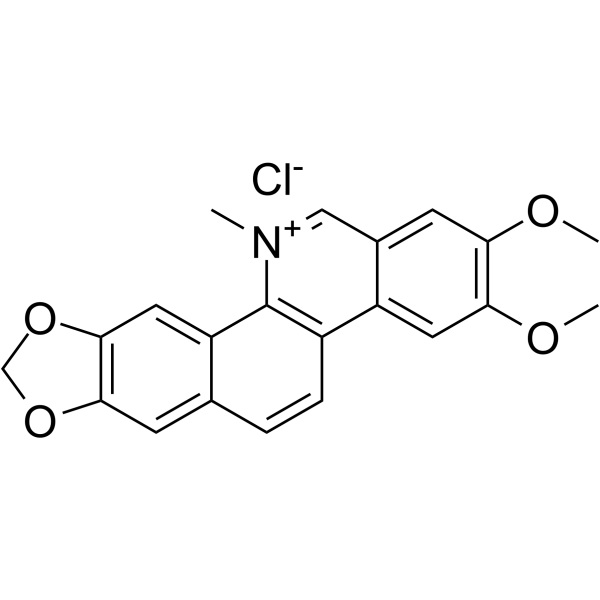
- HY-N0674B
-
|
13-Methylpalmatine (hydroxyl)
|
Bcl-2 Family
Caspase
PARP
p38 MAPK
Parasite
Autophagy
|
Infection
Inflammation/Immunology
Cancer
|
|
Dehydrocorydaline (13-Methylpalmatine) hydroxyl is an alkaloid that regulates protein expression of Bax, Bcl-2; activates caspase-7, caspase-8, and inactivates PARP. Dehydrocorydaline hydroxyl elevates p38 MAPK activation. Anti-inflammatory and anti-cancer activities. Dehydrocorydaline hydroxyl shows strong anti-malarial effects (IC50=38 nM), and low cytotoxicity (cell viability > 90%) using P. falciparum 3D7 strain.
|
-
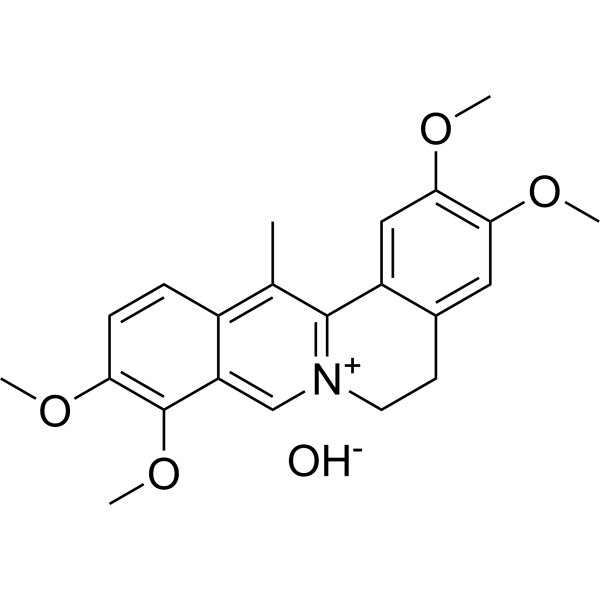
- HY-N4238
-
|
13-Methylpalmatine nitrate
|
Bcl-2 Family
Caspase
PARP
p38 MAPK
Parasite
Autophagy
|
Infection
Cancer
|
|
Dehydrocorydaline nitrate (13-Methylpalmatine nitrate) is an alkaloid. Dehydrocorydaline regulates protein expression of Bax, Bcl-2; activates caspase-7, caspase-8, and inactivates PARP . Dehydrocorydaline nitrate elevates p38 MAPK activation. Anti-inflammatory and anti-cancer activities. . Dehydrocorydaline nitrate shows strong anti-malarial effects (IC50 =38 nM), and low cytotoxicity (cell viability > 90%) using P. falciparum 3D7 strain .
|
-
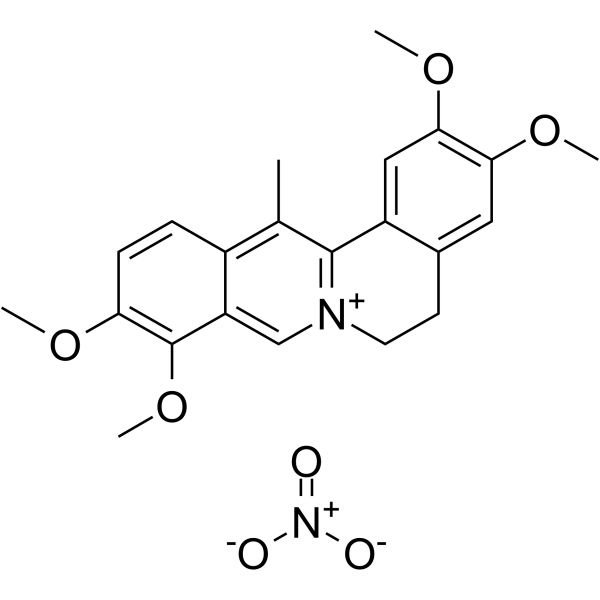
- HY-B1896A
-
|
|
Parasite
|
Infection
|
|
Piperaquine phosphate is a bisquinoline antimalarial agent. Piperaquine phosphate can be used in antimalarial research in combination with Artemisinin .
|
-
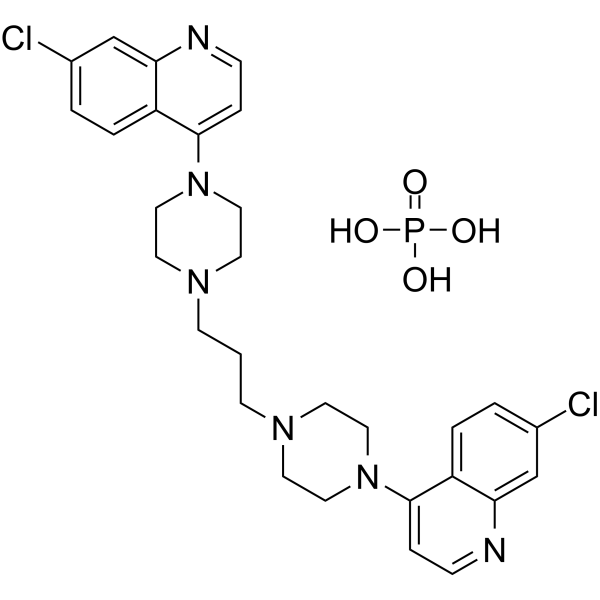
- HY-B1896
-
|
|
Parasite
|
Infection
|
|
Piperaquine is a bisquinoline antimalarial agent. Piperaquine can be used in antimalarial research in combination with Artemisinin .
|
-
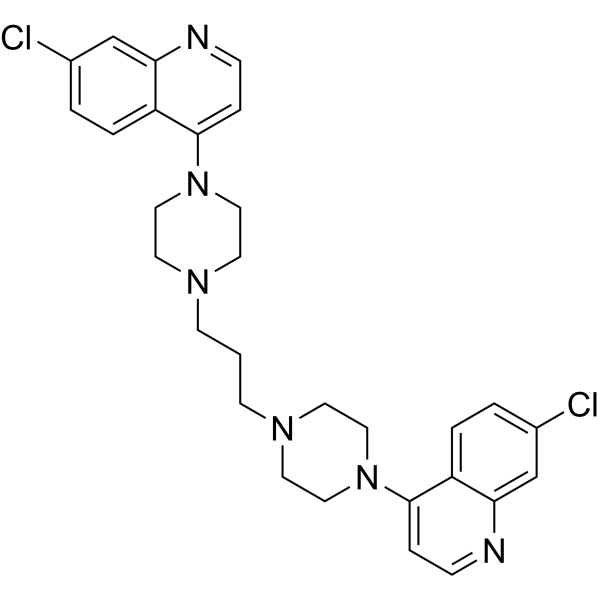
- HY-B1896B
-
|
|
Parasite
|
Infection
|
|
Piperaquine tetraphosphate tetrahydrate is a bisquinoline antimalarial agent. Piperaquine tetraphosphate tetrahydrate can be used in antimalarial research in combination with Artemisinin .
|
-
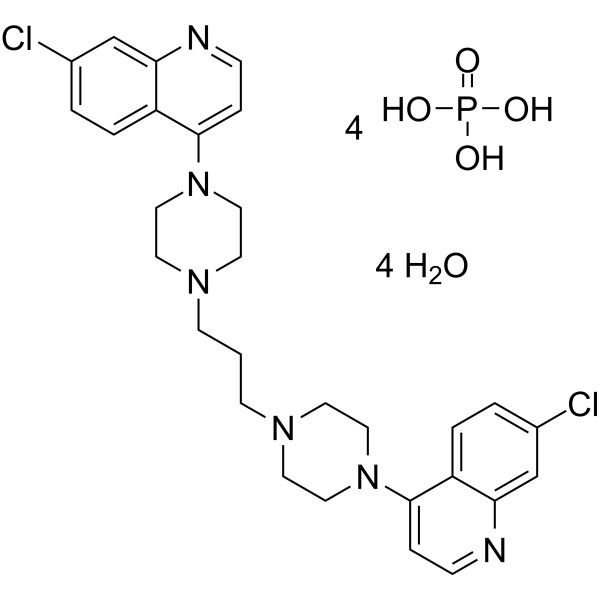
- HY-B1896S
-
|
|
Parasite
|
Infection
|
|
Piperaquine-d6 is the deuterium labeled Piperaquine[1]. Piperaquine is a bisquinoline antimalarial agent. Piperaquine can be used in antimalarial research in combination with Artemisinin[2][3].
|
-
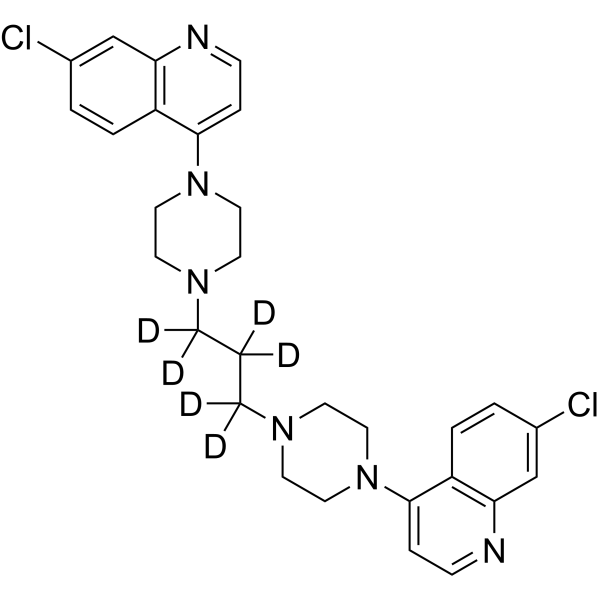
- HY-118865S
-
|
|
Isotope-Labeled Compounds
Parasite
|
Infection
|
|
Piperaquine-d6 (tetraphosphate) is the deuterium labeled Piperaquine tetraphosphate. Piperaquine tetraphosphate is a bisquinoline antimalarial agent. Piperaquine phosphate can be used in antimalarial research in combination with Artemisinin[1][2].
|
-

- HY-N3957
-
|
|
Parasite
|
Infection
|
|
1-(26-Hydroxyhexacosanoyl)-glycerol is a potent antimalarial agent. 1-(26-Hydroxyhexacosanoyl)-glycerol shows antimalarial activity with an IC50 value of 9.48 µM for Plasmodium falciparum .
|
-

- HY-B0803
-
-
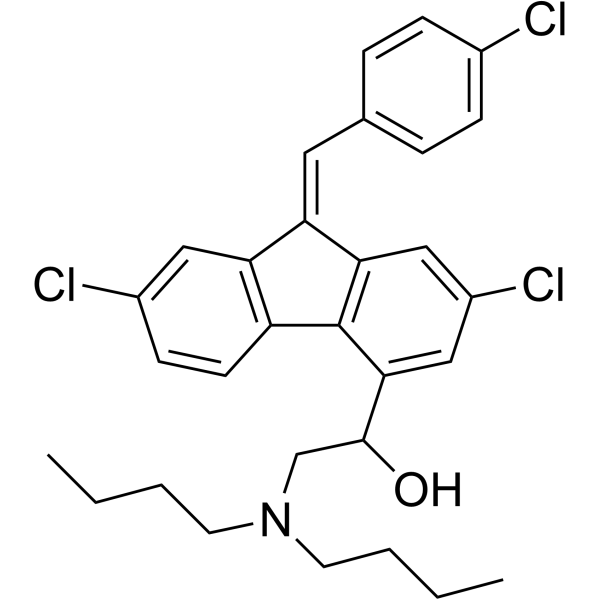
- HY-137217
-
-

- HY-12781
-
|
Desbutyl-benflumetol
|
Drug Metabolite
|
Infection
|
|
Desbutyl Lumefantrine is a metabolite of lumefantrine with antimalarial activity .
|
-
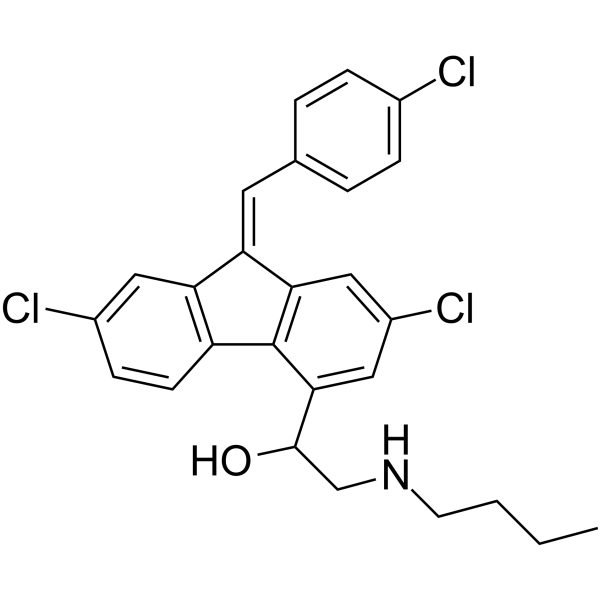
- HY-118494
-
|
|
Parasite
|
Infection
|
|
Ascaridole is an anthelmintic and also has antimalarial activity .
|
-
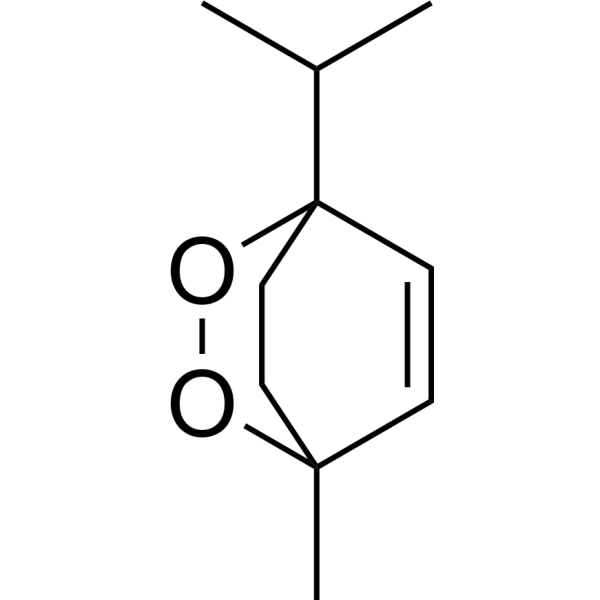
- HY-N4106
-
|
Dihydroqinghao acid
|
Parasite
Ferroptosis
|
Infection
|
|
Dihydroartemisinic acid (Dihydroqinghao acid) is a biosynthetic precursor to the antimalarial agent Artemisinin .
|
-
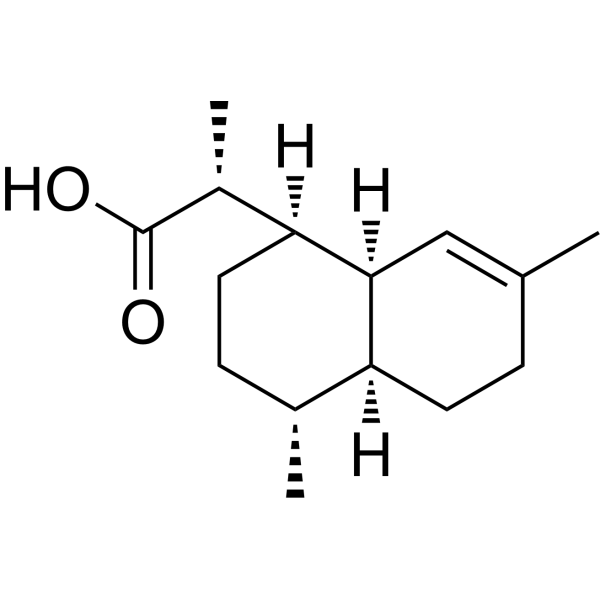
- HY-W738358
-
|
|
Parasite
|
Infection
|
|
Chlorproguanil (hydrochloride) is an antimalarial drug. Chlorproguanil (hydrochloride) is a dichloro-derivative of chloroguanide .
|
-

- HY-P10338
-
-

- HY-B0803S
-
-

- HY-A0130
-
|
Sulfametopyrazine; AS-18908
|
Parasite
Bacterial
Antibiotic
|
Infection
|
|
Sulfalene (Sulfametopyrazine) is an antimalarial agent. Sulfalene is also a long-acting sulfonamide antibacterial.
|
-

- HY-148315
-
|
|
GLUT
|
Infection
|
|
GLUT1-IN-2 (compound 17) is a GLUT1 inhibitor with an IC50 value of 12 μM. GLUT1-IN-2 shows inhibitory effect to Plasmodium falciparum hexose transporter PfHT with an IC50 value of 13 μM. GLUT1-IN-2 can be used for the research of infection .
|
-
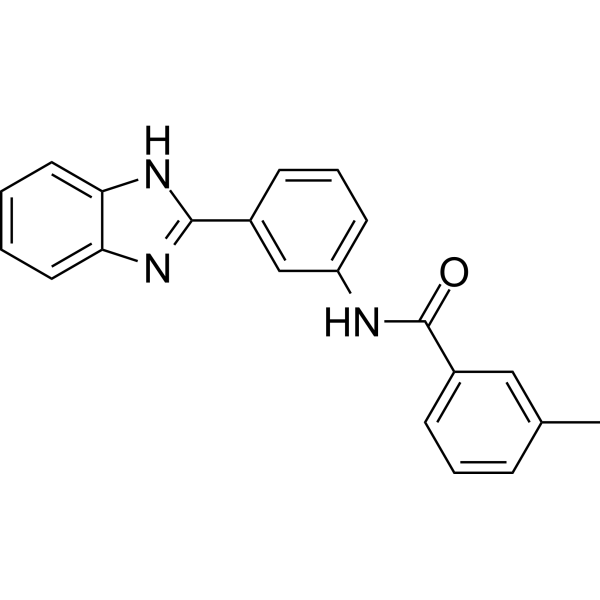
- HY-B0806S
-
|
|
Parasite
|
Infection
|
|
Proguanil-d6 is the deuterium labeled Proguanil, which is a prophylactic antimalarial agent.
|
-
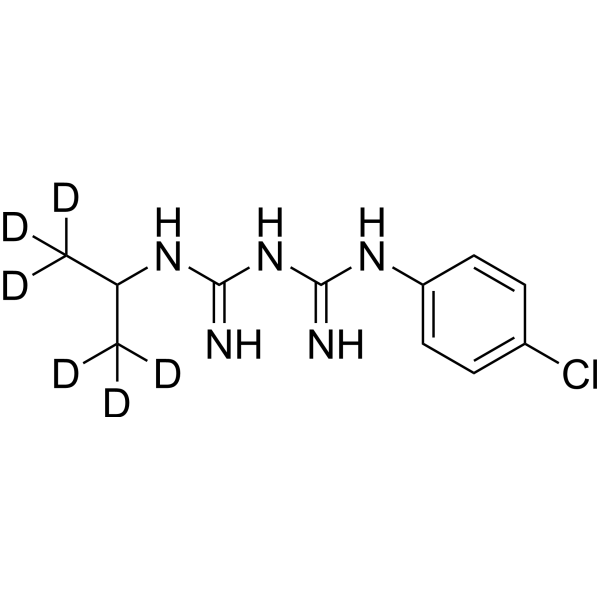
- HY-N2384
-
|
|
Parasite
|
Infection
|
|
Febrifugine is a quinazolinone alkaloid found in the roots and leaves of Dichroa febrifuga, with antimalarial activity .
|
-
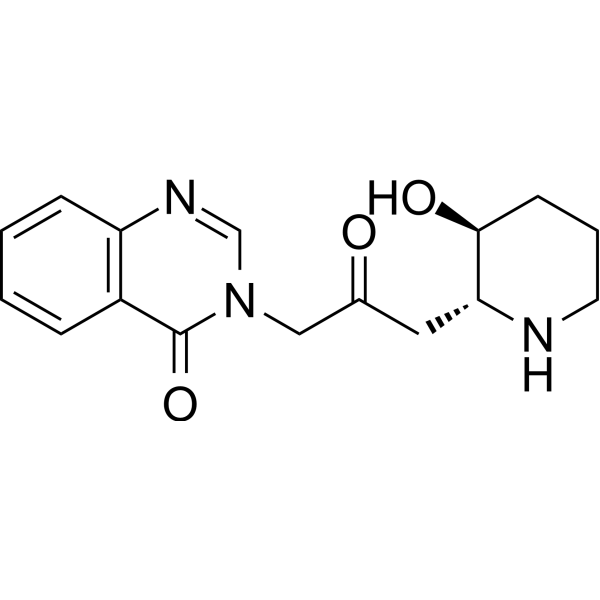
- HY-N2384A
-
|
|
Parasite
|
Infection
|
|
Febrifugine dihydrochloride is a quinazolinone alkaloid found in the roots and leaves of Dichroa febrifuga, with antimalarial activity .
|
-
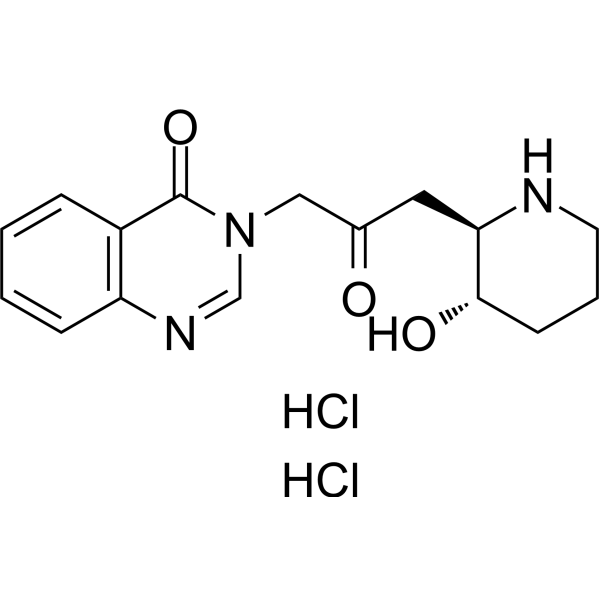
- HY-B0273
-
-
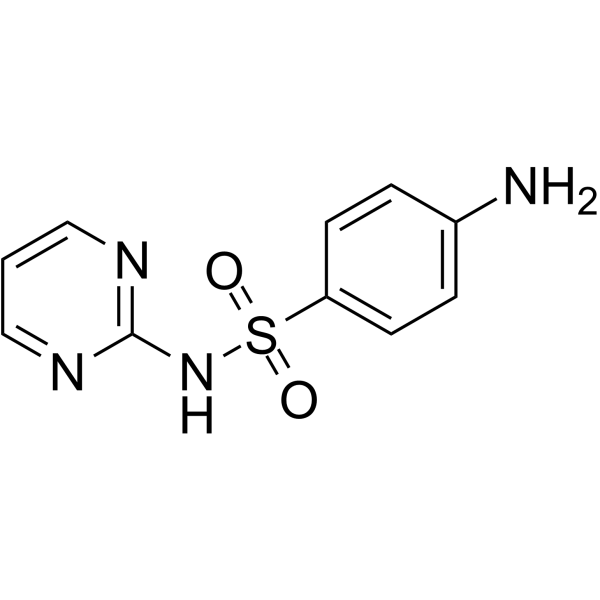
- HY-100033
-
|
RE-640
|
Parasite
|
Infection
Cancer
|
|
NSC5844 (RE-640) is a 4-aminoquinoline derivative, with antitumor and antimalarial activity.
|
-
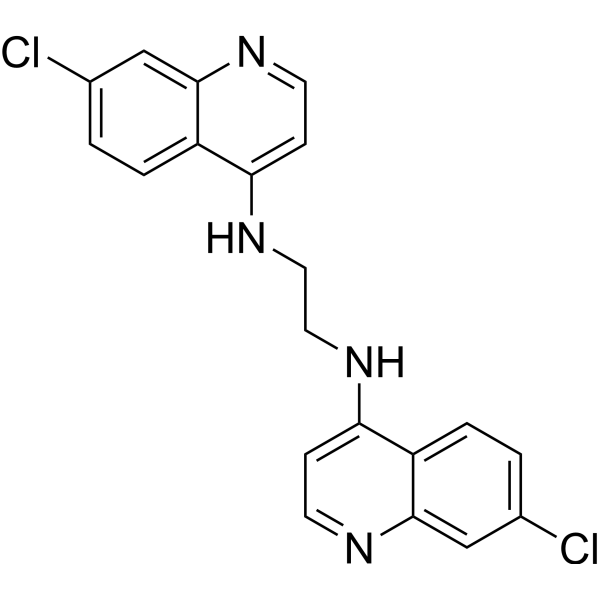
- HY-14430
-
|
NITD609; KAE609
|
Parasite
|
Infection
|
|
Cipargamin (NITD609) is an potent antimalarial compound, with an IC50 of appr 1 nM against P. falciparum.
|
-
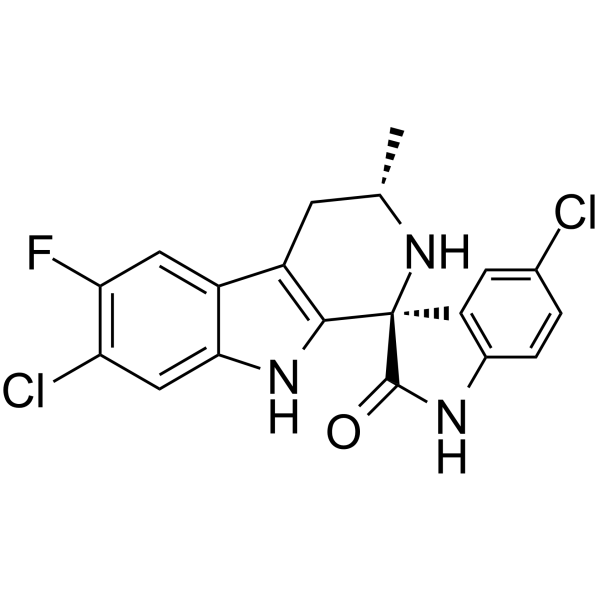
- HY-N0352
-
|
|
Parasite
|
Infection
|
|
Tuberostemonine, an alkaloid, is an antimalarial agent that targets Plasmodium falciparum ferredoxin-NADP + reductases (pfFNR) .
|
-
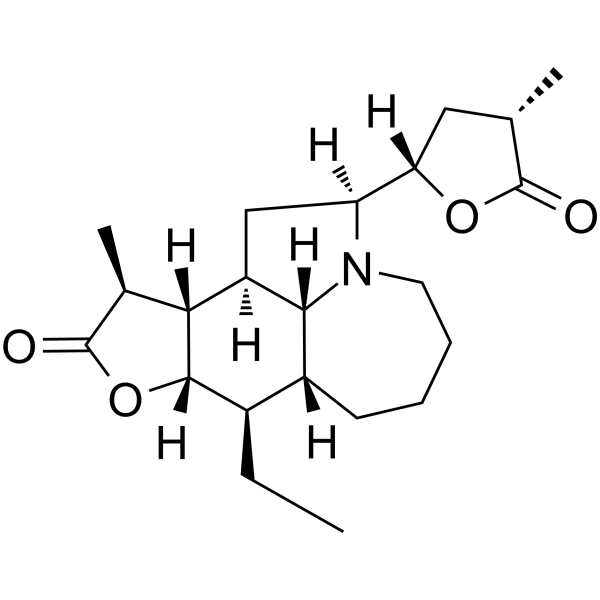
- HY-B0273A
-
-

- HY-N12276
-
-

- HY-W072459
-
-

- HY-100358
-
|
|
Parasite
|
Infection
|
|
AQ-13 dihydrochloride is an aminoquinoline antimalarial agent that is effective against drug-resistant strains of Plasmodium falciparum.
|
-
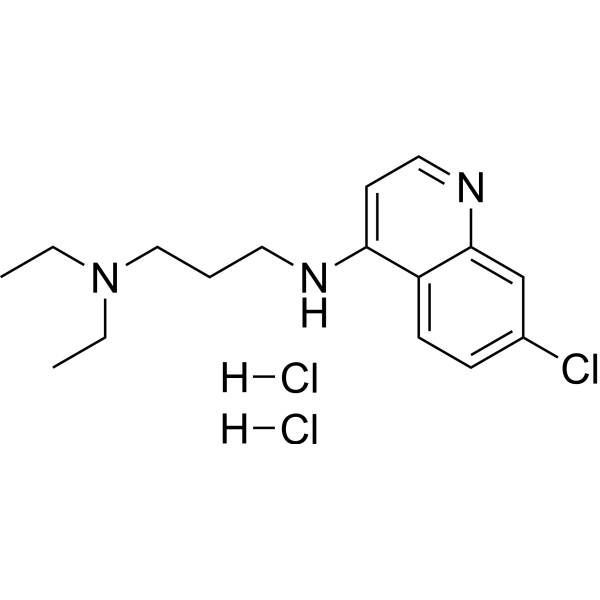
- HY-N5029
-
|
|
Parasite
|
Infection
|
|
Isofebrifugine is a natural quinazolinone alkaloid with important physiological activities and good pharmacological effects. Antimalarial effect .
|
-
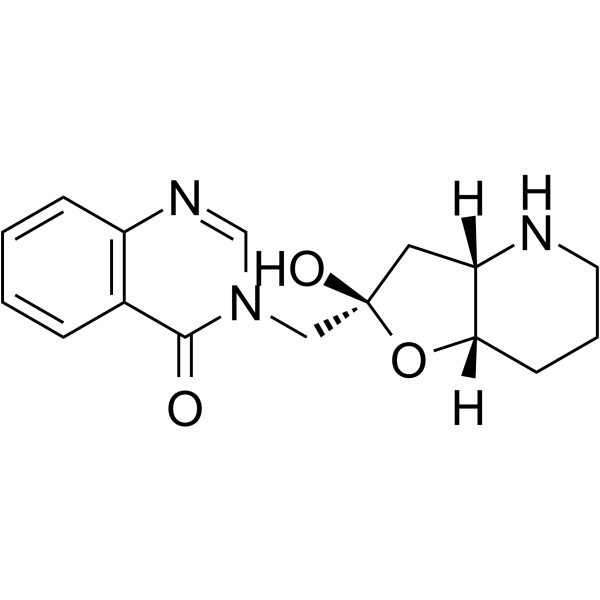
- HY-N1075
-
|
|
Parasite
|
Infection
|
|
Walsuronoid B is a limonoid can be isolated from Walsura robusta and has weak antimalarial activity .
|
-
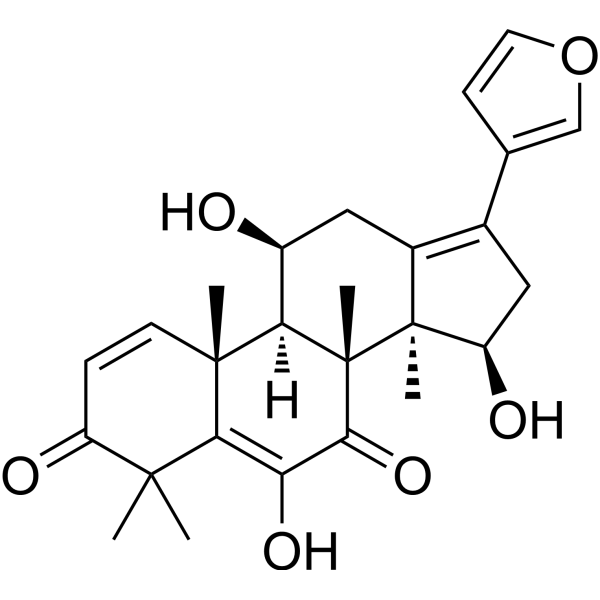
- HY-12082A
-
|
|
Potassium Channel
Parasite
|
Infection
|
|
GSK369796 Dihydrochloride is an affordable and effective antimalarial and inhibits hERG potassium ion channel repolarization with an IC50 of 7.5 μM.
|
-
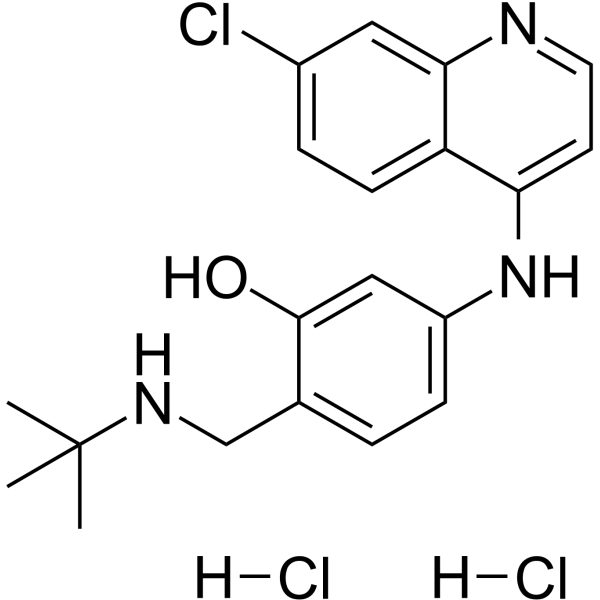
- HY-112853
-
|
FR-31564
|
Bacterial
Antibiotic
|
Infection
|
|
Fosmidomycin sodium salt is a phosphonic acid antibiotic and a antimalarial agent, which is active against both Gram-negative and Gram-positive bacteria.
|
-
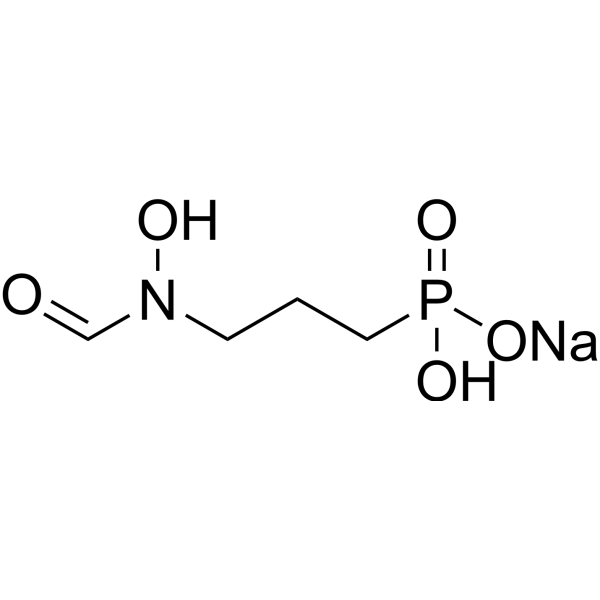
- HY-N0402S
-
|
Dihydroqinghaosu methyl ether-d3; Dihydroartemisinin methyl ether-d3; SM224-d3
|
Isotope-Labeled Compounds
Parasite
|
Infection
Cancer
|
|
Artemether-d3 is the deuterium labeled Artemether. Artemether is an antimalarial for the treatment of resistant strains of falciparum malaria.
|
-

- HY-10852
-
|
OZ 277; RBx 11160
|
Parasite
|
Infection
|
|
Arterolane is an antimalarial agent, with IC50 of both 1.1 nM against P. falciparum Ro73 and W2, respectively.
|
-
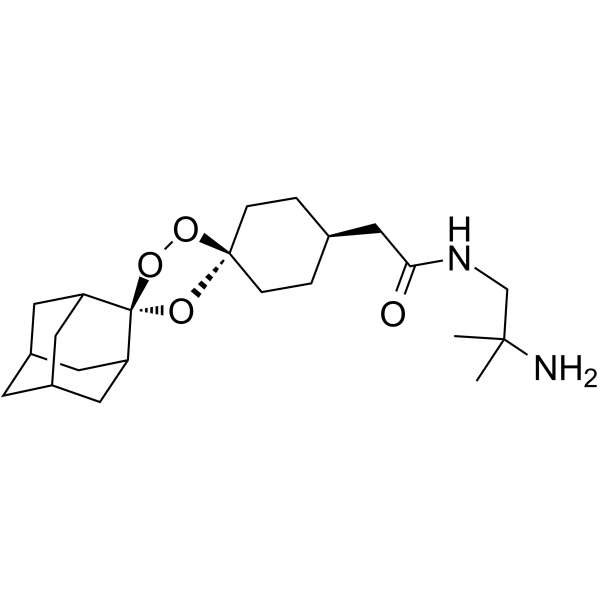
- HY-100662
-
|
Bisdesethylchloroquine
|
Drug Metabolite
|
Cardiovascular Disease
|
|
Didesethyl chloroquine (Bisdesethylchloroquine) is a major metabolite of the antimalarial agent Chloroquine. Didesethyl chloroquine is a potent myocardial depressant .
|
-

- HY-W007771
-
|
|
Bacterial
|
Infection
Cancer
|
|
Acridone is an organic compound based on the acridine skeleton. Acridone has antibacterial, antimalarial, antiviral and anti neoplastic activities .
|
-
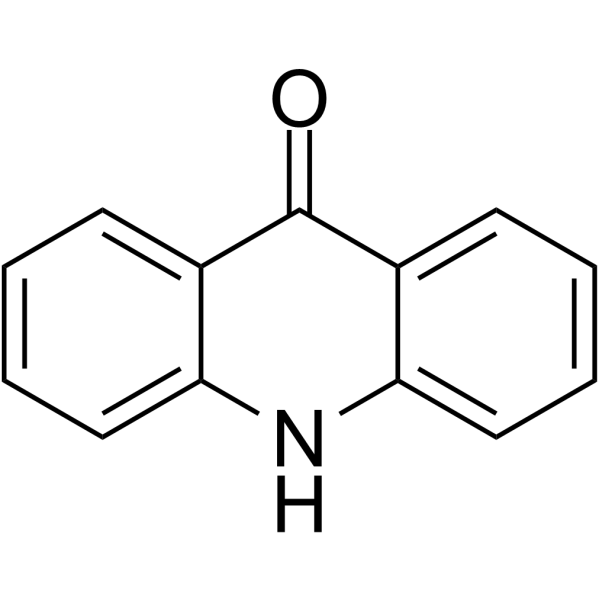
- HY-157794
-
|
|
Parasite
|
Infection
|
|
6-Nitroquinazoline is an antimalarial agent. 6-Nitroquinazoline is also a substrate for human liver aldehyde oxidase .
|
-

- HY-B0806
-
|
|
Parasite
Antifolate
|
Infection
|
|
Proguanil, an antimalarial proagent, is metabolized to the active metabolite Cycloguanil (HY-12784). Proguanil is a dihydrofolate reductase (DHFR) inhibitor .
|
-
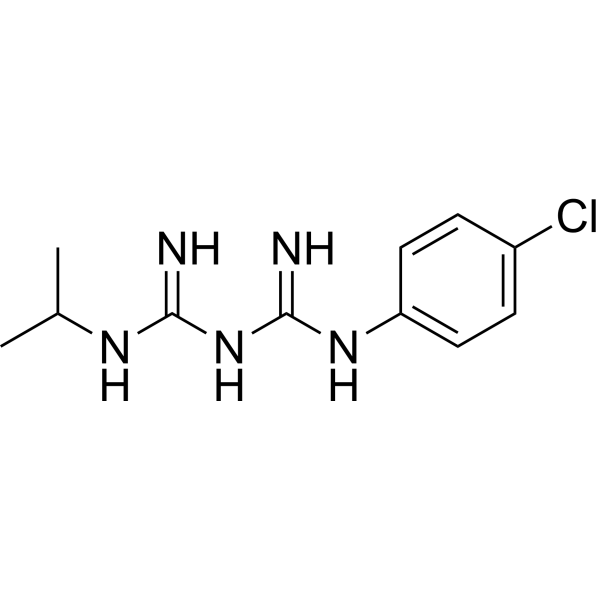
- HY-B0806A
-
|
|
Parasite
Antifolate
|
Infection
|
|
Proguanil hydrochloride, an antimalarial proagent, is metabolized to the active metabolite Cycloguanil (HY-12784). Proguanil hydrochloride is a dihydrofolate reductase (DHFR) inhibitor .
|
-
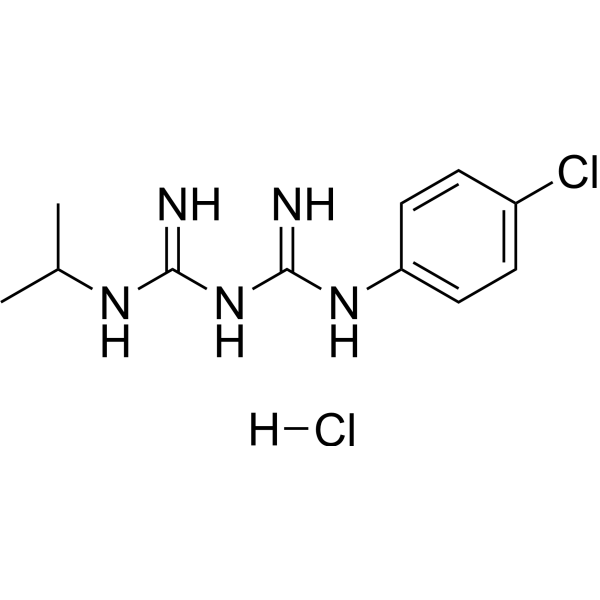
- HY-121002
-
-

- HY-N0176A
-
|
α-Dihydroqinghaosu; α-Artenimol
|
Parasite
|
Infection
|
|
α-Dihydroartemisinin is a natural product that can be found in artemisinin. α-Dihydroartemisinin also shows antimalarial activity .
|
-
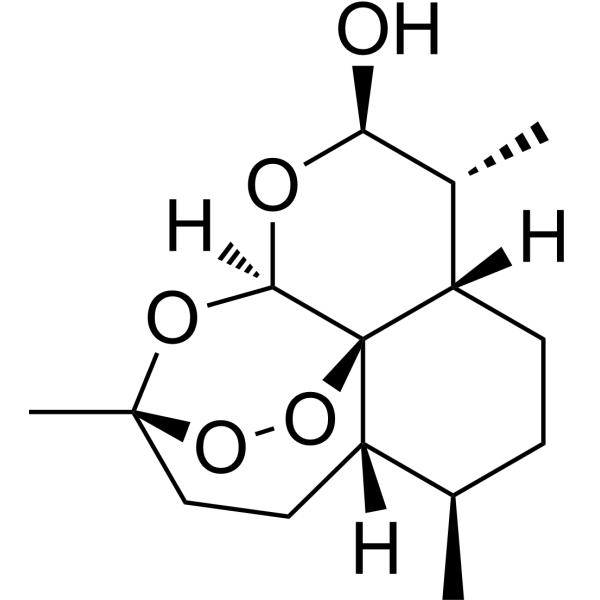
- HY-124301
-
|
|
Bacterial
|
Infection
|
|
Penicolinate A is a picolinic acid derivative. Penicolinate A is isolated from endophytic Penicillium sp. BCC16054. Penicolinate A exhibits antimalarial and antitubercular activities .
|
-

- HY-B0273S1
-
-
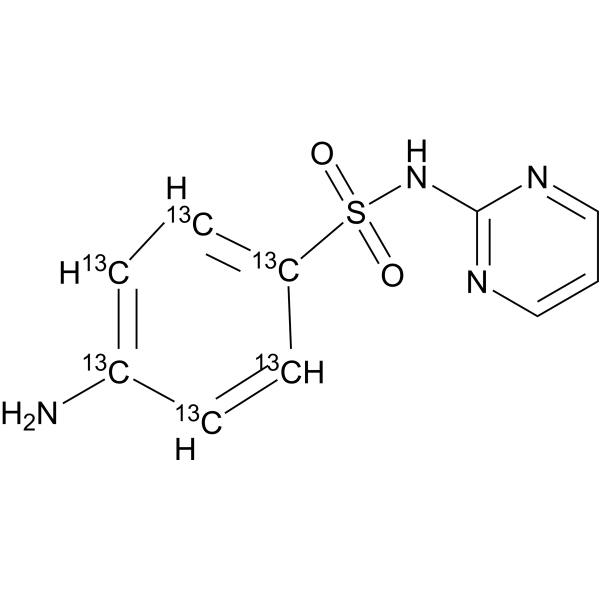
- HY-101672
-
|
FBS 0701
|
Ferroptosis
Parasite
|
Infection
|
|
Deferitazole (FBS 0701) is an orally active iron chelator. Deferitazole shows antimalarial activity and
Can be used for study of malaria .
|
-

- HY-151568
-
|
|
Parasite
|
Infection
|
|
UCB7362 is an orally active and potent antimalarial plasmepsin X (PMX) inhibitor, with an IC50 of 7 nM. UCB7362 inhibits parasite growth .
|
-

- HY-13833
-
|
|
Parasite
|
Infection
|
|
Endochin is an antimalarial agent. Endochin inhibits T.gondii with an IC50 of 0.003 nM. Endochin is also active against experimental toxoplasmosis .
|
-
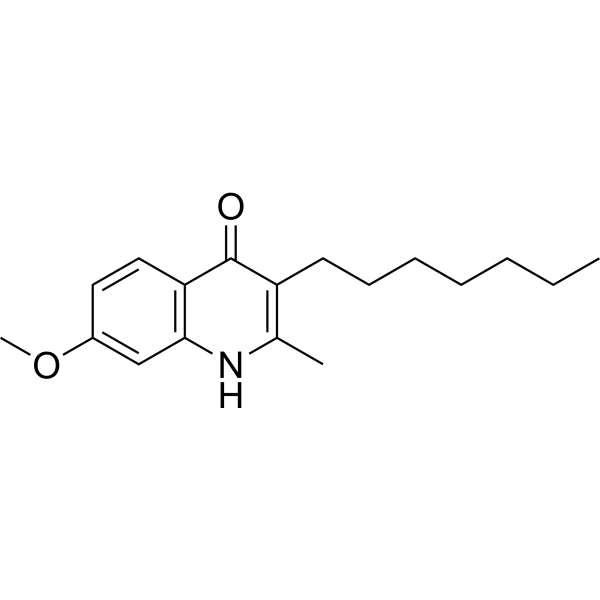
- HY-19364
-
|
Ferrochloroquine; SSR97193
|
Parasite
|
Infection
|
|
Ferroquine (Ferrochloroquine), a ferrocenyl analogue of Chloroquine, is an antimalarial agent. Ferroquine shows parasiticidal effect on Plasmodium by inducing oxidative stress and the subsequent destruction of the membrane .
|
-

- HY-141621
-
|
|
Parasite
Drug Metabolite
|
Infection
|
|
ACT-606559, a new chemical entity with antimalarial activity, is a metabolite of ACT451840. ACT-606559 can be used for the research of malarial .
|
-

- HY-161384
-
|
|
Parasite
|
Infection
|
|
WJM-715 is an antimalarial agent with an EC50 of 0.015 μM by trageting STAR-related lipid transfer protein (PfSTART1) with a KD of 14 nM .
|
-
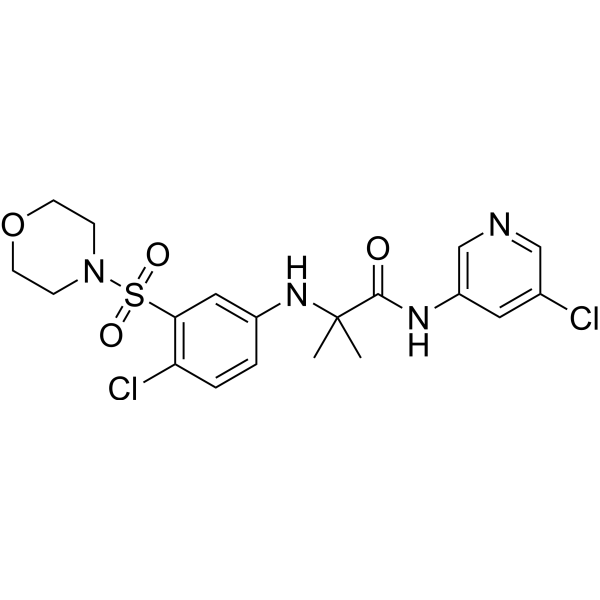
- HY-N7190
-
|
|
Parasite
|
Cancer
|
|
Yadanzioside F is one of the toxic components found in Brucea javanica . Brucea javanica has demonstrated a variety of antitumoral, antimalarial, and anti-inflammatory properties .
|
-
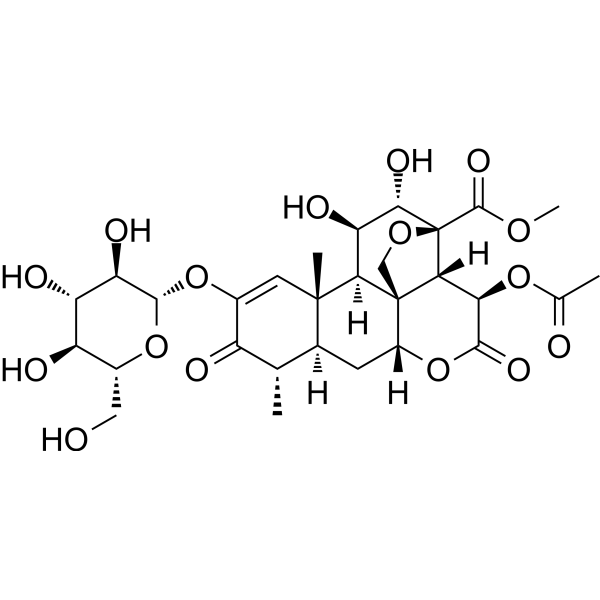
- HY-N9438
-
-

- HY-A0130R
-
|
|
Parasite
Bacterial
Antibiotic
|
Infection
|
|
Sulfalene (Standard) is the analytical standard of Sulfalene. This product is intended for research and analytical applications. Sulfalene (Sulfametopyrazine) is an antimalarial agent. Sulfalene is also a long-acting sulfonamide antibacterial.
|
-

- HY-N7634
-
|
|
Farnesyl Transferase
Parasite
|
Infection
Cancer
|
|
Tectol, isolated from Lippia sidoides, exhibits significant activity against human leukemia cell lines HL60 and CEM . Tectol is a farnesyltransferase (FTase) inhibitor with IC50s of 2.09 and 1.73 μM for human and T. brucei FTase, respectively. Tectol inhibits drug-resistant strain of P. falciparum (FcB1) with an IC50 of 3.44 μM .
|
-

- HY-17036
-
|
|
Parasite
|
Infection
|
|
Naphthoquine phosphate is a potent and orally active antimalarial agent. Naphthoquine phosphate has thorough killing function for various schizonts of plasmodia, including resistance of P. falciparum to Chloroquine .
|
-
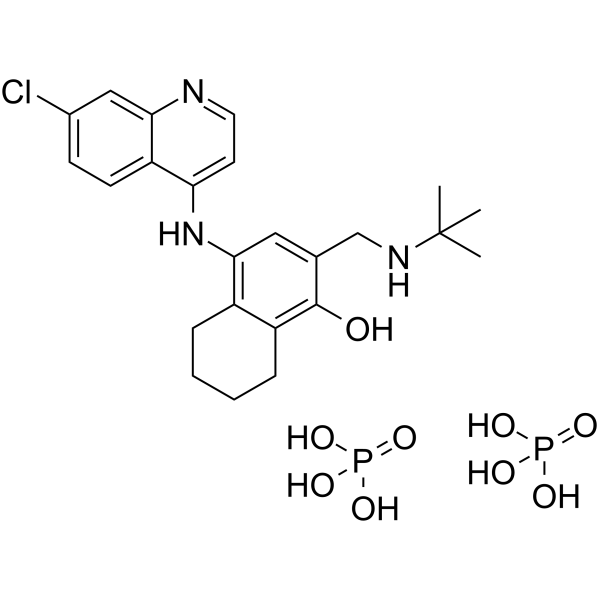
- HY-136448
-
|
|
Parasite
|
Infection
|
|
SJ000025081 is a dihydropyridine and acts as a potent antimalarial agent. SJ000025081 results in an obvious suppression of the parasitemia in a murine malaria model infected with P. yoelii .
|
-
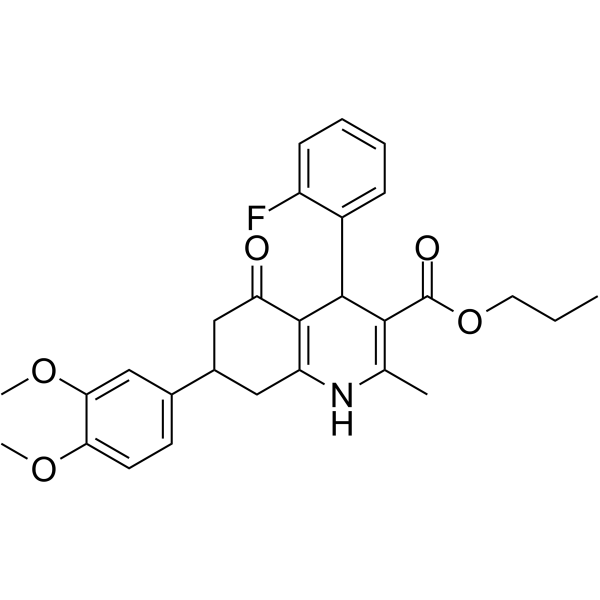
- HY-144298
-
|
|
Parasite
HDAC
|
Infection
|
|
HDAC1-IN-4 (JX34) is a potent Plasmodium falciparum HDAC1 inhibitor shows antimalarial activity (IC50 < 5 nM) and lower cytotoxicity .
|
-
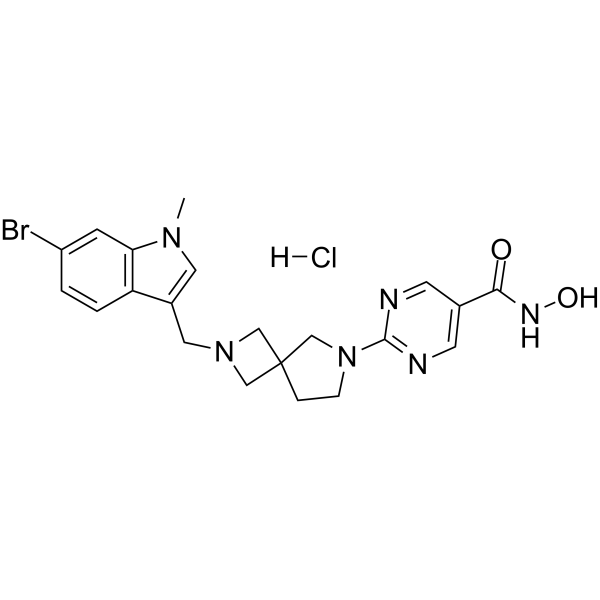
- HY-A0130S
-
-
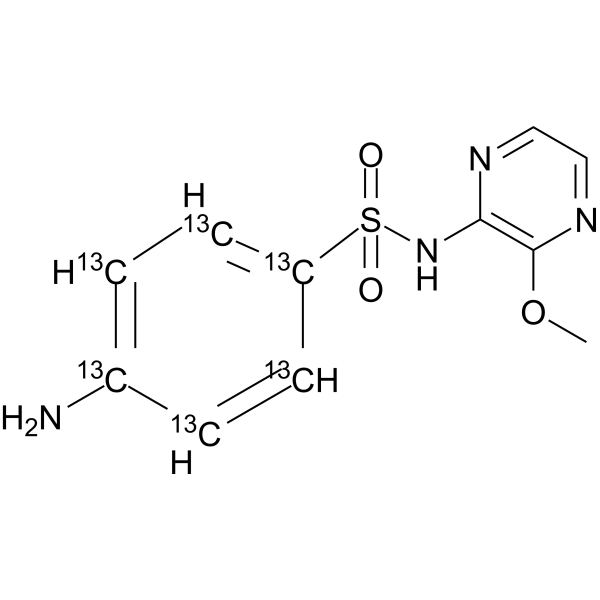
- HY-160675
-
|
|
Parasite
|
Infection
|
|
TCMDC-137332 is a compound that exhibits antimalarial activity against Plasmodium falciparum with an IC50 value of 7 nM. TCMDC-137332 can be utilized for the research of malaria .
|
-

- HY-N7314
-
|
|
Syk
|
Inflammation/Immunology
|
|
Asebogenin has antimalarial activity in vitro . Asebogenin can inhibit the phosphorylation of Syk, thereby effectively suppressing platelet activation and the formation of neutrophil extracellular traps .
|
-

- HY-N0941
-
|
β-Mangostin
|
Bacterial
Parasite
Apoptosis
|
Infection
Cancer
|
|
beta-Mangostin (β-Mangostin) is a xanthone compound present in Cratoxylum arborescens, with antibacterial and antimalarial activities. beta-Mangostin exhibits antimycobacterial activity against Mycobacterium tuberculosis with an MIC of 6.25 μg/mL. beta-Mangostin possesses in vitro antimalarial activity against Plasmodium falciparum, with an IC50 of 3.00 μg/mL. beta-Mangostin has potent anticancer activity against various cancers (such as hepatocellular carcinoma, leukaemic) .
|
-

- HY-13836
-
|
|
Parasite
|
Infection
|
|
ELQ-300 is a potent and orally bioavailable antimalarial agent, acts as an inhibitor of the reductive (Qi) site of the cytochrome bc1 complex (cyt bc1). ELQ-300 inhibits growth of P. falciparum Dd2, Tm90-C2B, and D1 with IC50 values of 6.6, 4.6 and 160 nM, respectively. ELQ-300 can be used for the research of antimalarial .
|
-

- HY-19502
-
|
Artemifone; BAY 44-9585
|
Parasite
CMV
|
Infection
|
|
Artemisone (Artemifone) is a potent and semi-synthetic antimalarial, inhibits P. falciparum strains, with a mean IC50 of 0.83 nM . Artemisone is also a potent inhibitor of human CMV .
|
-
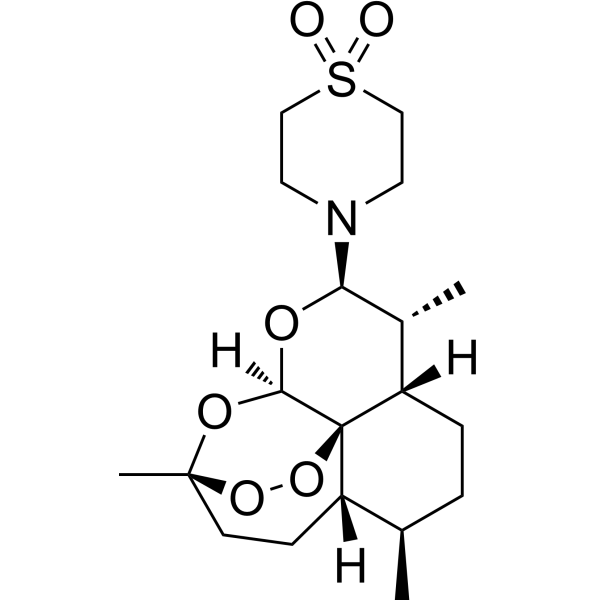
- HY-A0148
-
|
SKF-102886 free base; WR-171669
|
Parasite
Potassium Channel
|
Infection
|
|
Halofantrine (SKF-102886 free base) is a highly lipophilic antimalarial active against Chloroquine-resistant strains of Plasmodium falciparum . Halofantrine blocks HERG potassium channels .
|
-

- HY-N2753
-
|
|
Parasite
|
Infection
|
|
7-Acetoxybonducellpin C, a diterpenoid, is a nature product that could be isolated from the seed kernels of Caesalpinia crista. 7-Acetoxybonducellpin C has antimalarial activity .
|
-
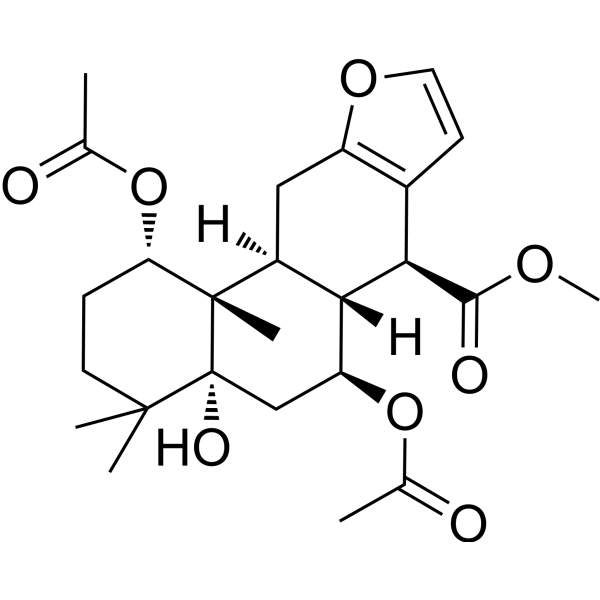
- HY-N7281
-
|
|
Acyltransferase
Parasite
|
Infection
|
|
Aphadilactone C is a potent and selective DGAT-1 inhibitor with an IC50 of 0.46 μM. Aphadilactone C shows significant antimalarial activities with an IC50 value of 170 nM .
|
-

- HY-N8338
-
|
|
Parasite
|
Infection
|
|
Pancixanthone A is a xanthone that can be isolated from Garcinia vieillardii. Pancixanthone A has antimalarial activity against chloroquino-resistant strains of Plasmodium falciparum with an IC50 of 1.6 μg/mL .
|
-

- HY-N8455
-
|
Assiguxanthone A
|
Parasite
|
Infection
|
|
Isocudraniaxanthone A is a xanthone that can be isolated from Garcinia vieillardii. Isocudraniaxanthone A has antimalarial activity against chloroquino-resistant strains of Plasmodium falciparum with an IC50 of 2.3 μg/mL .
|
-

- HY-A0148A
-
|
SKF-102886; WR-171669 hydrochloride
|
Parasite
|
Infection
|
|
Halofantrine hydrochloride (SKF-102886) is a blocker of delayed rectifier potassium current via the inhibition of human-ether-a-go-go-related gene (HERG) channel and a potent antimalarial compound .
|
-
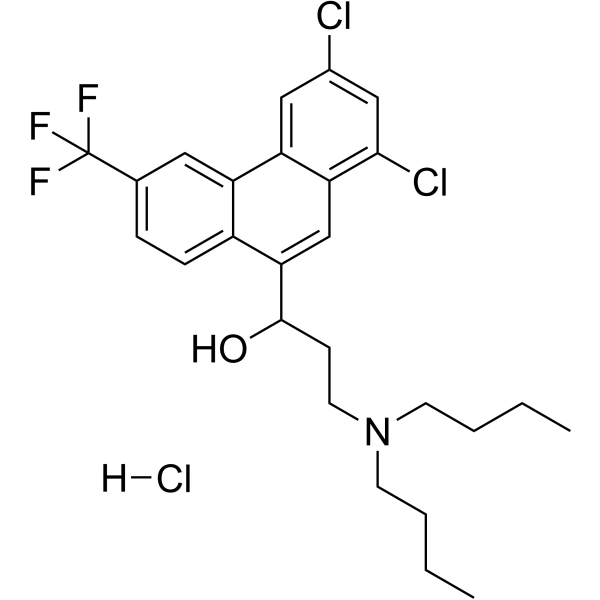
- HY-135847
-
|
SSR97213
|
Parasite
Drug Metabolite
|
Infection
|
|
Desmethyl ferroquine (SSR97213) is the active and major metabolite of Ferroquine. Ferroquine is an antimalarial. Desmethyl ferroquine shows significant activity against Chloroquine-susceptible and resistant P. falciparum strains .
|
-
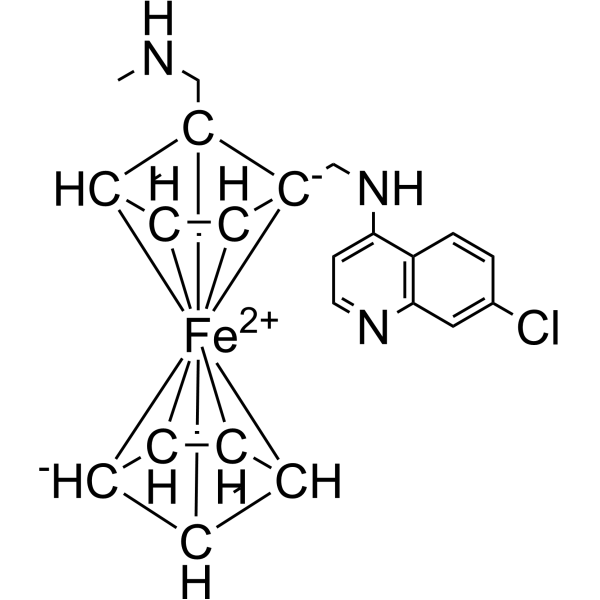
- HY-145964
-
|
|
Parasite
|
Infection
|
|
INE963 is a potent and fast-acting blood-stage antimalarial agent, with an EC50s of 3-6 nM. INE963 is potential for single-dose cures in uncomplicated malaria .
|
-
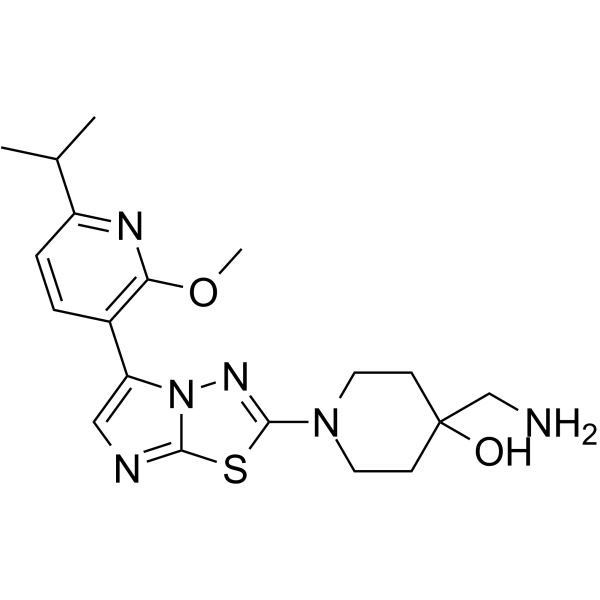
- HY-N12700
-
|
|
Parasite
|
Infection
|
|
Puberulic acid has antimalarial activity against Plasmodium falciparum K1 (chloroquine-resistant), IC50 value is 0.050 µM. Puberulic acid can be isolated from Penicillium viticola .
|
-

- HY-B0806AS
-
|
|
Isotope-Labeled Compounds
Parasite
Antifolate
|
Infection
|
|
Proguanil-d4 (hydrochloride) is the deuterium labeled Proguanil hydrochloride. Proguanil hydrochloride, an antimalarial proagent, is metabolized to the active metabolite Cycloguanil (HY-12784). Proguanil hydrochloride is a dihydrofolate reductase (DHFR) inhibitor[1][2].
|
-
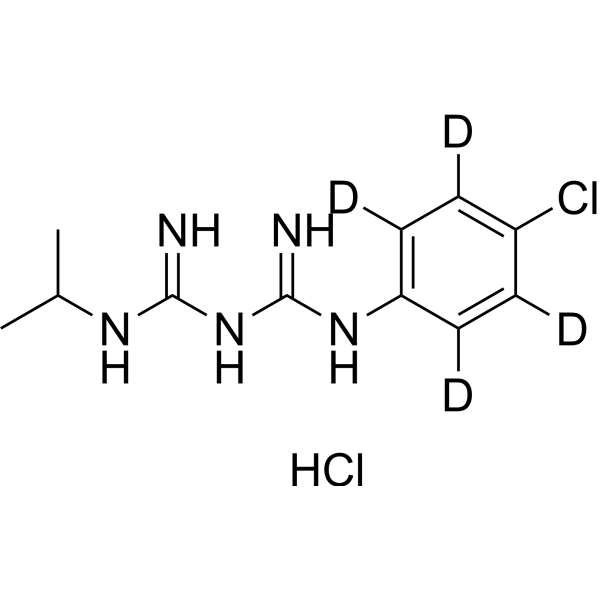
- HY-135578
-
|
|
Parasite
|
Infection
|
|
Artelinic acid, a derivative of Artemisinin, is an antimalarial agent for the treatment of multidrug resistant strains of Plasmodium falciparum. Artelinic acid can be administered by various routes of administration, including intravenous, intramuscular and oral routes .
|
-
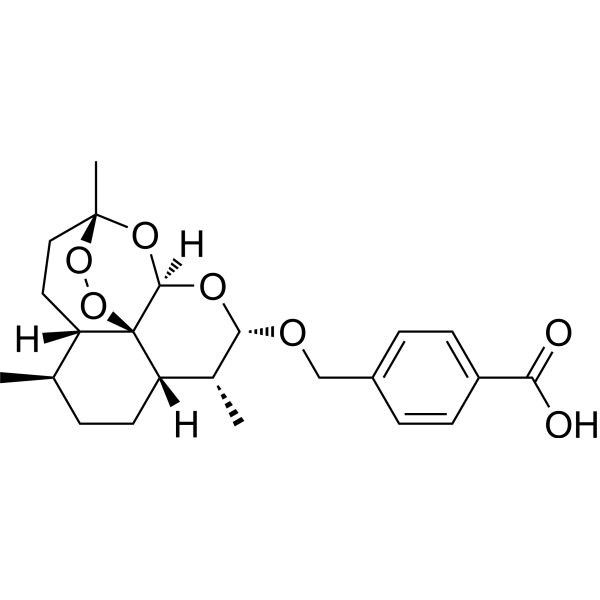
- HY-135648
-
-
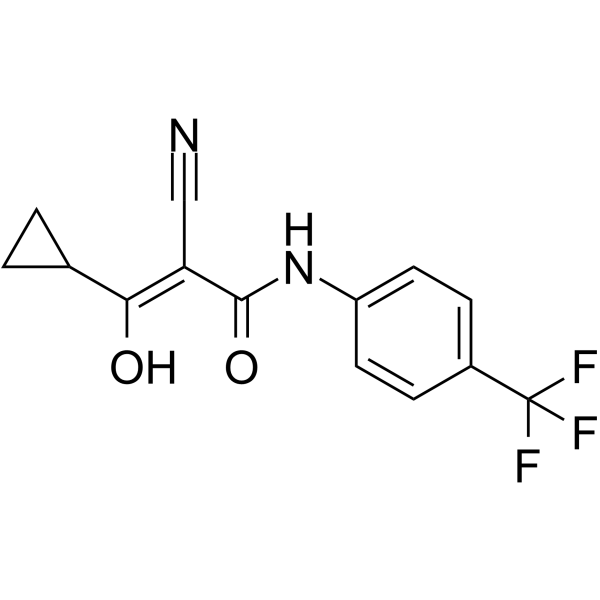
- HY-13735B
-
|
Mepacrine hydrochloride hydrate; SN-390 hydrochloride hydrate
|
Parasite
Apoptosis
Autophagy
Mitophagy
|
Infection
Cancer
|
|
Quinacrine hydrochloride hydrate (Mepacrine hydrochloride hydrate) is an antimalarial agent, which possess anticancer effect both in vitro and vivo. Quinacrine hydrochloride hydrate suppresses NF-κB and activates p53 signaling, which results in the induction of the apoptosis .
|
-

- HY-139672
-
|
|
Parasite
|
Infection
|
|
BRD5018 is an antimalarial agent. BRD5018 is a click chemistry reagent, it contains an Alkyne group and can undergo copper-catalyzed azide-alkyne cycloaddition (CuAAc) with molecules containing Azide groups.
|
-

- HY-N0978
-
|
|
Parasite
|
Infection
Metabolic Disease
|
|
1,2,3,19-Tetrahydroxy-12-ursen-28-oic acid is a Triterpenoid that isolated from the plant of Agrimonia Pilosa with antimalarial and antidiabetic activities .
|
-
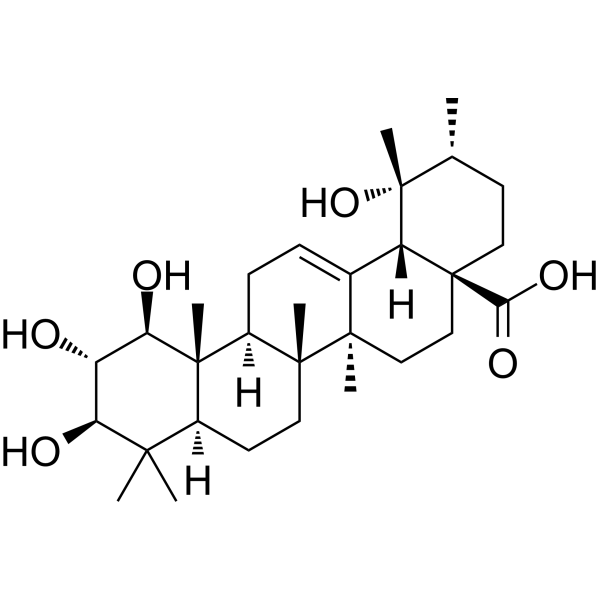
- HY-148177
-
|
ZY-19489; MMV 253; AZ13721412
|
Parasite
|
Infection
|
|
Sutidiazine (ZY-19489) is an orally active and antimalarial agent. Sutidiazine inhibits parasitemia-induced infection. Sutidiazine shows short half-lives (approximately 7 h) and an exposure effect .
|
-
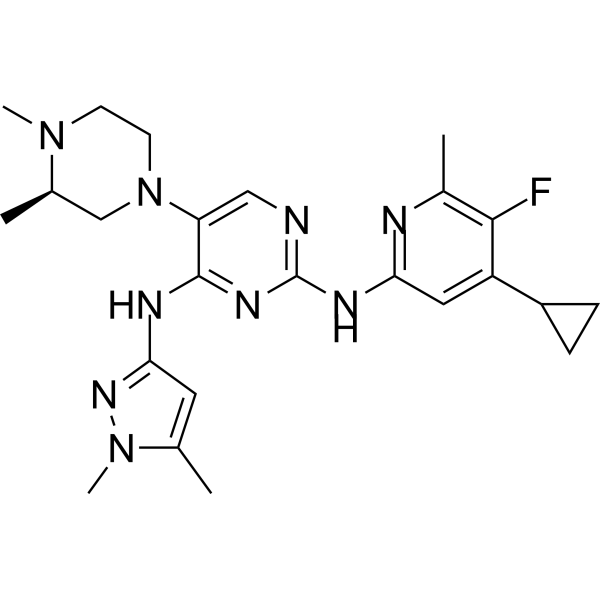
- HY-N2759
-
|
|
Bacterial
|
Infection
|
|
7-O-Isopentenyl-γ-fagarine is an alkaloid that can be isolated from Peltostigma guatemalense. 7-O-Isopentenyl-γ-fagarine has antibacterial and antimalarial activities in vitro .
|
-
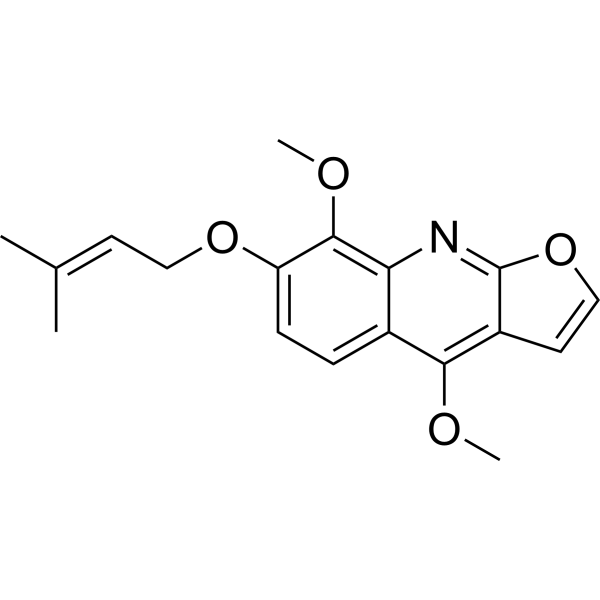
- HY-N8345
-
|
|
Others
|
Others
|
|
Isocudraniaxanthone B (compound 10) is a kind of xanthone. Isocudraniaxanthone B can be isolated from Calophyllum caledonicum. Isocudraniaxanthone B has antimalarial activity with an IC50 value of 3.2 μg/mL .
|
-
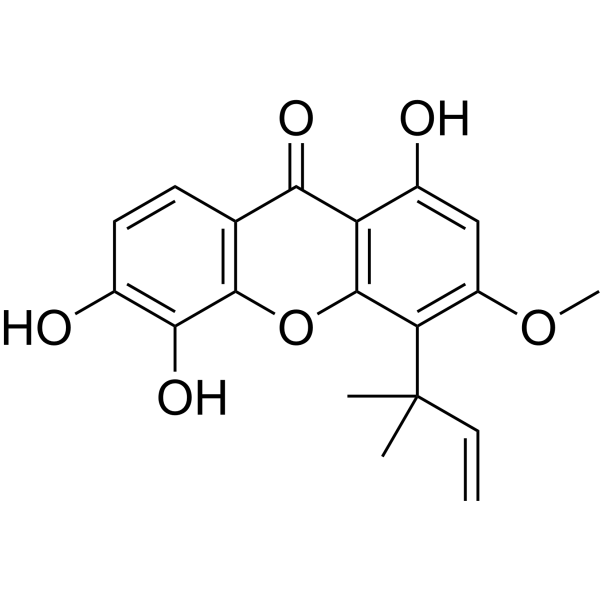
- HY-100662S
-
|
Bisdesethylchloroquine-d4
|
Isotope-Labeled Compounds
Drug Metabolite
|
Cardiovascular Disease
|
|
Didesethyl chloroquine-d4 is the deuterium labeled Didesethyl chloroquine. Didesethyl chloroquine (Bisdesethylchloroquine) is a major metabolite of the antimalarial agent Chloroquine. Didesethyl chloroquine is a potent myocardial depressant[1][2].
|
-
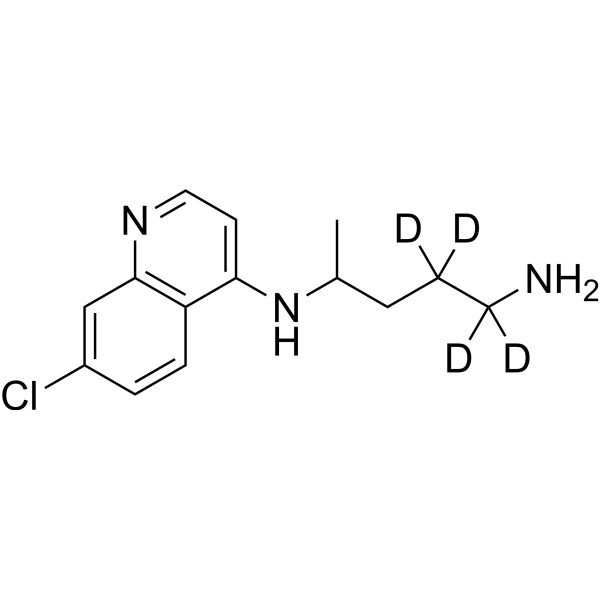
- HY-149289
-
|
|
Parasite
DNA Methyltransferase
|
Others
|
|
DNMT-IN-3 is an DNA Methyltransferase (DNMT) inhibitor, and plays an antimalarial role with IC50 of 60 nM against Plasmodium falciparum (Plasmodium). DNMT-IN-3 can be used for malaria related research .
|
-
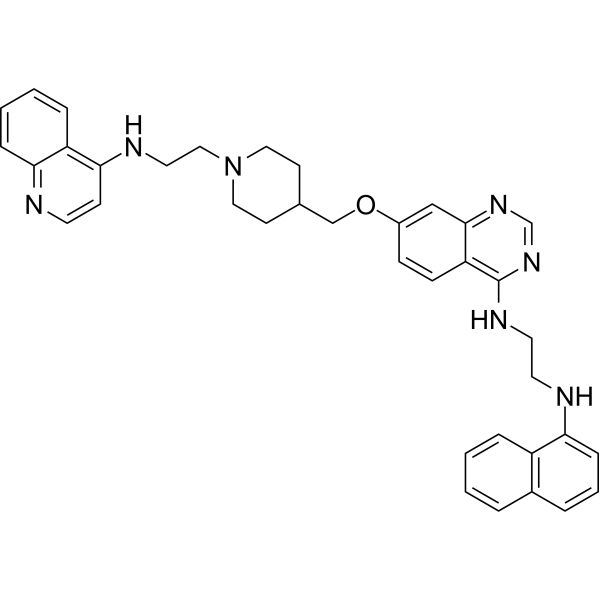
- HY-13735A
-
|
Mepacrine dihydrochloride; SN-390 dihydrochloride
|
Parasite
Apoptosis
Autophagy
Mitophagy
|
Infection
Cancer
|
|
Quinacrine (Mepacrine) dihydrochloride is an orally bioavailable antimalarial agent, which possess anticancer effect both in vitro and vivo. Quinacrine dihydrochloride suppresses NF-κB and activate p53 signaling, which results in the induction of the apoptosis .
|
-
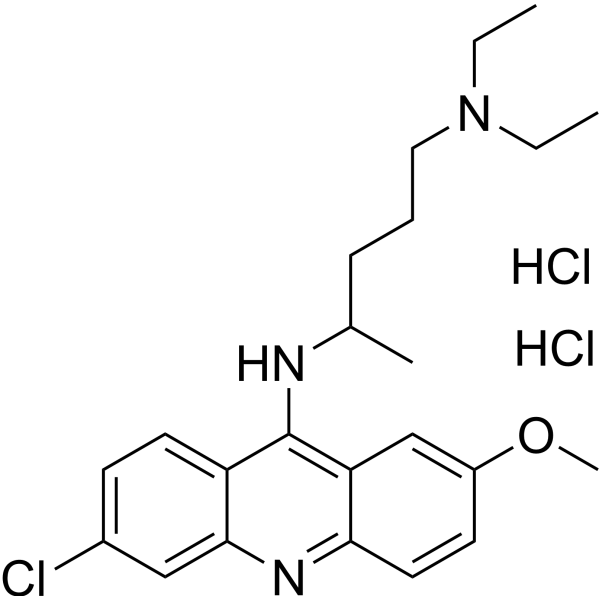
- HY-N7512
-
|
|
Dopamine Receptor
5-HT Receptor
Parasite
|
Infection
Cancer
|
|
Asimilobine is an aporphine isoquinoline alkaloid isolated from plant species of Magnolia obobata Thun. Asimilobine is a dopamine biosynthesis inhibitor and a serotonergic receptor antagonist. Asimilobine shows an antimalarial and anti-cancer activity .
|
-

- HY-15975
-
|
|
Parasite
|
Infection
|
|
GNF179 is an optimized 8,8-dimethyl imidazolopiperazine analog that exhibits antimalarial potency (IC50 of 4.8 nM against the multidrug resistant strain W2). GNF179 is orally active .
|
-
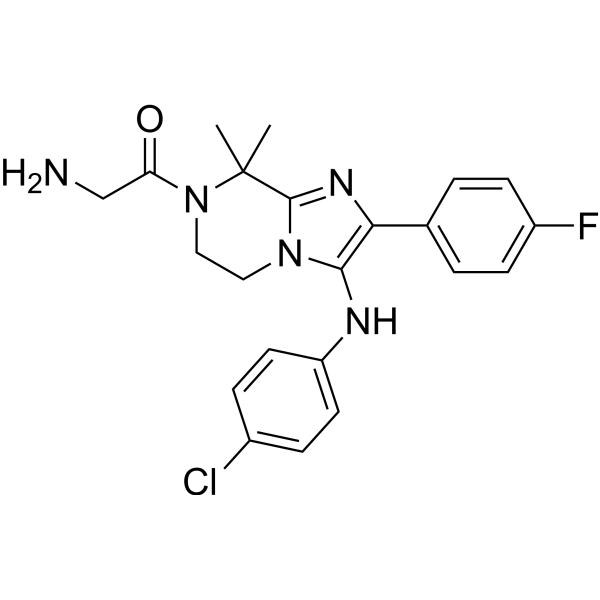
- HY-N10368
-
|
|
Parasite
|
Infection
Neurological Disease
Inflammation/Immunology
|
|
Shinjulactone M is a quassinoid isolated from various parts of Ailanthus species. Ailanthus, an important genus of the Simaroubaceae family, can be used as an febrifuge (antimalarial) and anthelmintic, and is given for the research of chronic bronchitis, epilepsy and asthma .
|
-

- HY-B0806S1
-
|
|
Antifolate
Parasite
|
Infection
|
|
Proguanil-d4 is the deuterium labeled Proguanil[1]. Proguanil, an antimalarial proagent, is metabolized to the active metabolite Cycloguanil (HY-12784). Proguanil is a dihydrofolate reductase (DHFR) inhibitor[2][3].
|
-

- HY-B0806R
-
|
|
Parasite
Antifolate
|
Infection
|
|
Proguanil (Standard) is the analytical standard of Proguanil. This product is intended for research and analytical applications. Proguanil, an antimalarial proagent, is metabolized to the active metabolite Cycloguanil (HY-12784). Proguanil is a dihydrofolate reductase (DHFR) inhibitor .
|
-

- HY-111746
-
|
|
Parasite
|
Infection
|
|
CWHM-1008 is a potent and orally active antimalarial agent, with EC50 values of 46 and 21 nM against agent-sensitive Plasmodium falciparum 3D7 and drug-resistant Dd2 strains, respectively .
|
-
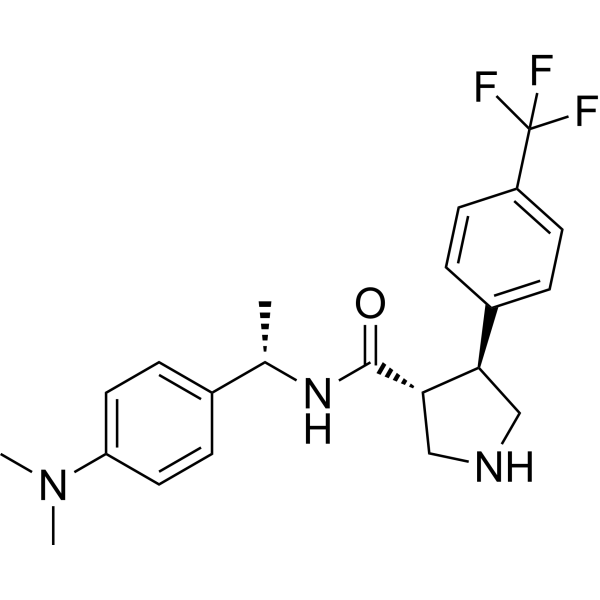
- HY-100711
-
|
Prodigiosine; NSC47147
|
Bacterial
Apoptosis
Wnt
Fungal
Parasite
|
Infection
Inflammation/Immunology
Cancer
|
|
Prodigiosin (Prodigiosine) is a red pigment produced by bacteria as a bioactive secondary metabolite. Prodigiosin is a potent inhibitor of the Wnt/β-catenin pathway. Prodigiosin has antibacterial, antifungal, antiprotozoal, antimalarial, immunosuppressive, and anticancer properties .
|
-

- HY-132171
-
|
|
Dihydroorotate Dehydrogenase
Parasite
|
Infection
|
|
DSM705 is a pyrrole-based Dihydroorotate Dehydrogenase (DHODH) inhibitor. DSM705 exhibits nanomolar potency against Plasmodium DHODH and Plasmodium parasites, with no inhibition of mammalian DHODHs. DSM705 is a potent antimalarial compound .
|
-
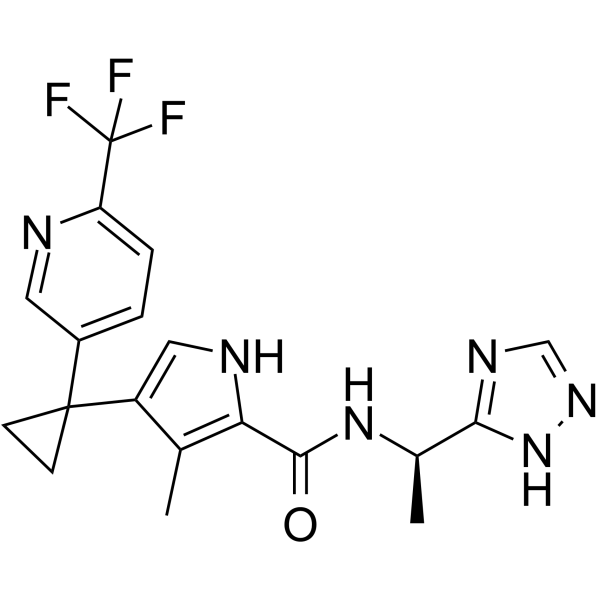
- HY-N1678
-
|
|
Others
|
Others
|
|
2,6-Dimethoxy-1-acetonylquinol (compound 6) can be isolated from Grewia bilamellata. 2,6-Dimethoxy-1-acetonylquinol has antimalarial activity .
|
-

- HY-N1984
-
|
Qing Hao acid; Artemisinic acid; Arteannuic acid
|
Bacterial
|
Infection
Metabolic Disease
Inflammation/Immunology
Cancer
|
|
Artemisinic acid (Qing Hao acid), an amorphane sesquiterpene isolated from Artemisia annua L., possesses a variety of pharmacological activity, such as antimalarial activity, anti-tumor activity, antipyretic effect, antibacterial activity, allelopathy effect and anti-adipogenesis effect .
|
-

- HY-148216
-
|
|
Glyoxalase (GLO)
Parasite
|
Infection
|
|
HBPC-GSH is a glyoxalase (Glo) inhibitor (cGloI IC50=0.6 μM; cGloII IC50=1.6 μM), a glutathione derivative. HBPC-GSH can be used in antimalarial research .
|
-
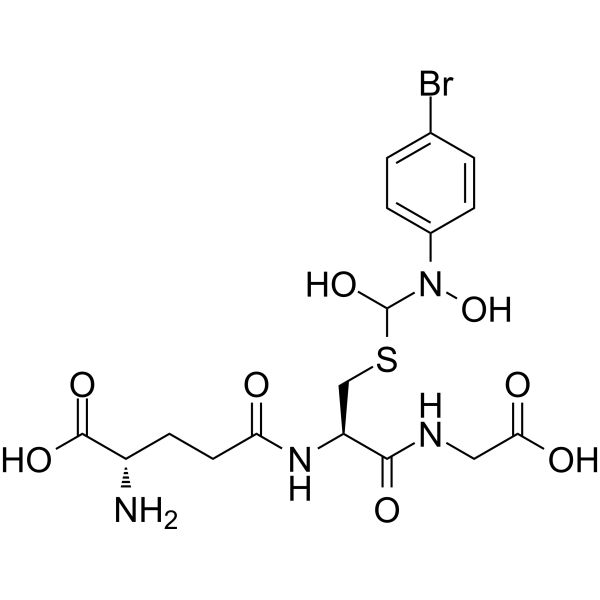
- HY-B0806AS1
-
|
|
Isotope-Labeled Compounds
Parasite
Antifolate
|
Infection
|
|
Proguanil-d6 hydrochloride is the deuterium labeled Proguanil hydrochloride (HY-B0806A). Proguanil hydrochloride, an antimalarial proagent, is metabolized to the active metabolite Cycloguanil (HY-12784). Proguanil hydrochloride is a dihydrofolate reductase (DHFR) inhibitor .
|
-

- HY-N2876
-
|
|
Parasite
Bacterial
|
Infection
|
|
Anisofolin A is a flavonoid that can be isolated from Anisomeles indica. Anisofolin A has antimalarial activity (IC50: 4.39 μM), and antimycobacterium activity (IC50: 4.50 μM) against M. tuberculosis H37Ra .
|
-
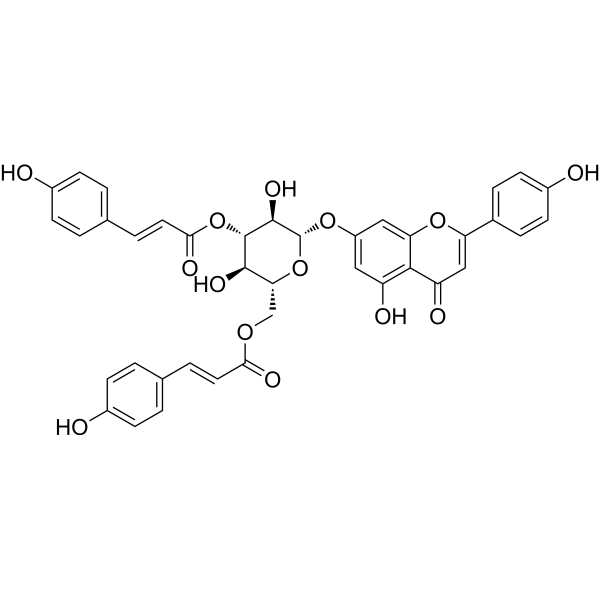
- HY-W011241
-
|
(8R,9S)-Cinchonine hydrochloride; LA40221 hydrochloride
|
Apoptosis
Parasite
|
Cancer
|
|
Cinchonine hydrochloride ((8R,9S)-Cinchonine hydrochloride) is a natural alkaloid present in Cinchona bark, with antimalarial activity. Cinchonine hydrochloride activates endoplasmic reticulum (ER) stress-induced apoptosis in human liver cancer cells .
|
-

- HY-W078844
-
|
|
Dihydroorotate Dehydrogenase
Parasite
|
Infection
|
|
PfDHODH-IN-2, a dihydrothiophenone derivative (Compound 11), is a potent Plasmodium falciparum dihydroorotate dehydrogenase (PfDHODH) inhibitor with an IC50 of 1.11 µM. PfDHODH-IN-2 acts as an antimalarial agent and can be used for the research of malaria .
|
-

- HY-100711A
-
|
Prodigiosine hydrochloride
|
Bacterial
Apoptosis
Fungal
Wnt
Parasite
|
Infection
Inflammation/Immunology
Cancer
|
|
Prodigiosin (Prodigiosine) hydrochloride is a red pigment produced by bacteria as a bioactive secondary metabolite. Prodigiosin hydrochloride is a potent proapoptotic agent, and inhibits Wnt/β-catenin pathway. Prodigiosin hydrochloride has antibacterial, antifungal, antiprotozoal, antimalarial, immunosuppressive, and anticancer properties .
|
-
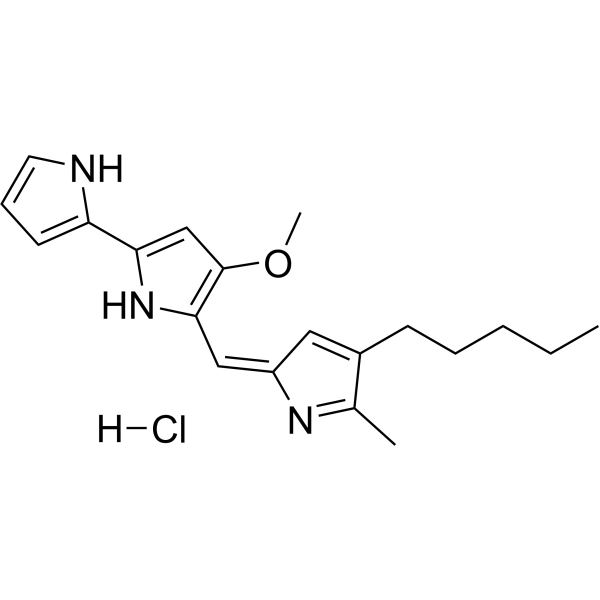
- HY-W112166A
-
|
|
Bacterial
|
Infection
|
|
4,4'-Dicyanostilbene (compound 43) is a potent antimalarial agent against the Dd2 strain, with an EC50 of 27 nM. 4,4'-Dicyanostilbene exhibits in vivo efficacy against methicillin-resistant Staphylococcus aureus (MRSA) .
|
-
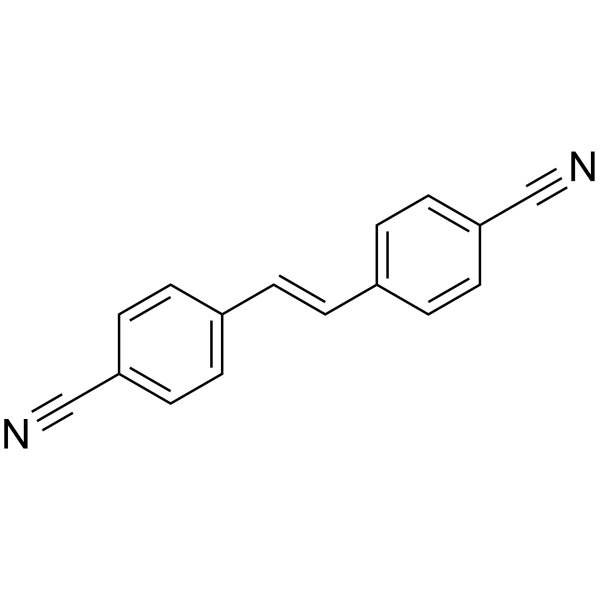
- HY-N12151
-
|
|
Parasite
|
Infection
|
|
Chaparrinone is a quassinoid that can be isolated from the root of Eurycoma harmandiana. Chaparrinone has antimalarial and cytotoxic activities against Plasmodium falciparum and P-388 cells (IC50: 0.037 and 0.34 μg/mL respectively) .
|
-
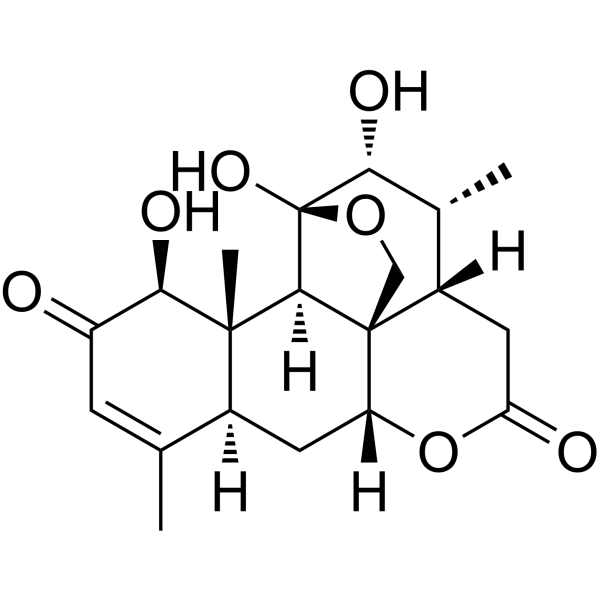
- HY-18062
-
|
Pirimecidan; Pirimetamin; RP 4753
|
Antifolate
Parasite
|
Infection
|
|
Pyrimethamine (Pirimecidan) is a potent, orally active dihydrofolate reductase (DHFR) inhibitor. Pyrimethamine is an antimalarial agent. Pyrimethamine affects the nucleoprotein metabolism of malarial parasites by interference in the folic–folinic acid systems and affects cell division by inhibiting the conversion of dihydrofolate to tetrahydrofolate .
|
-
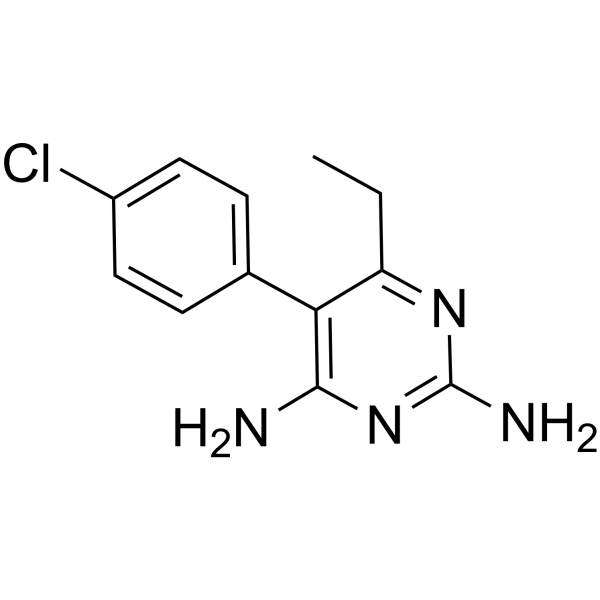
- HY-108640A
-
|
|
MDM-2/p53
Parasite
Apoptosis
|
Infection
Cancer
|
|
HLI373 dihydrochloride is an efficacious Hdm2 inhibitor. HLI373 dihydrochloride inhibits the ubiquitin ligase activity of Hdm2. HLI373 dihydrochloride is effective in inducing apoptosis of several tumor cells that are sensitive to DNA-damaging agents . Antimalarial activity .
|
-
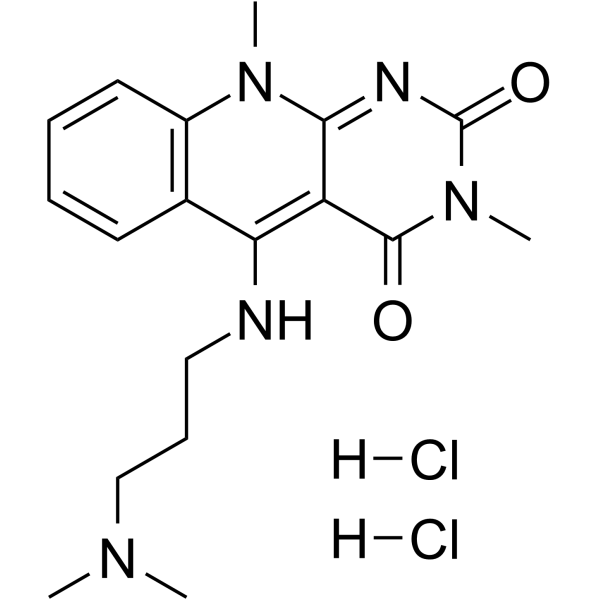
- HY-108640
-
|
|
MDM-2/p53
Parasite
Apoptosis
|
Infection
Cancer
|
|
HLI373 is an efficacious Hdm2 inhibitor. HLI373 inhibits the ubiquitin ligase activity of Hdm2. HLI373 is effective in inducing apoptosis of several tumor cells that are sensitive to DNA-damaging agents . Antimalarial activity .
|
-

- HY-P2261
-
|
|
PKA
|
Infection
|
|
STAD 2 is a potent and selective disruptor of PKA-RII, with a Kd of 6.2 nM. STAD 2 disrupts interactions between PKA and AKAP in an isoform-selective manner. STAD 2 displays antimalarial activity through a PKA-independent mechanism .
|
-
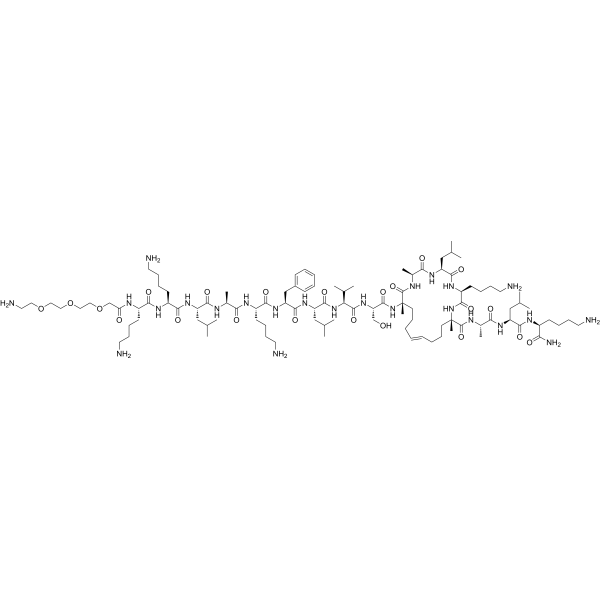
- HY-147371
-
|
|
Parasite
|
Infection
Neurological Disease
|
|
Quinoprazine is a potent inhibitor of Vaccinia virus DNA synthesis with an IC50 value of 10 μM. Quinoprazine has antimalarial activity against Plasmodium berghei and also displays antiprion potency, significantly decreases PrP S c levels - .
|
-
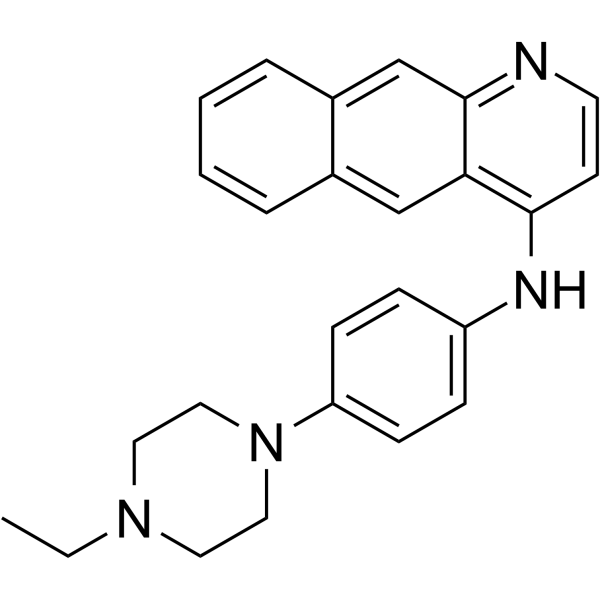
- HY-N7173
-
|
|
Parasite
|
Infection
|
|
7-Methoxy-β-carboline-1-propionic acid (compound 46) is a cytotoxic and antimalarial compound. 7-Methoxy-β-carboline-1-propionic acid can be extracted from the roots of Eurycoma longifolia .
|
-
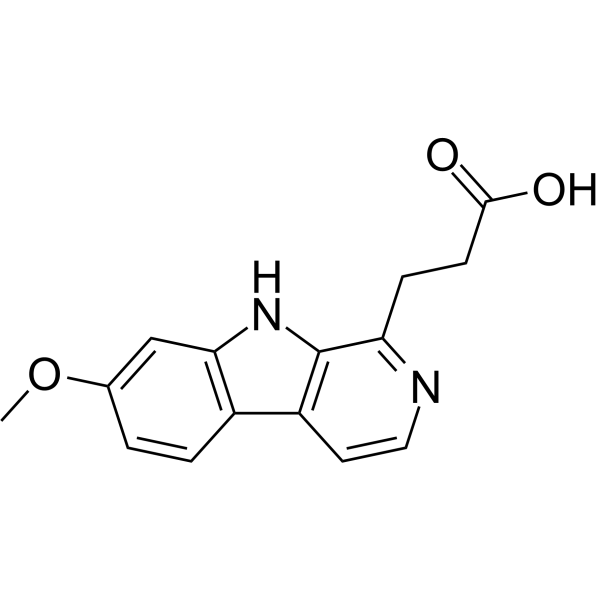
- HY-152313
-
|
|
Nucleoside Antimetabolite/Analog
|
Others
|
|
2-Bromoadenosine, antimalarial agent is a purine nucleoside analogue. Purine nucleoside analogs have broad antitumor activity targeting indolent lymphoid malignancies. Anticancer mechanisms in this process rely on inhibition of DNA synthesis, induction of apoptosis, etc .
|
-
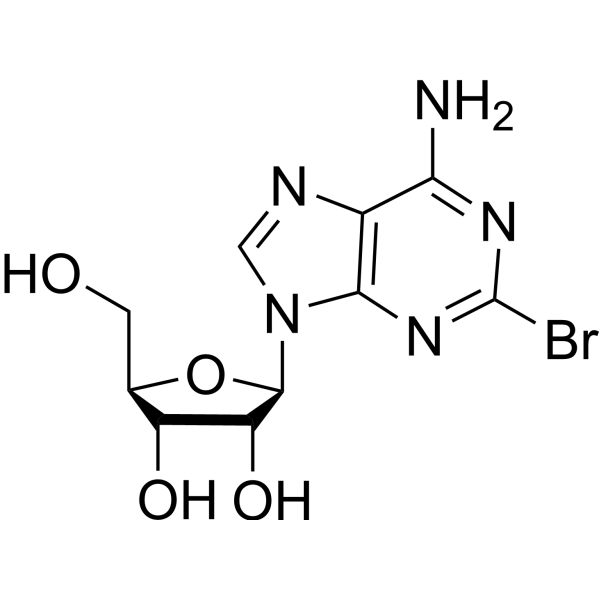
- HY-160633
-
|
|
Others
|
Infection
|
|
PfFAS-II inhibitor 1 (Compound 3) is a Plasmodium falciparum type II fatty acid biosynthesis pathway (PfFAS-II) inhibitor, with an IC50 of 0.63 μM for PfFabI enzyme. PfFAS-II inhibitor 1 has antimalarial activity .
|
-
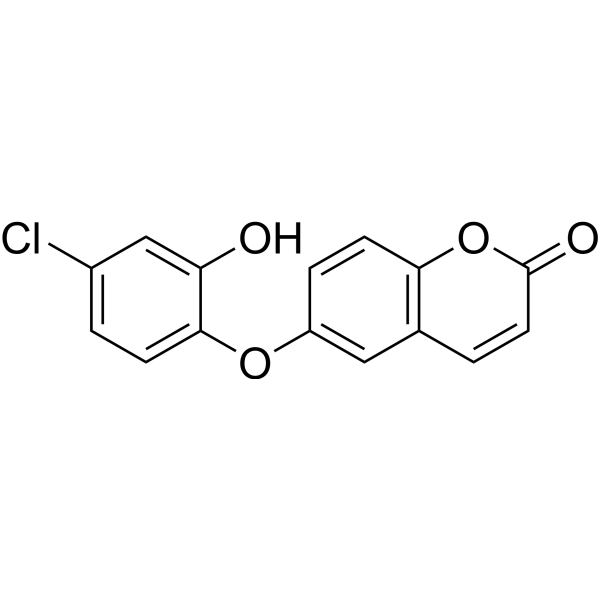
- HY-B0770
-
|
β-Arteether; (+)-Arteether; Arteether
|
Parasite
|
Infection
Cancer
|
|
Artemotil (β-Arteether) has antimalarial activity for the treatment of chloroquine-resistant Plasmodium falciparum malaria with an IC50 of 1.61 nM. Artemotil also has central nervous system (CNS) neurotoxicity and anorectic toxicity in rats, dogs and monkeys .
|
-

- HY-N5018
-
|
Musizin
|
Parasite
AMPK
|
Infection
|
|
Nepodin (Musizin) is a quinone oxidoreductase (PfNDH2) inhibitor isolate from Rumex crispus .Nepodin (Musizin) stimulates the translocation of GLUT4 to the plasma membrane by activation of AMPK .Nepodin (Musizin) has antidiabetic and antimalarial activities.
|
-
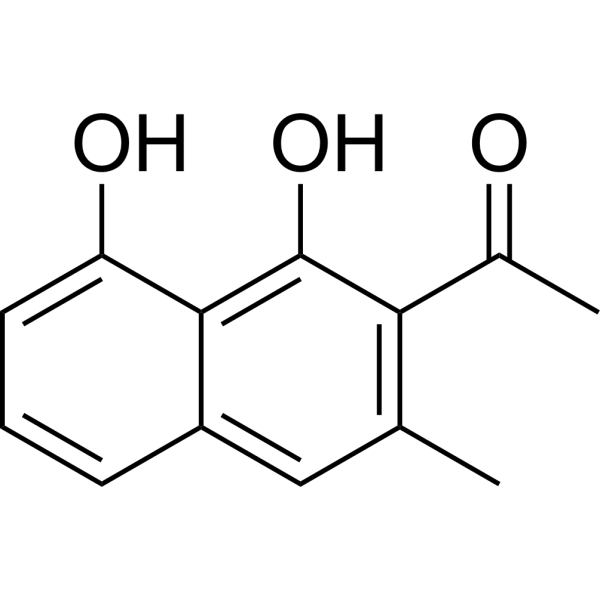
- HY-117015
-
|
|
Parasite
|
Infection
|
|
Purfalcamine is an orally active, selective Plasmodium falciparum calcium-dependent protein kinase 1 (PfCDPK1) inhibitor with an IC50 of 17 nM and an EC50 of 230 nM. Purfalcamine has antimalarial activity and causes malaria parasites developmental arrest at the schizont stage .
|
-
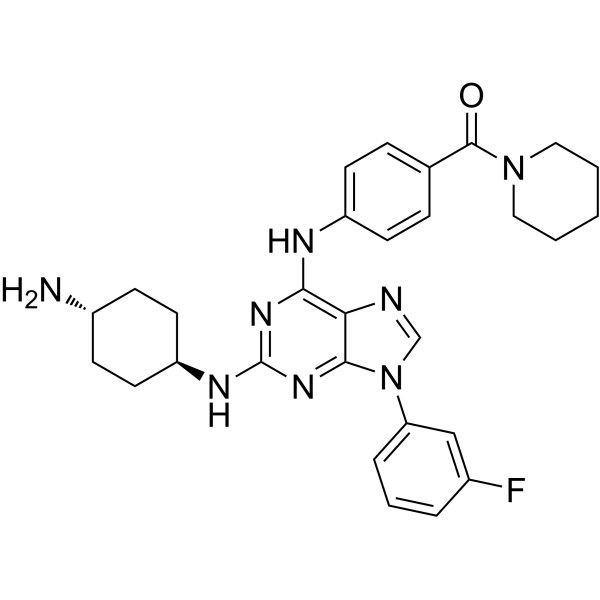
- HY-135619
-
-
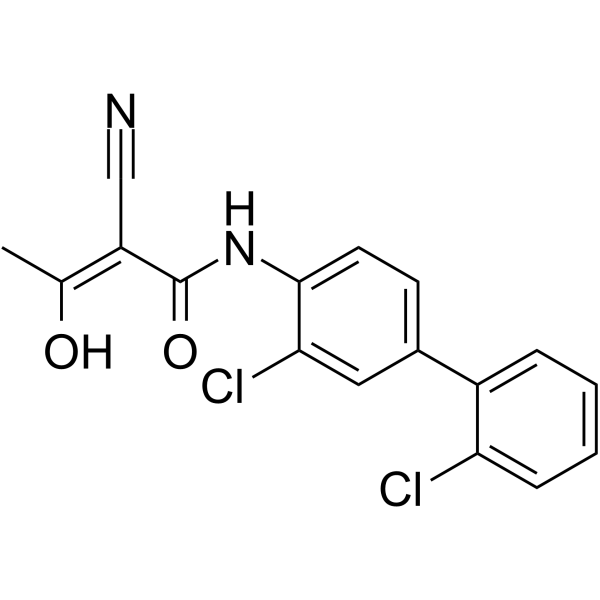
- HY-P3914
-
|
Oct-CA(1-7)M(2-9)
|
Bacterial
|
Infection
|
|
Cecropin A (1-7)-Melittin A (2-9) is an antimicrobial peptide with antimicrobial activity against a broad spectrum of Gram-positive and Gram-negative aerobic bacteria, as well as antimalarial activity, without the adverse hemolytic properties of bee venom peptides .
|
-
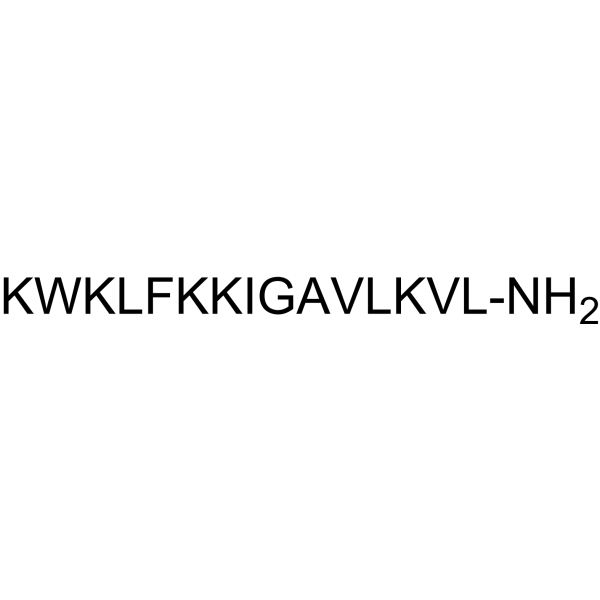
- HY-N3283
-
|
|
Parasite
|
Infection
|
|
6-Methylhydroxyyangolensate is a limonoid can be extracted from Khaya grandifoliola. 6-Methylhydroxyyangolensate has low antimalarial activity in vitro, with an IC50 of 21.59 μg/ml against P. falciparum (W2/Indochina clone) .
|
-
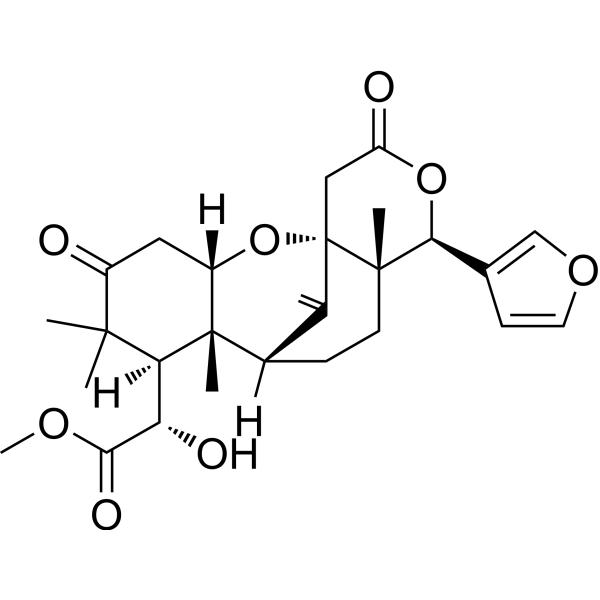
- HY-N8285
-
|
|
Parasite
|
Infection
|
|
Sporogen AO-1 is a fungal metabolite originally isolated from the fungusAspergillus oryzae. Sporogen AO-1 has significant antimalarial activity againstplasmodium falciparum, with an IC50 value of 1.53 μM, and also has certain cytotoxicity .
|
-

- HY-121556
-
|
|
Reactive Oxygen Species
Parasite
|
Infection
|
|
Rufigallol is one of the earliest systems reported to form columnar mesophases. Rufigallol is also an oxidant agent. Rufigallol acts in a pro-oxidant fashion to produce oxygen radicals inside parasitized erythrocytes. Rufigallol has vitamin K activity and antimalarial activity .
|
-

- HY-114489A
-
|
|
Apoptosis
Influenza Virus
Parasite
|
Infection
Neurological Disease
Cancer
|
|
Haemanthamine is a crinine-type alkaloid isolated from the Amaryllidaceae plants with potent anticancer activity. Haemanthamine targets ribosomal that inhibits protein biosynthesis during the elongation stage of translation. Haemanthamine has pro-apoptotic, antioxidant, antiviral, antimalarial and anticonvulsant activities .
|
-
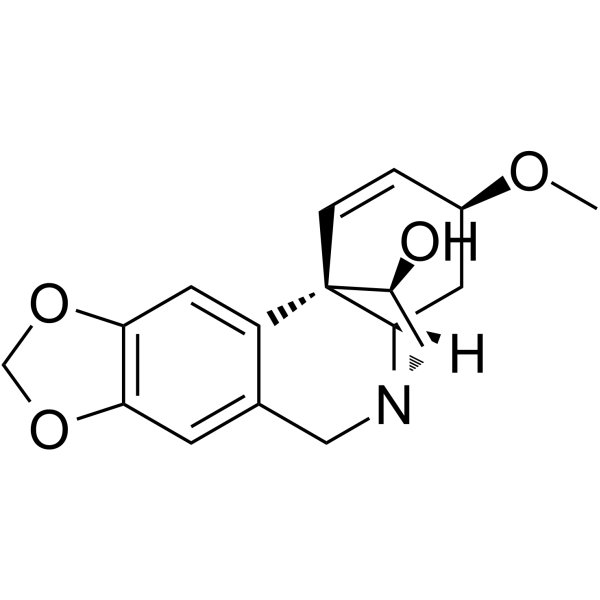
- HY-114489B
-
|
|
Apoptosis
Influenza Virus
Parasite
|
Infection
Neurological Disease
Cancer
|
|
Haemanthamine hydrochloride is a crinine-type alkaloid isolated from the Amaryllidaceae plants with potent anticancer activity. Haemanthamine hydrochloride targets ribosomal that inhibits protein biosynthesis during the elongation stage of translation. Haemanthamine hydrochloride has pro-apoptotic, antioxidant, antiviral, antimalarial and anticonvulsant activities .
|
-
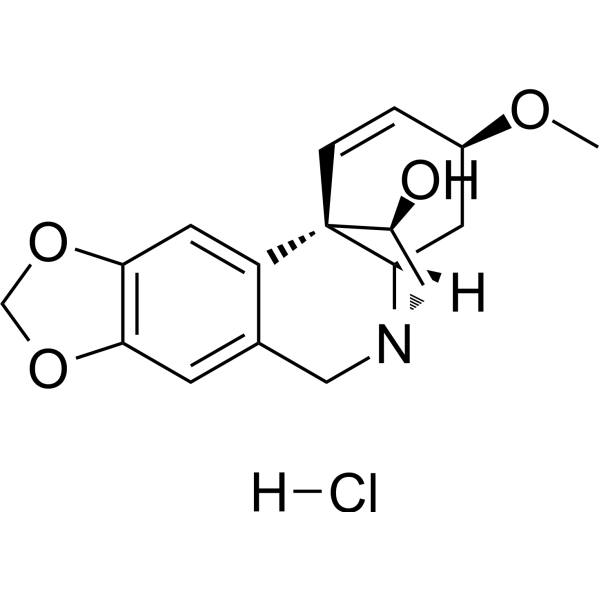
- HY-106866
-
|
CDRI 80/53; Elubaquine
|
Parasite
|
Infection
|
|
Bulaquine (CDRI 80/53) is a potent antimalarial agent which is an analogue of Primaquine (HY-12651A). Bulaquine affects multiple metabolism pathways and shows inhibition effect on Plasmodium cynomolgi infection. Bulaquine can be used for the research of malaria .
|
-
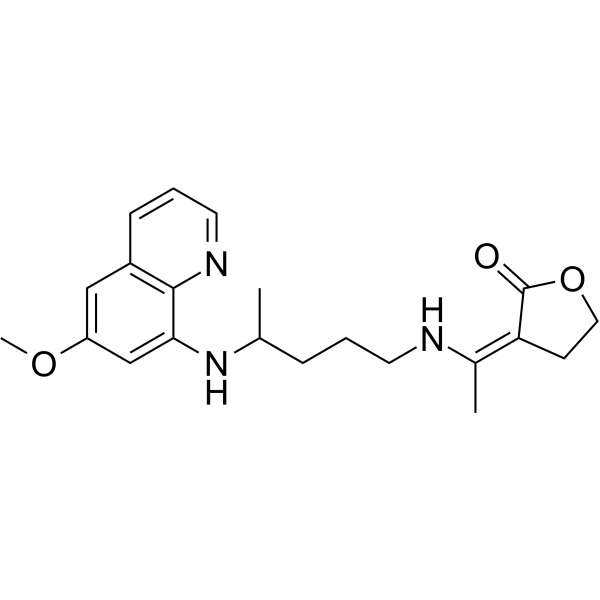
- HY-B1370A
-
|
(S)-HCQ
|
Parasite
Toll-like Receptor (TLR)
SARS-CoV
Autophagy
|
Infection
|
|
(S)-Hydroxychloroquine ((S)-HCQ) is the enantiomer of Hydroxychloroquine . Hydroxychloroquine, a synthetic antimalarial agent, inhibits Toll-like receptor 7/9 (TLR7/9) signaling, and shows efficiently inhibits SARS-CoV-2 infection in vitro .
|
-
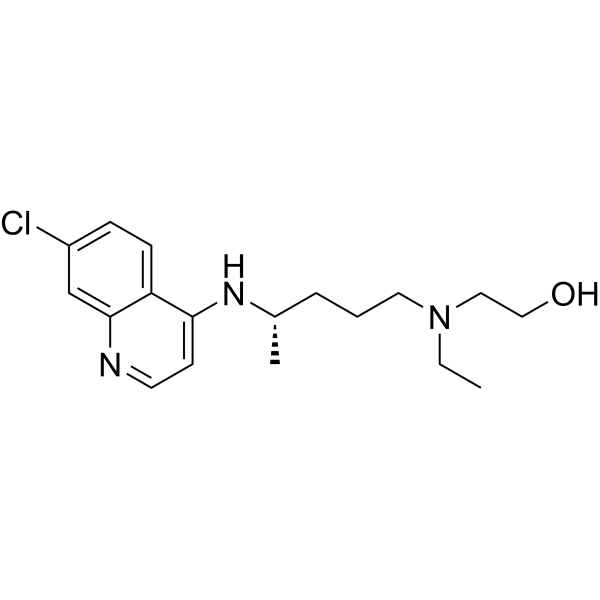
- HY-120607
-
|
|
Parasite
|
Infection
Cancer
|
|
Chevalone C, a meroterpenoid fungal metabolite, shows antimalarial activity with IC50 value of 25.00 μg/mL. Chevalone C has anti-proliferative activity on colon HCT116, liver HepG2 and melanoma A375 cancer cell lines .
|
-
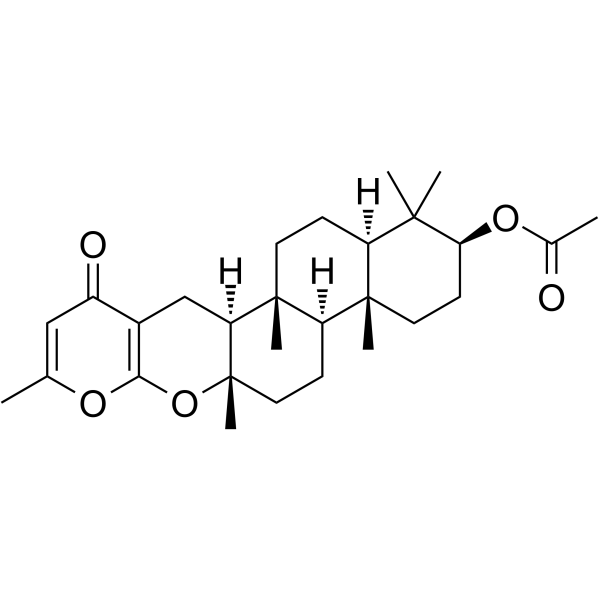
- HY-A0148AR
-
|
|
Parasite
|
Infection
|
|
Halofantrine (hydrochloride) (Standard) is the analytical standard of Halofantrine (hydrochloride). This product is intended for research and analytical applications. Halofantrine hydrochloride (SKF-102886) is a blocker of delayed rectifier potassium current via the inhibition of human-ether-a-go-go-related gene (HERG) channel and a potent antimalarial compound .
|
-

- HY-B1370
-
-
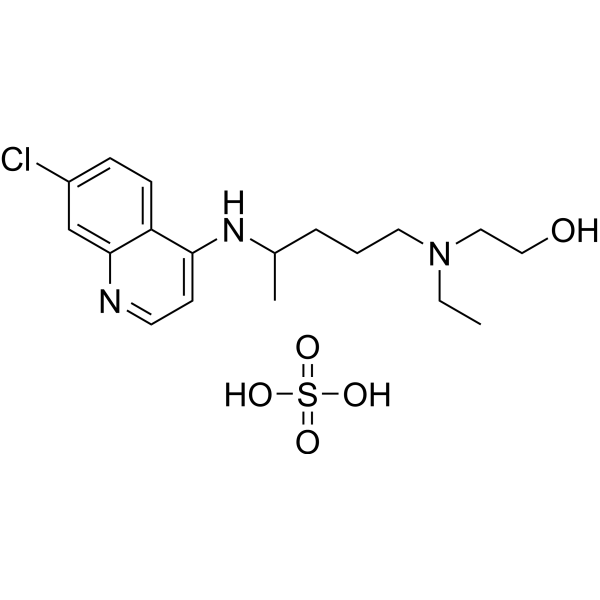
- HY-135652
-
|
Hexyl 3,4,5-trihydroxybenzoate
|
Bacterial
Parasite
|
Infection
|
|
Hexyl gallates (Hexyl 3,4,5-trihydroxybenzoate) shows antibacterial activity and inhibits the production of rhamnolipid and pyocyanin by inhibiting RhlR . Hexyl gallate, a alkyl ester derivative of gallic acid, exhibits potent antimalarial activity against Plasmodium falciparum, with IC50 of 0.11 mM .
|
-
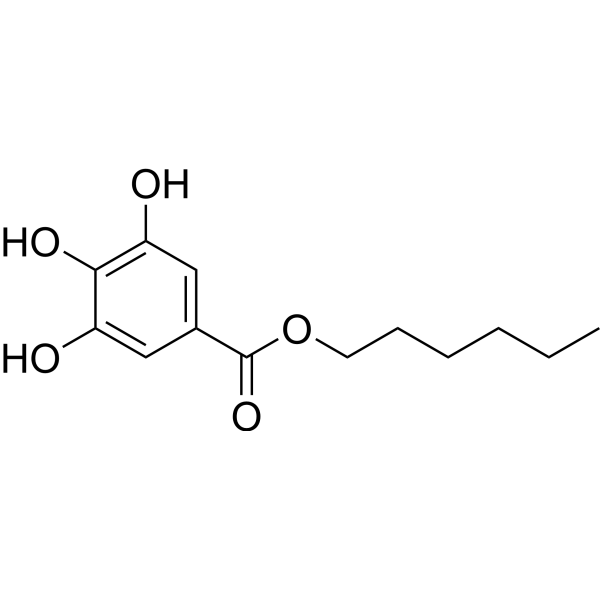
- HY-B1370B
-
|
(R)-HCQ
|
Parasite
Toll-like Receptor (TLR)
SARS-CoV
Autophagy
|
Infection
|
|
(R)-Hydroxychloroquine is the enantiomer of Hydroxychloroquine . Hydroxychloroquine is a synthetic antimalarial agent which can also inhibit Toll-like receptor 7/9 (TLR7/9) signaling. Hydroxychloroquine is efficiently inhibits SARS-CoV-2 infection in vitro .
|
-
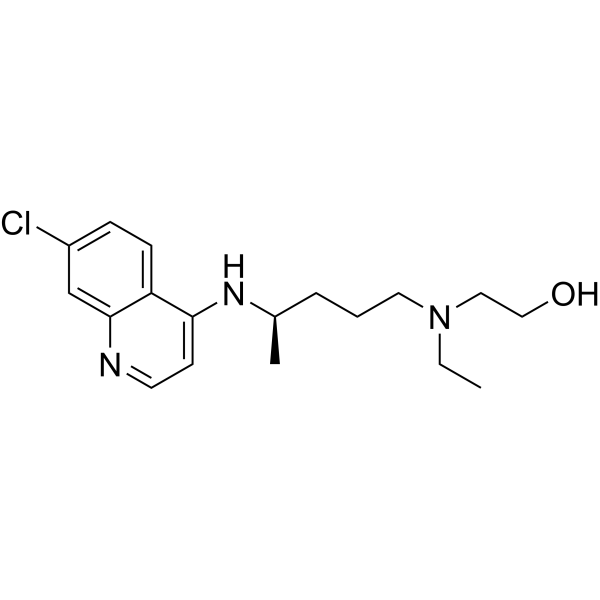
- HY-106338
-
|
|
Bacterial
ADC Cytotoxin
Parasite
|
Infection
Cancer
|
|
Polyketomycin is a tetracyclic quinone glycoside antibiotic isolated from Streptomyces sp. or Streptomyces diastatochromogenes. Polyketomycin inhibits growth of Gram-positive bacteria, and its MIC values is less than 0.2 µg/mL. Polyketomycin has antibacterial, anticancer, antimalarial activities .
|
-
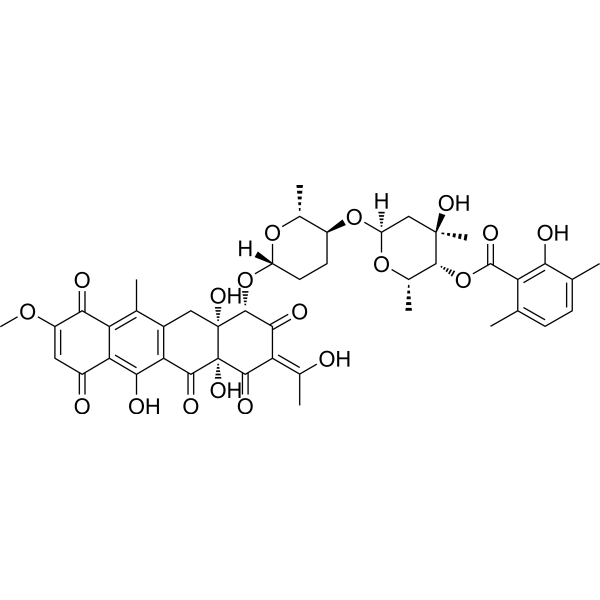
- HY-W026467
-
|
|
Parasite
|
Infection
|
|
MMV665916, a quinazolinedione derivative, is an antimalarial agent. MMV665916 displays antiplasmodial activity against P. falciparum FcB1 strain with EC50 value of 0.4 µM and presents the high selectivity index (SI>250) .
|
-
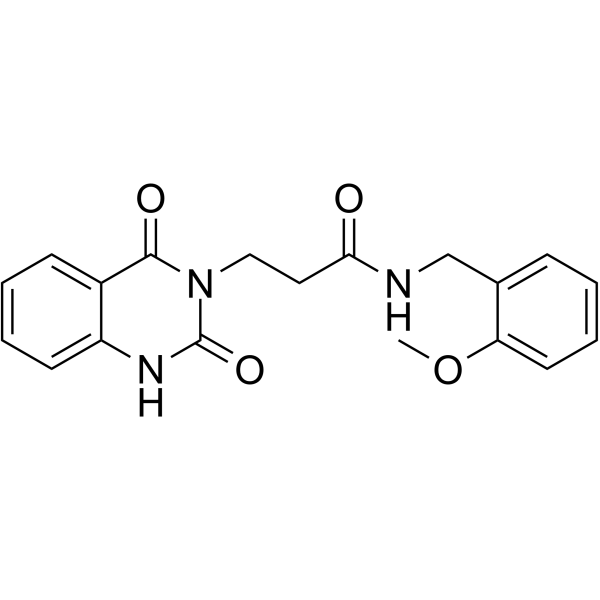
- HY-131262
-
|
4-[(7-Chloro-4-quinolinyl)amino]-1-pentanol
|
SARS-CoV
Toll-like Receptor (TLR)
|
Others
|
|
Hydroxychloroquine Impurity E is the impurity of Hydroxychloroquine. Hydroxychloroquine is a synthetic antimalarial agent which can also inhibit Toll-like receptor 7/9 (TLR7/9) signaling. Hydroxychloroquine is efficiently inhibits SARS-CoV-2 infection in vitro .
|
-
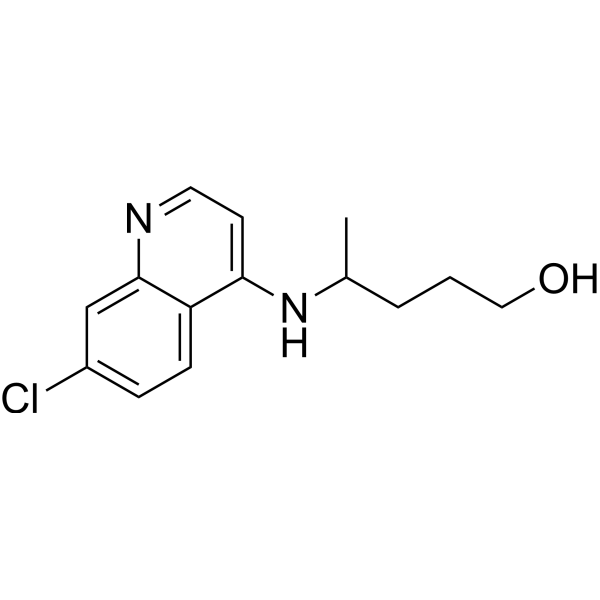
- HY-131263
-
|
|
Drug Metabolite
|
Others
|
|
Hydroxychloroquine Impurity F is the impurity of Hydroxychloroquine. Hydroxychloroquine is a synthetic antimalarial agent which can also inhibit Toll-like receptor 7/9 (TLR7/9) signaling. Hydroxychloroquine is efficiently inhibits SARS-CoV-2 infection in vitro .
|
-
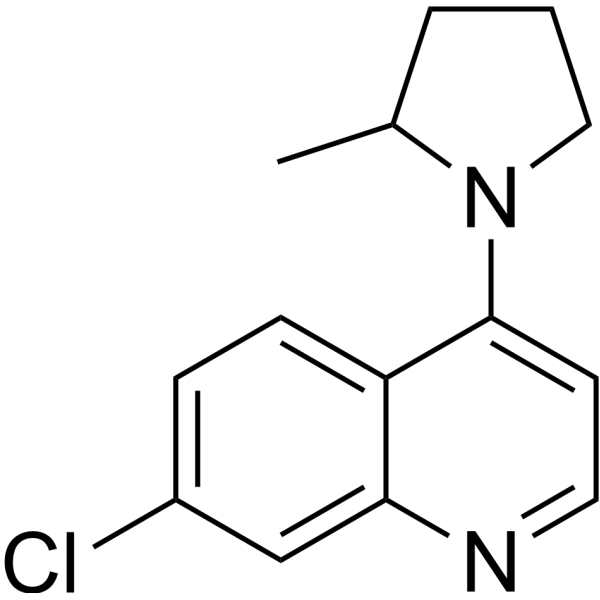
- HY-108024A
-
|
KAF156 hydrochloride; GNF156 hydrochloride
|
Parasite
|
Infection
|
|
Ganaplacide (KAF156) hydrochloride is a first-in-class, orally active imidazolopiperazine antimalarial agent. Ganaplacide hydrochloride is active against a broad range of Plasmodium species, including drug-resistant parasites. Ganaplacide hydrochloride is parasiticidal against both asexual and sexual blood stages as well as the liver stages of the parasite .
|
-
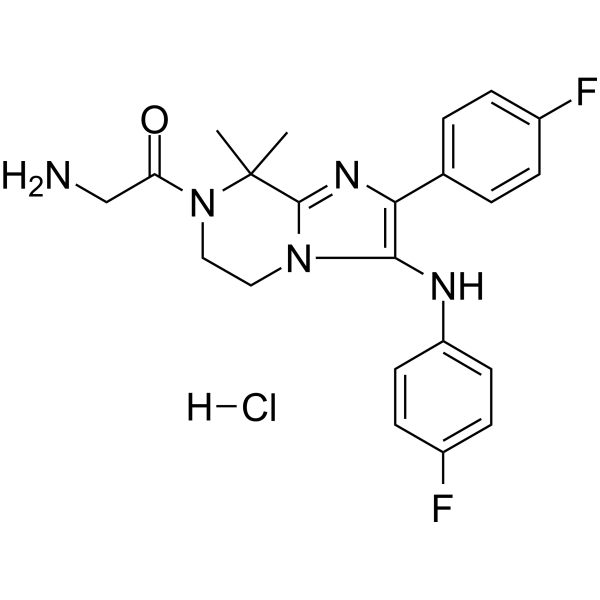
- HY-13735
-
-

- HY-108024
-
|
KAF156; GNF156
|
Parasite
|
Infection
|
|
Ganaplacide (KAF156) is a first-in-class,
orally active imidazolopiperazine antimalarial agent.
Ganaplacide is active against a broad range of Plasmodium
species, including drug-resistant parasites. Ganaplacide is parasiticidal
against both asexual and sexual blood stages as well as the liver stages of the
parasite .
|
-
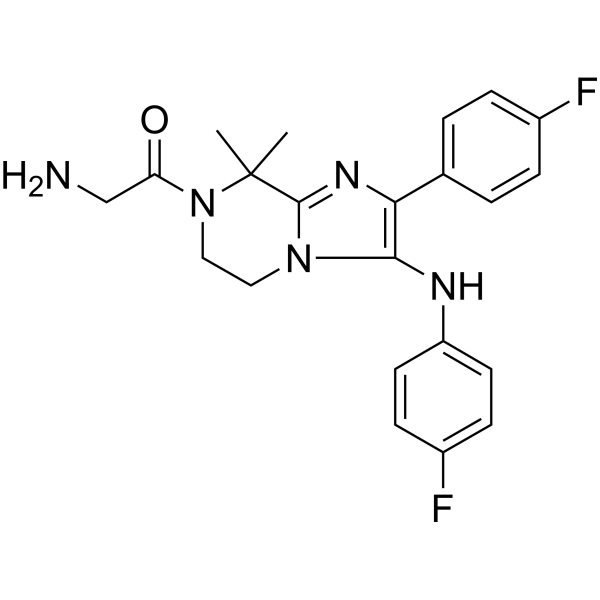
- HY-144296
-
|
|
Parasite
|
Infection
|
|
Purine phosphoribosyltransferase-IN-2 is a potent inhibitor of the Plasmodium falciparum ((Pf)), Plasmodium vivax ((Pv)) and Trypanosoma brucei ((Tbr)) 6-oxopurine phosphoribosyltransferase (PRT), with Kis of 30, 20 and 2 nM, respectively .
|
-

- HY-135666
-
-

- HY-13735AR
-
|
|
Parasite
Apoptosis
Autophagy
Mitophagy
|
Infection
Cancer
|
|
Quinacrine (dihydrochloride) (Standard) is the analytical standard of Quinacrine (dihydrochloride). This product is intended for research and analytical applications. Quinacrine (Mepacrine) dihydrochloride is an orally bioavailable antimalarial agent, which possess anticancer effect both in vitro and vivo. Quinacrine dihydrochloride suppresses NF-κB and activate p53 signaling, which results in the induction of the apoptosis .
|
-

- HY-17437A
-
-
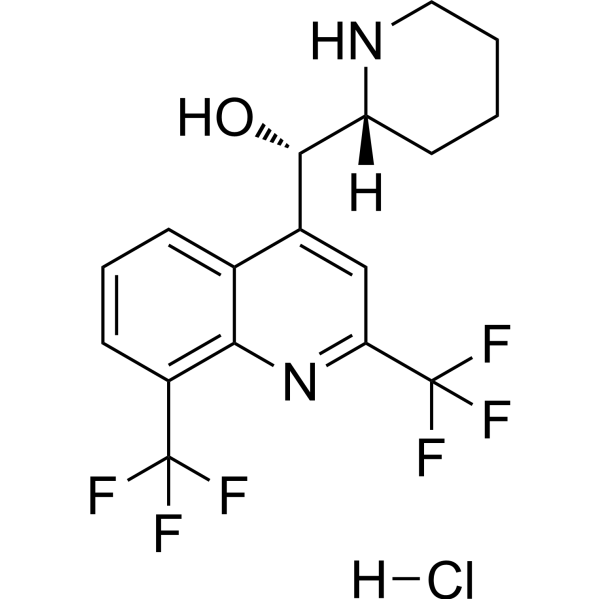
- HY-123561
-
|
|
Parasite
|
Infection
|
|
MMV008138 is a species-selective IspD (enzyme 2-C-methyl-d-erythritol 4-phosphate cytidylyltransferase)-targeting antimalarial agent, with an IC50 of 44 nM for PfIspD (P. falciparum IspD). MMV008138 inhibits the growth of P. falciparum Dd2 strain with an IC50 of 250 nM .
|
-
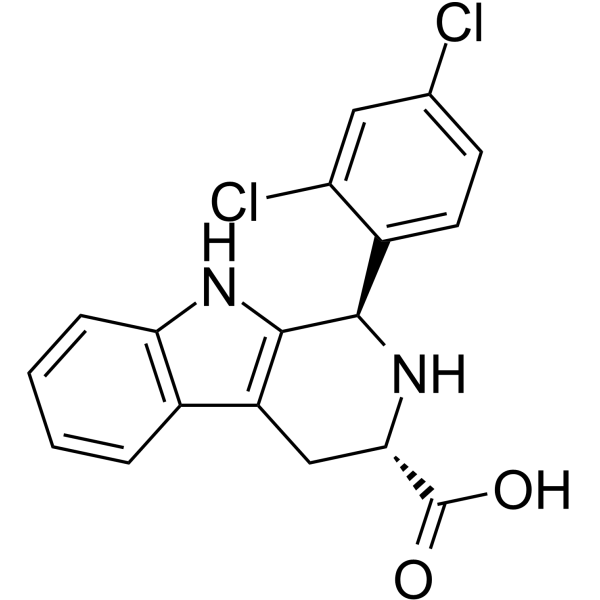
- HY-N7516
-
|
|
Parasite
Bacterial
Fungal
|
Infection
|
|
4'-Hydroxy-2,4-dimethoxychalcone is a natural chalcone derivatives in the red herbal resin of Dracaena cochinchinensis. 4'-Hydroxy-2,4-dimethoxychalcone displays a wide range of biological activities including antimalarial, antiprotozoal, antibacterial, antifungal activity .
|
-
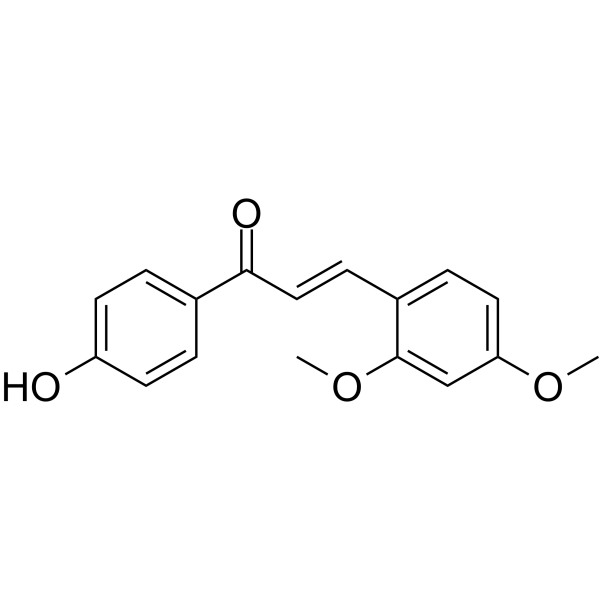
- HY-132171A
-
|
|
Dihydroorotate Dehydrogenase
Parasite
|
Infection
|
|
DSM705 hydrochloride, an orally active antimalarial compound, is a pyrrole-based Dihydroorotate Dehydrogenase (DHODH) inhibitor. DSM705 hydrochloride exhibits nanomolar potency against Plasmodium DHODH and Plasmodium parasites (IC50=95, 52 nM for P. falciparum and P. vivax DHODH, respectively), with no inhibition of mammalian DHODHs .
|
-

- HY-126601
-
|
|
Parasite
HSP
|
Infection
|
|
Malonganenone A is an antimalarial marine alkaloid that disrupts the interaction between PfHsp70-x and Hsp40. Malonganenone A inhibits plasmodial and not human Hsp70 ATPase activity (Hsp40-stimulated), and hindered the aggregation suppression activity of PfHsp70-x .
|
-

- HY-N7926
-
|
|
Parasite
|
Inflammation/Immunology
|
|
Pentadecane is a floral volatile antimalarial agent that can inhibit the growth of parasites such as Leishmania and avoid infection of macrophages. The IC50s of Pentadecane against promastigotes and amastigotes are 65.3 μM and 60.5 μM, respectively. Pentadecane also has anti-inflammatory, analgesic, and antipyretic activities .
|
-
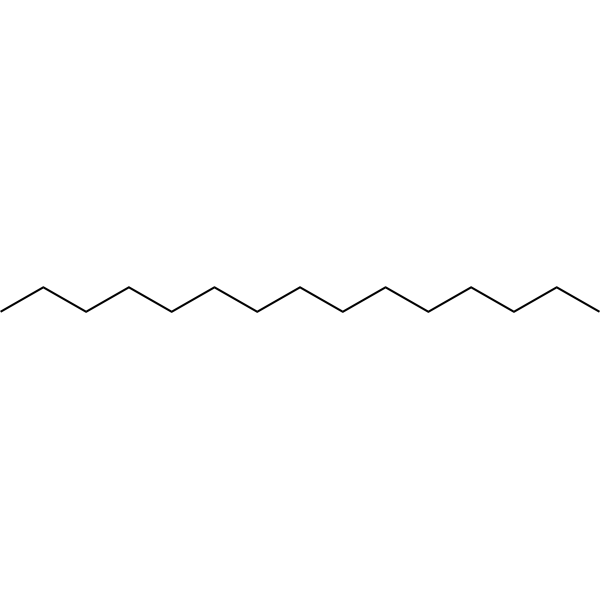
- HY-N2208
-
|
|
p38 MAPK
|
Infection
Metabolic Disease
Inflammation/Immunology
Cancer
|
|
4-Hydroxylonchocarpin is a chalcone compound from an extract of Psoralea corylifolia. 4-Hydroxylonchocarpin increases phosphorylation of p38 MAPK, JNK and ERK. 4-Hydroxylonchocarpin has diverse pharmacological activities, including antibacterial, antifungal, anticancer, antireverse transcriptase, antitubercular, antimalarial, anti-inflammatory and antioxidant activities .
|
-
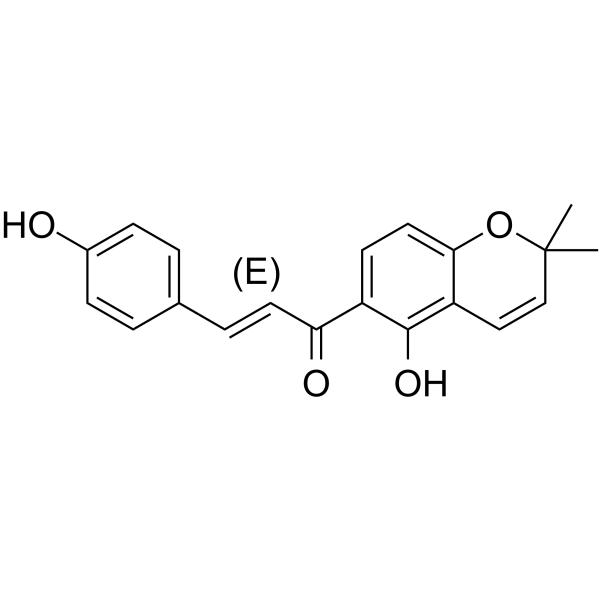
- HY-117684
-
|
DDD107498; DDD-498; M5717
|
Parasite
CaMK
|
Infection
|
|
Cabamiquine (DDD107498) is a potent and orally active antimalarial agent, inhibits multiple life-cycle stages of the parasite, with an EC50 of 1 nM against P. falciparum 3D7. Cabamiquine inhibits protein synthesis by targeting eEF2/CaMKIII, with an EC50 of 2 nM for WT-PfeEF2 .
|
-
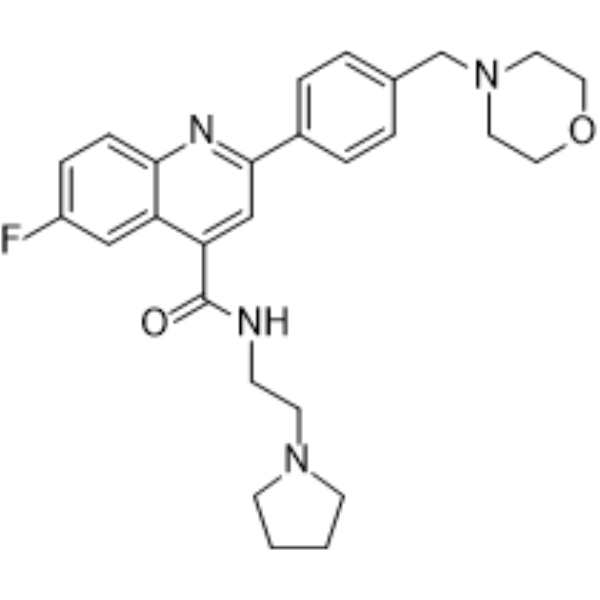
- HY-120104
-
|
(±)-Nitidanin
|
Parasite
HCV
|
Infection
|
|
Nitidanin ((±)-Nitidanin) is an antimalarial and antiviral compound that can be isolated from the wood of Xanthoxylum nitidun D. C. Nitidanin is shows IC50 values of 21.2 and 18.4 μM for D6 and W2 clones of Plasmodium falciparum, respectively. Nitidanin can be used for the research of malaria and virus infection .
|
-
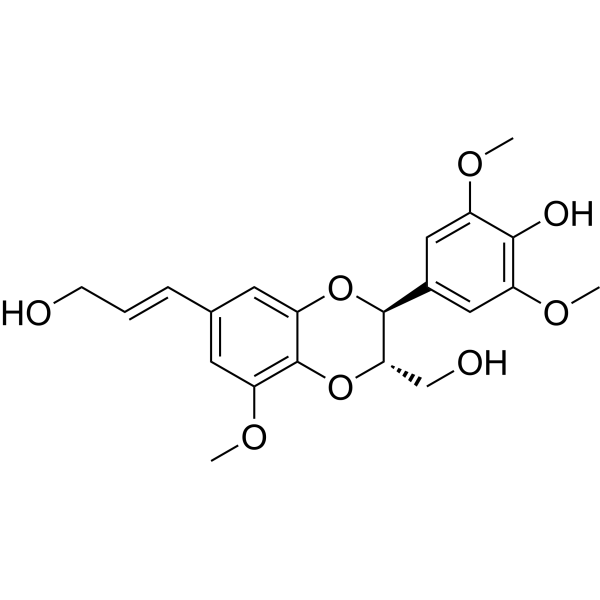
- HY-17589
-
-
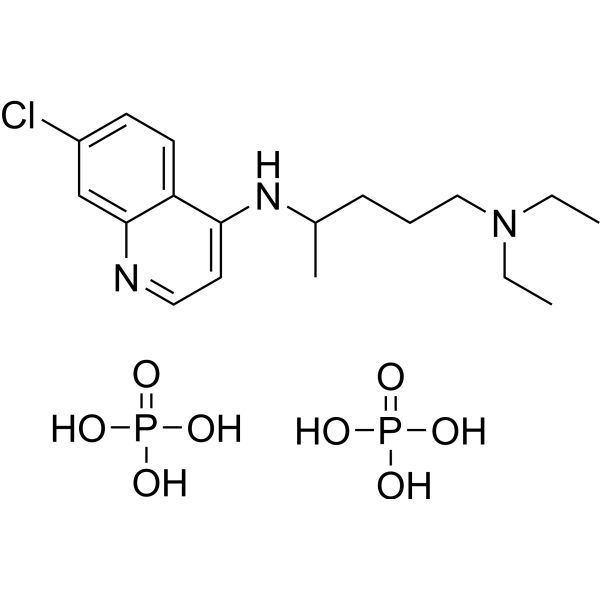
- HY-W031727S
-
-
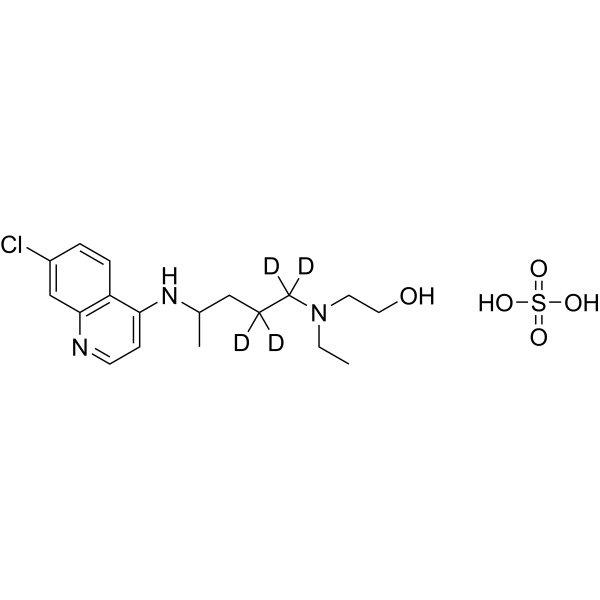
- HY-Y0152
-
|
(8R,9S)-Cinchonine; LA40221
|
Apoptosis
Parasite
Autophagy
Caspase
Calcium Channel
|
Others
Inflammation/Immunology
Cancer
|
|
Cinchonine is a natural compound present in Cinchona bark with antimalarial, antitumor, anti-inflammatory, anti platelet-aggregation and anti-obesity properties. Cinchonine inhibits cells proliferation and autophagy and induces apoptosis through activation of Caspase-3. Cinchonine activates endoplasmic reticulum stress-induced apoptosis in human liver cancer cells .
|
-

- HY-117684A
-
|
DDD107498 succinate; DDD-498 succinate; M5717 succinate
|
Parasite
CaMK
|
Infection
|
|
Cabamiquine (DDD107498) succinate is a potent and orally active antimalarial agent, inhibits multiple life-cycle stages of the parasite, with an EC50 of 1 nM against P. falciparum 3D7. Cabamiquine succinate inhibits protein synthesis by targeting eEF2/CaMKIII, with an EC50 of 2 nM for WT-PfeEF2 .
|
-
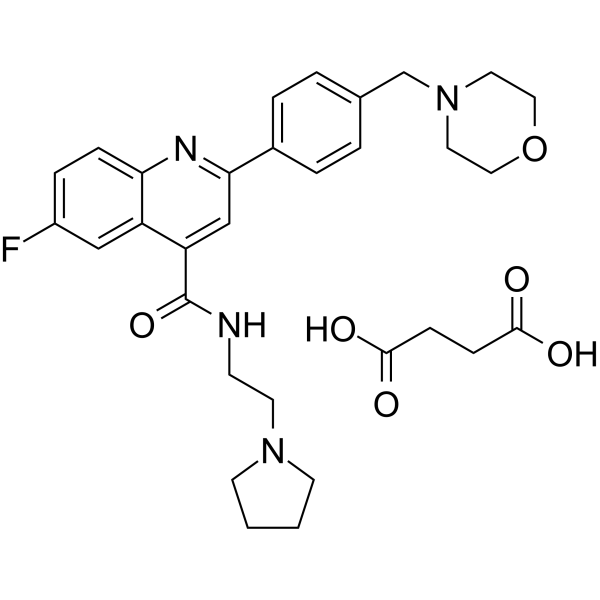
- HY-17589A
-
-
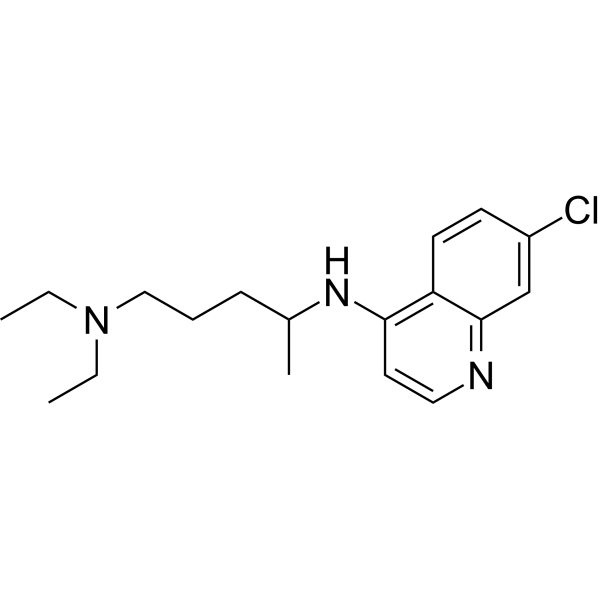
- HY-17589B
-
-
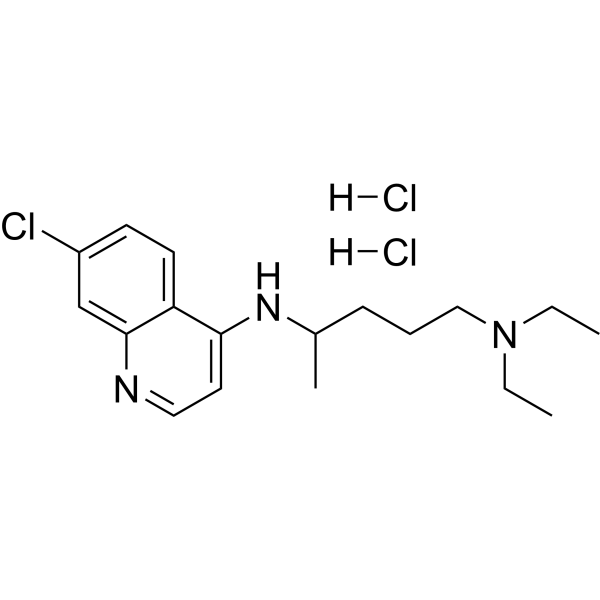
- HY-B1322A
-
-
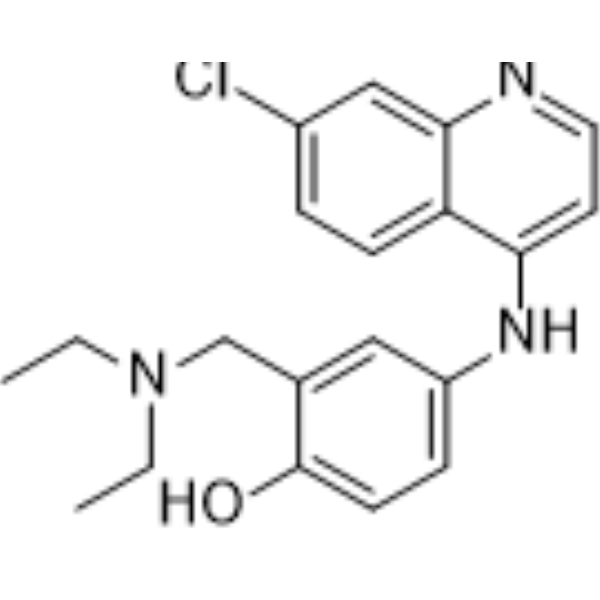
- HY-N8521
-
|
|
TMV
Parasite
|
Infection
|
|
6-O-Methacrylate, a trilobolide, is isolated from the leaves of Wedelia trilobata. 6-O-Methacrylate displays marked antimalarial activity, with IC50 of 8.9 μg/mL against P. falciparum parasite. 6-O-Methacrylate also has anti-tobacco mosaic virus (TMV) activity .
|
-
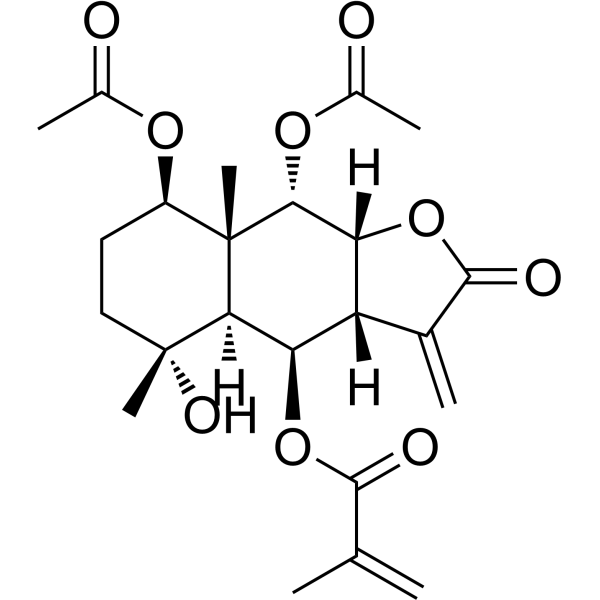
- HY-145379
-
|
|
Parasite
Endogenous Metabolite
|
Infection
|
|
Miaosporone A, an angucyclic quinone, exhibits antimalarial activity against Plasmodium falciparum K1 and antibacterial activity against Mycobacterium tuberculosis with respective IC50 values of 2.5 and 2.4 μM and displays cytotoxic activities against both cancerous (MCF-7 and NCI-H187) and nonmalignant (Vero) cells .
|
-
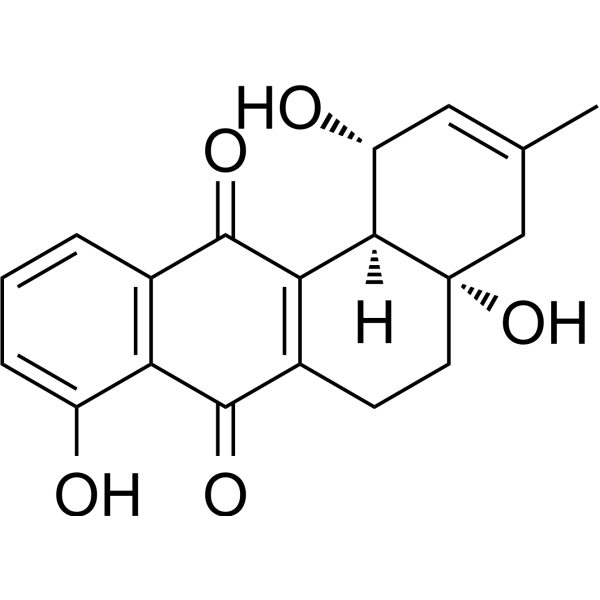
- HY-144297
-
|
|
HDAC
Parasite
|
Infection
|
|
HDAC1-IN-3 is a potent Pf HDAC1 inhibitor. HDAC1-IN-3 shows antimalarial activity in wild-type and multidrug-resistant parasite strains. HDAC1-IN-3 shows a significant in vivo killing effect against all life cycles of parasites .
|
-
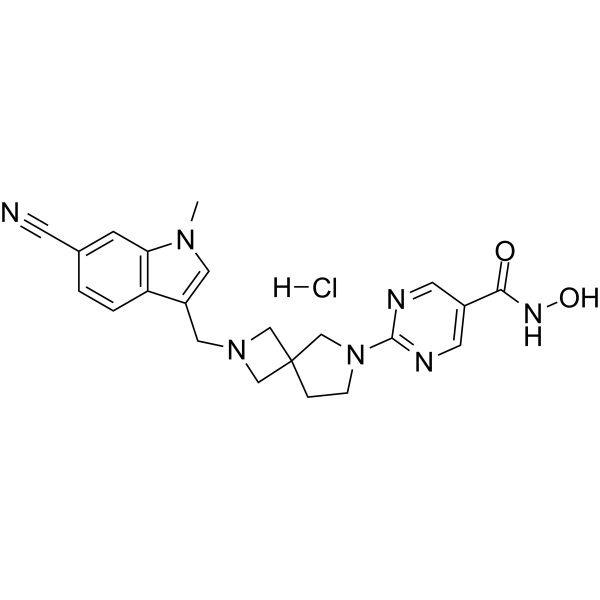
- HY-17437
-
-
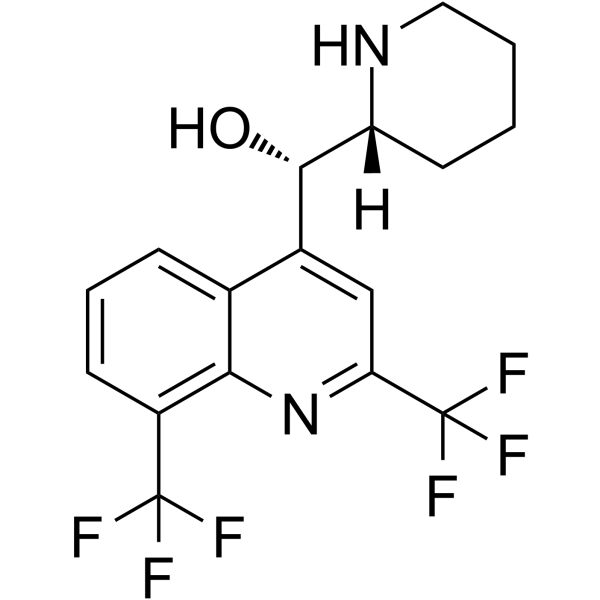
- HY-W031727S1
-
|
|
Autophagy
SARS-CoV
Toll-like Receptor (TLR)
Parasite
|
|
|
Hydroxychloroquine-d5 is the deuterium labeled Hydroxychloroquine[1]. Hydroxychloroquine is a synthetic antimalarial agent which can also inhibit Toll-like receptor 7/9 (TLR7/9) signaling. Hydroxychloroquine is efficiently inhibits SARS-CoV-2 infection in vitro[2][3][4].
|
-
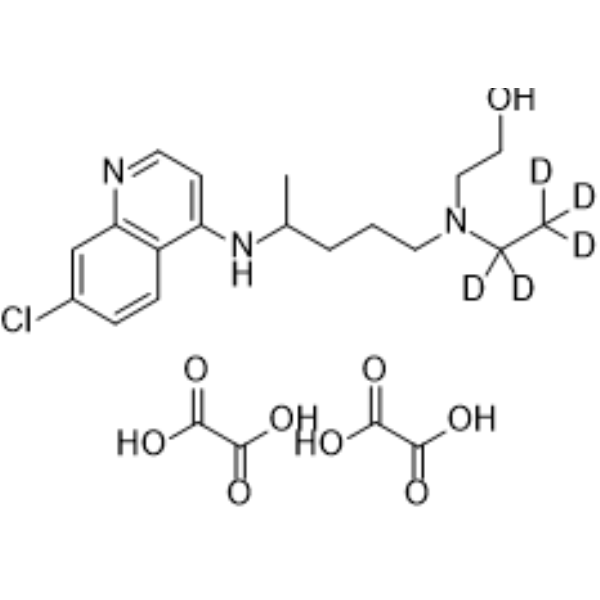
- HY-W795264
-
|
|
Parasite
|
Infection
|
|
FR900098 is an antimalarial agent that inhibits 1-deoxy-d-xylulose-5-phosphate (DXP) reductoisomerase. FR900098 has no significant acute toxicity or genotoxicity, and does not have the ability to cause chromosome breakage or heterogeneity. FR900098 has no effect on bone marrow red blood cells in NMRI mice .
|
-
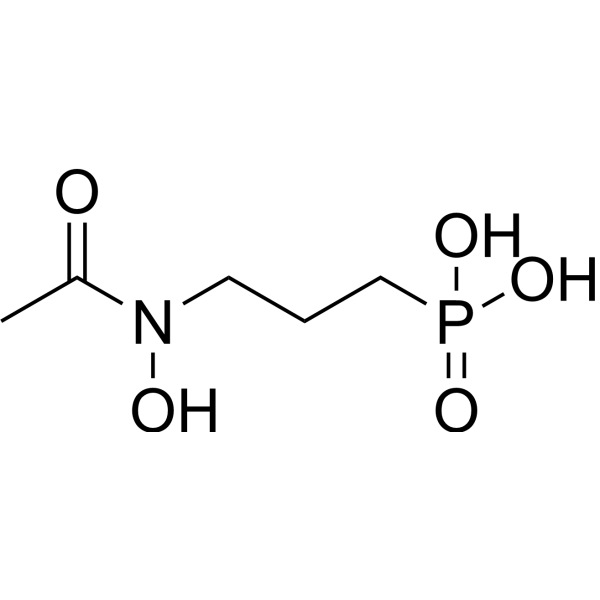
- HY-148178
-
|
|
Parasite
|
Infection
|
|
MMV688533 is an antimalarial agent with rapid anti-plasmodial activity and effective single-dose activity against Plasmodium falciparum infection in humanized mouse models. MMV688533 can inhibit the activity of asexual blood stage parasites with an IC50 value of 1.3 nM. MMV688533 exhibits excellent pharmacokinetic properties and safety .
|
-
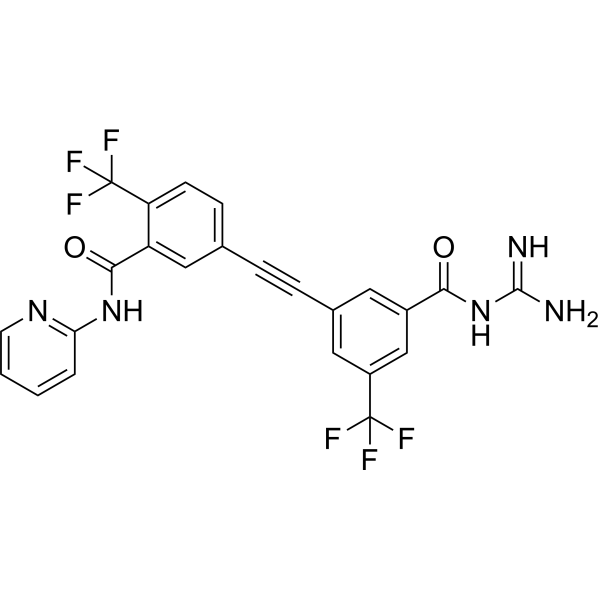
- HY-18062R
-
|
|
Antifolate
Parasite
|
Infection
|
|
Pyrimethamine (Standard) is the analytical standard of Pyrimethamine. This product is intended for research and analytical applications. Pyrimethamine (Pirimecidan) is a potent, orally active dihydrofolate reductase (DHFR) inhibitor. Pyrimethamine is an antimalarial agent. Pyrimethamine affects the nucleoprotein metabolism of malarial parasites by interference in the folic–folinic acid systems and affects cell division by inhibiting the conversion of dihydrofolate to tetrahydrofolate .
|
-

- HY-B1322
-
-

- HY-136429
-
|
Optochin
|
Bacterial
Parasite
|
Infection
|
|
Ethylhydrocupreine (Optochin) is a quinine derivate with antimicrobial activity against S. pneumoniae. Ethylhydrocupreine also possesses antimalarial activity against Plasmodium falciparum, with an IC50 of 25.75 nM. Ethylhydrocupreine is a Gallus gallus taste 2 receptors (ggTas2r1, ggTas2r2 and ggTas2r7) agonist .
|
-

- HY-136429A
-
|
Optochin hydrochloride
|
Bacterial
Parasite
|
Infection
|
|
Ethylhydrocupreine hydrochloride (Optochin hydrochloride) is a quinine derivate with antimicrobial activity against S. pneumoniae. Ethylhydrocupreine hydrochloride also possesses antimalarial activity against Plasmodium falciparum, with an IC50 of 25.75 nM. Ethylhydrocupreine hydrochloride is a Gallus gallus taste 2 receptors (ggTas2r1, ggTas2r2 and ggTas2r7) agonist .
|
-
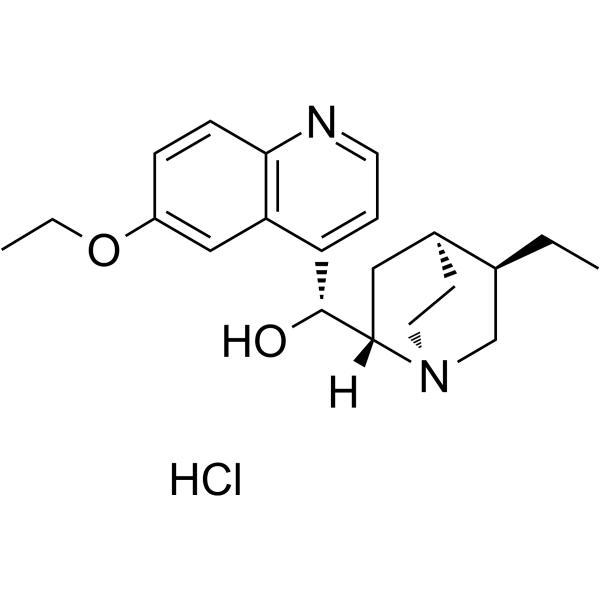
- HY-B1322B
-
-
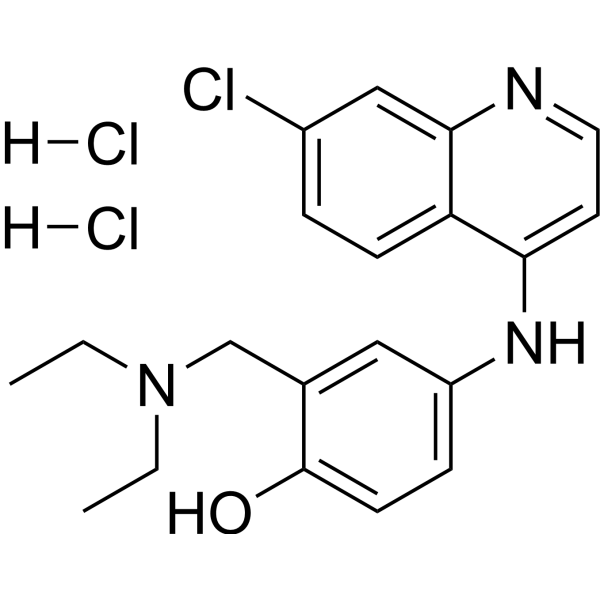
- HY-145431
-
|
|
Epigenetic Reader Domain
Parasite
|
Infection
|
|
(S)-GSK1379725A (compound AU1) is a selective bromodomain and PHD finger containing transcription factor (BPTF) bromodomain inhibitor with a Kd of 2.8 μM. (S)-GSK1379725A shows to be selective for BPTF over BRD4 bromodomain. (S)-GSK1379725A shows antimalarial activity .
|
-
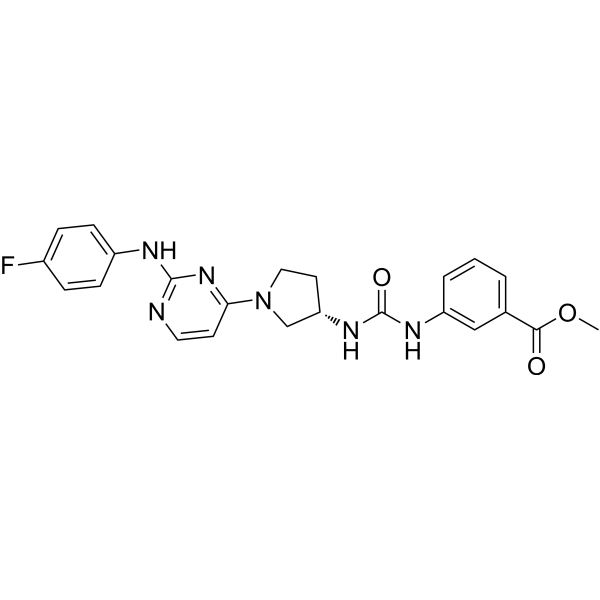
- HY-122817
-
|
|
Antibiotic
Parasite
|
Infection
|
|
FR900098 sodium is an antimalarial agent that inhibits 1-deoxy-d-xylulose-5-phosphate (DXP) reductoisomerase. FR900098 sodium has no significant acute toxicity or genotoxicity, and does not have the ability to cause chromosome breakage or heterogeneity. FR900098 sodium has no effect on bone marrow red blood cells in NMRI mice .
|
-

- HY-B1370S
-
|
HCQ-d4 (sulfate)
|
Parasite
Toll-like Receptor (TLR)
SARS-CoV
Autophagy
|
Infection
Cancer
|
|
Hydroxychloroquine-d4 (sulfate) is the deuterium labeled Hydroxychloroquine sulfate. Hydroxychloroquine sulfate (HCQ sulfate) is a synthetic antimalarial agent which can also inhibit Toll-like receptor 7/9 (TLR7/9) signaling. Hydroxychloroquine sulfate is efficiently inhibits SARS-CoV-2 infection in vitro[1][2][3].
|
-

- HY-135810
-
|
Desethylhydroxychloroquine
|
Influenza Virus
Parasite
|
Infection
Inflammation/Immunology
|
|
Cletoquine (Desethylhydroxychloroquine) is a major active metabolite of Hydroxychloroquine. Cletoquine is produced in the liver by CYP2D6, CYP3A4, CYP3A5, and CYP2C8 isoenzymes. Cletoquine is also a Chloroquine derivative and has the ability to against the chikungunya virus (CHIKV). Cletoquine has antimalarial effects and has the potential for autoimmune diseases treatment .
|
-
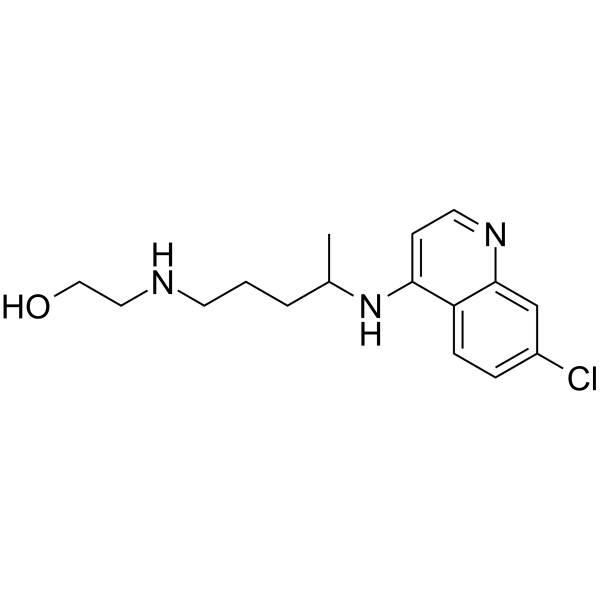
- HY-Y0152A
-
|
(8R,9S)-Cinchonine monohydrochloride hydrate; LA40221 monohydrochloride hydrate
|
Parasite
Apoptosis
|
Infection
Cardiovascular Disease
Metabolic Disease
Cancer
|
|
Cinchonine ((8R,9S)-Cinchonine) monohydrochloride hydrate is a natural compound which has been effectively used as antimalarial agent. Cinchonine monohydrochloride hydrate activates endoplasmic reticulum stress-induced apoptosis in human liver cancer cells. Cinchonine monohydrochloride hydrate is also an inhibitor of human platelet aggregation. Cinchonine monohydrochloride hydrate possesses a suppressive effect on adipogenesis .
|
-

- HY-13832
-
|
Atavaquone
|
Parasite
Cytochrome P450
Antibiotic
Bacterial
|
Infection
Cancer
|
|
Atovaquone (Atavaquone) is a potent, selective and orally active inhibitor of the parasite’s mitochondrial cytochrome bc1 complex. Atovaquone is against human and P. falciparum cytochrome bc1 activity with IC50 values of 460 nM and 2.0 nM, respectively. Atovaquone is an antimalarial agent and has the potential for the investigation of neumocystis pneumonia, toxoplasmosis, malaria, and babesia .
|
-
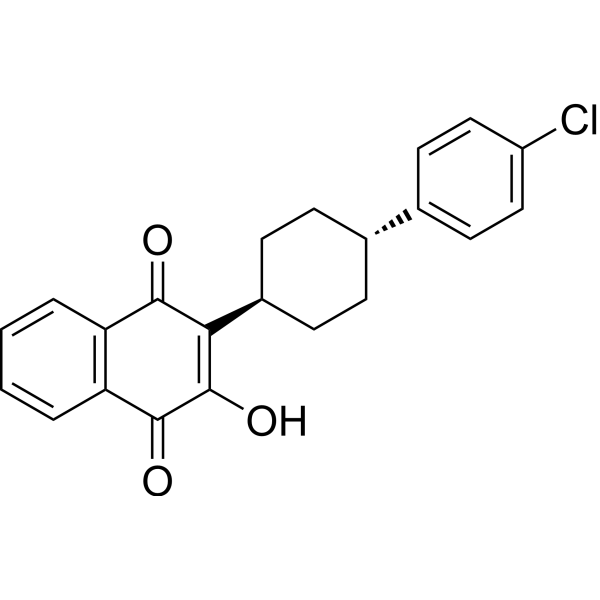
- HY-B1370R
-
|
HCQ sulfate (Standard)
|
Parasite
Toll-like Receptor (TLR)
SARS-CoV
Autophagy
|
Infection
Cancer
|
|
Hydroxychloroquine (sulfate) (Standard) is the analytical standard of Hydroxychloroquine (sulfate). This product is intended for research and analytical applications. Hydroxychloroquine sulfate (HCQ sulfate) is a synthetic antimalarial agent which can also inhibit Toll-like receptor 7/9 (TLR7/9) signaling. Hydroxychloroquine sulfate is efficiently inhibits SARS-CoV-2 infection in vitro .
|
-
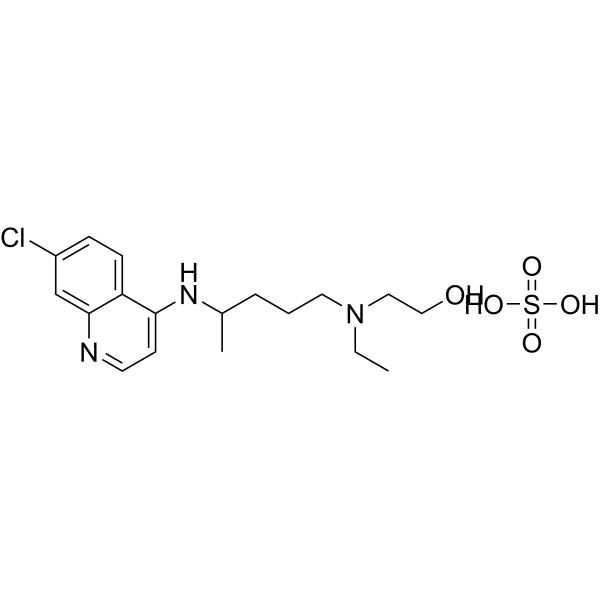
- HY-156028
-
|
|
Parasite
|
Infection
|
|
FIKK9.1-IN-1 (Compound 1) is a FIKK9.1 inhibitor. FIKK9.1-IN-1 interacts with the ATP?binding residues in FIKK9.1. FIKK9.1-IN-1 is an antimalarial agent (IC50: 2.68 μg/mL) and disrupts the parasite life cycle and leads to the death of parasites .
|
-

- HY-B1322AS
-
|
|
Parasite
Histone Methyltransferase
|
Infection
Neurological Disease
Inflammation/Immunology
|
|
Amodiaquine-d10 is the deuterium labeled Amodiaquine. Amodiaquine (Amodiaquin), a 4-aminoquinoline class of antimalarial agent, is a potent and orally active histamine N-methyltransferase inhibitor. Amodiaquine is also a Nurr1 agonist and specifically binds to Nurr1-LBD (ligand binding domain) with an EC50 of ~20 μM. Anti-inflammatory effect[1][2][3][4].
|
-
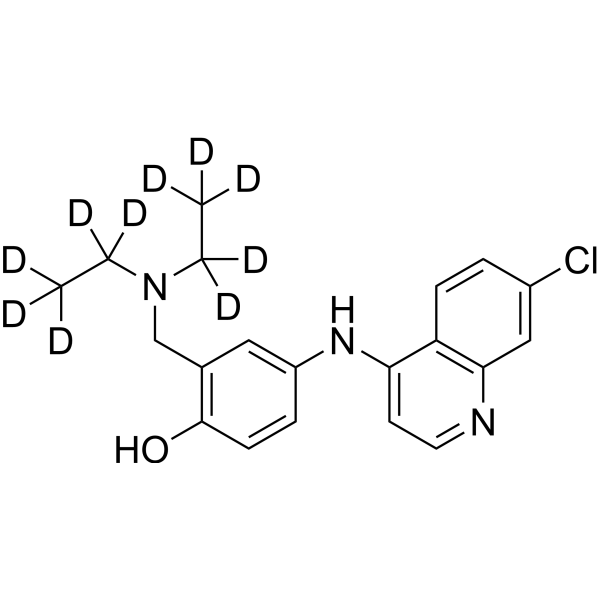
- HY-N0173
-
|
α-Quinidine
|
Serotonin Transporter
Parasite
|
Infection
|
|
Cinchonidine (α-Quinidine) is a cinchona alkaloid found in Cinchona officinalis and Gongronema latifolium. A building block used in asymmetric synthesis in organic chemistry. Weak inhibitor of serotonin transporter (SERT) with Kis of 330, 4.2, 36, 196, 15 μM for dSERT, hSERT, hSERT I172M, hSERT S438T, hSERT Y95F, respectively. Antimalarial activities .
|
-
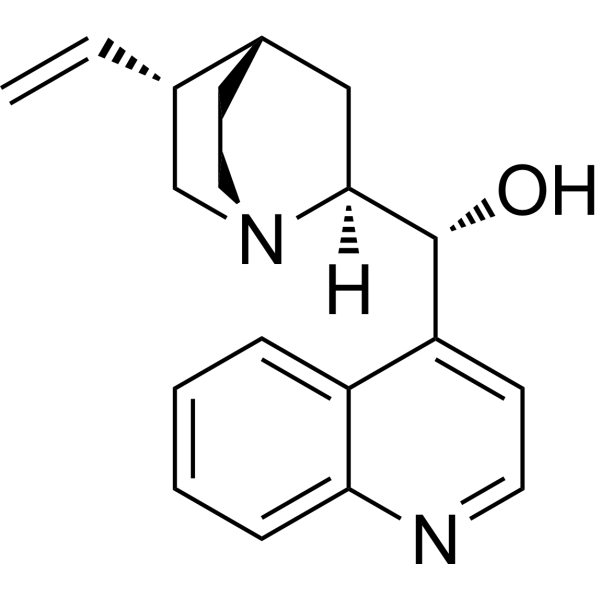
- HY-128204
-
AN3661
1 Publications Verification
|
Parasite
|
Infection
|
|
AN3661, a potent antimalarial lead compound, targets a Plasmodium falciparum cleavage and polyadenylation specificity factor homologue subunit 3 (PfCPSF3). AN3661 inhibits Plasmodium falciparum laboratory-adapted strains (mean IC50=32 nM), Ugandan field isolates (mean ex vivo IC50=64 nM), and murine P. berghei and P. falciparum infections .
|
-

- HY-W031727
-
|
|
Parasite
Toll-like Receptor (TLR)
SARS-CoV
Autophagy
|
Infection
Cancer
|
|
Hydroxychloroquine (HCQ) is a synthetic oral antimalarial drug that can be used in the study of malaria and autoimmune diseases such as systemic lupus erythematosus and rheumatoid arthritis. Hydroxychloroquine is a potent autophagic flux inhibitor with antiviral activity (such as SARS-CoV-2 virus) that inhibits Toll-like receptor 7/9 (TLR7/9) signaling .
|
-
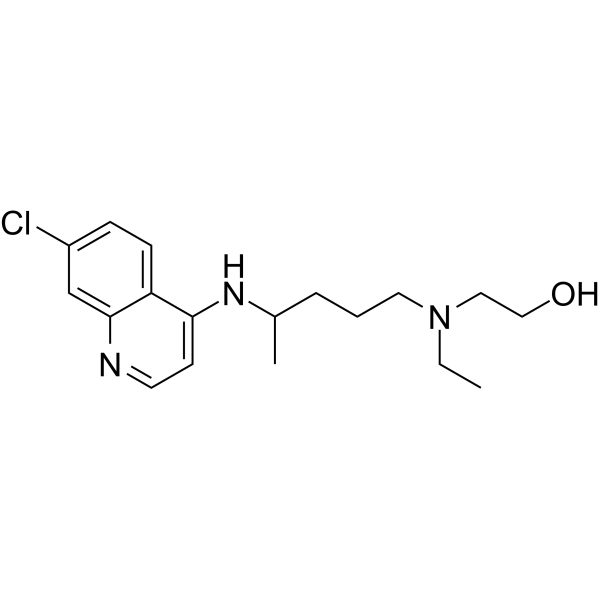
- HY-17589AS
-
-

- HY-17589S1
-
-

- HY-W112166
-
|
|
Others
|
Infection
|
|
(E/Z)-4,4'-Dicyanostilbene is the isomer of 4,4'-Dicyanostilbene (HY-W112166A), and can be used as an experimental control. 4,4'-Dicyanostilbene (compound 43) is a potent antimalarial agent against the Dd2 strain, with an EC50 of 27 nM. 4,4'-Dicyanostilbene exhibits in vivo efficacy against methicillin-resistant Staphylococcus aureus (MRSA) .
|
-
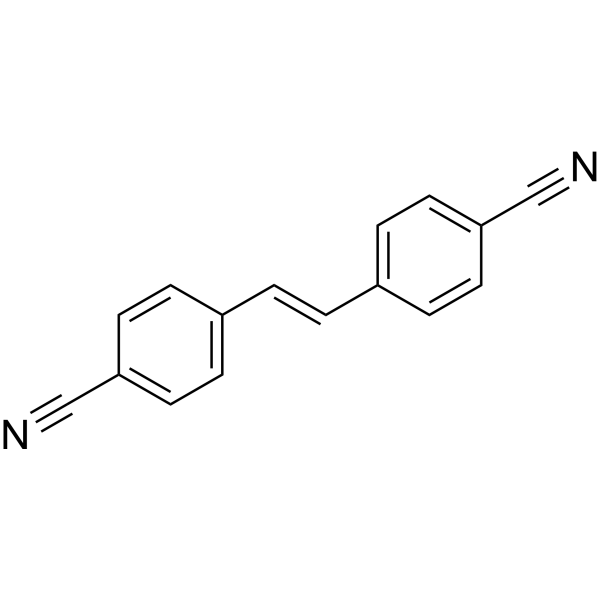
- HY-17589S
-
-

- HY-135810A
-
|
Desethylhydroxychloroquine oxalate
|
Influenza Virus
Parasite
|
Infection
Inflammation/Immunology
|
|
Cletoquine oxalate (Desethylhydroxychloroquine oxalate) is a major active metabolite of Hydroxychloroquine. Cletoquine oxalate is produced in the liver by CYP2D6, CYP3A4, CYP3A5, and CYP2C8 isoenzymes. Cletoquine oxalate is also a Chloroquine derivative and has the ability to against the chikungunya virus (CHIKV). Cletoquine oxalate has antimalarial effects and has the potential for autoimmune diseases treatment .
|
-

- HY-17589R
-
|
|
Parasite
Autophagy
SARS-CoV
Toll-like Receptor (TLR)
HIV
Antibiotic
|
Infection
Inflammation/Immunology
Cancer
|
|
Chloroquine (phosphate) (Standard) is the analytical standard of Chloroquine (phosphate). This product is intended for research and analytical applications. Chloroquine phosphate is an antimalarial and anti-inflammatory agent widely used to treat malaria and rheumatoid arthritis. Chloroquine phosphate is an autophagy and toll-like receptors (TLRs) inhibitor. Chloroquine phosphate is highly effective in the control of SARS-CoV-2 (COVID-19) infection in vitro (EC50=1.13 μM) .
|
-
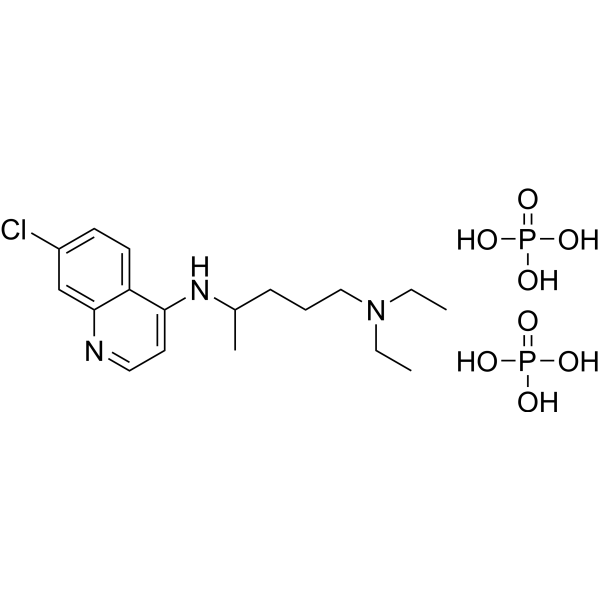
- HY-B1322AS1
-
-
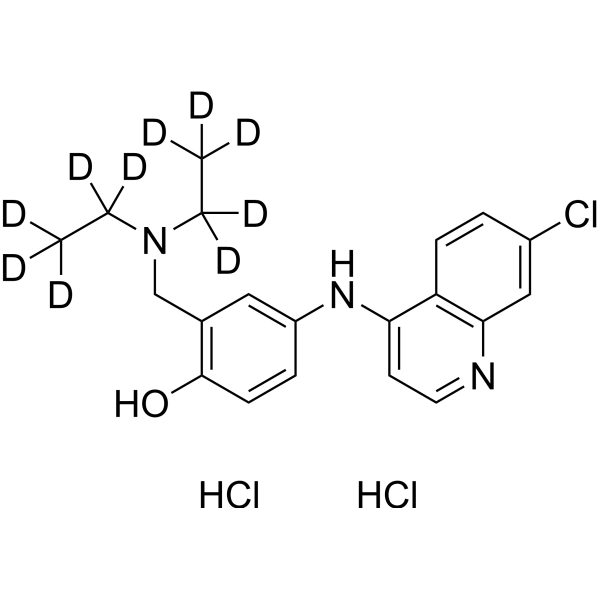
- HY-17589AR
-
|
|
Parasite
Autophagy
SARS-CoV
Toll-like Receptor (TLR)
HIV
Antibiotic
|
Infection
Inflammation/Immunology
Cancer
|
|
Chloroquine (Standard) is the analytical standard of Chloroquine. This product is intended for research and analytical applications. Chloroquine is an antimalarial and anti-inflammatory agent widely used to treat malaria and rheumatoid arthritis. Chloroquine is an autophagy and toll-like receptors (TLRs) inhibitor. Chloroquine is highly effective in the control of SARS-CoV-2 (COVID-19) infection in vitro (EC50=1.13 μM) .
|
-

- HY-N2416
-
|
|
Microtubule/Tubulin
Apoptosis
|
Cancer
|
|
Taccalonolide A is a microtubule stabilizer, which is a steroid isolated from Tacca chantrieri, with cytotoxic and antimalarial activities . Taccalonolide A causes G2-M accumulation, Bcl-2 phosphorylation and initiation of apoptosis . Taccalonolide A is effective in vitro against cell lines that overexpress P-glycoprotein (Pgp) and multidrug resistance protein 7 (MRP7), with an IC50 of 622 nM for SK-OV-3 cells .
|
-
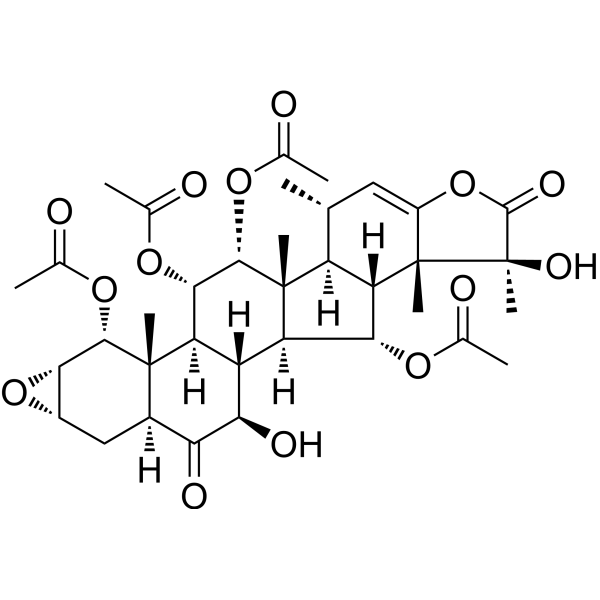
- HY-B1359
-
|
C.I. Basic Blue 9 trihydrate
|
Guanylate Cyclase
Monoamine Oxidase
NO Synthase
Parasite
|
Infection
Neurological Disease
Cancer
|
|
Methylene blue trihydrate (C.I. Basic Blue 9 trihydrate) is a guanylyl cyclase (sGC), monoamine oxidase A (MAO-A) and NO synthase (NOS) inhibitor. Methylene blue trihydrate is a vasopressor and is often used as a dye in several medical procedures. Methylene blue trihydrate has antinociception, antimalarial, antidepressant and anxiolytic activity effects. Methylene Blue trihydrate has the potential for methemoglobinemias, neurodegenerative disorders and ifosfamide-induced encephalopathytreatment .
|
-

- HY-135810S
-
|
Desethylhydroxychloroquine-d4
|
Isotope-Labeled Compounds
Influenza Virus
Parasite
|
Infection
Inflammation/Immunology
|
|
Cletoquine-d4 is deuterium labeled Cletoquine. Cletoquine (Desethylhydroxychloroquine) is a major active metabolite of Hydroxychloroquine. Cletoquine is produced in the liver by CYP2D6, CYP3A4, CYP3A5, and CYP2C8 isoenzymes. Cletoquine is also a Chloroquine derivative and has the ability to against the chikungunya virus (CHIKV). Cletoquine has antimalarial effects and has the potential for autoimmune diseases treatment[1][2].
|
-

- HY-16438
-
|
|
Apoptosis
Parasite
|
Infection
Inflammation/Immunology
Cancer
|
|
RRx-001, a hypoxia-selective epigenetic agent and studied as a radio- and chem-sensitizer, triggers apoptosis and overcomes agent resistance in myeloma. RRx-001 exhibits potent anti-tumor activity with minimal toxicity . RRx-001 is a dual small molecule checkpoint inhibitor by downregulating CD47 and SIRP-α . RRx-001 is a potent inhibitor of G6PD and shows potent antimalarial activity .
|
-

- HY-106005
-
|
|
Parasite
PI4K
|
Infection
|
|
MMV390048 is a representative of a new chemical class of Plasmodium PI4K inhibitor (Kd app=0.3 µM). MMV390048 binds to the ATP binding site of Plasmodium PI4K and does not bind to other P. falciparum and human kinases apart from human PIP4K2C, thus alleviating potential kinase-mediated safety concerns. MMV390048 is an antimalarial agent .
|
-
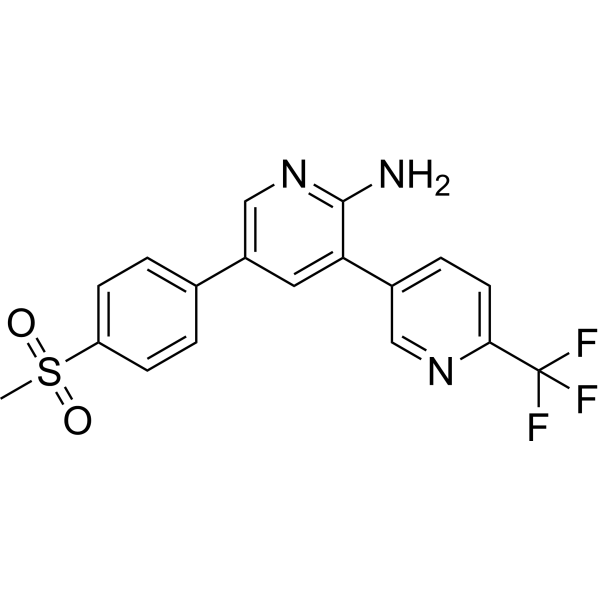
- HY-13832S2
-
|
Atavaquone-d5
|
Isotope-Labeled Compounds
Parasite
Cytochrome P450
Antibiotic
|
Infection
|
|
Atovaquone-d5 is the deuterium labeled Atovaquone. Atovaquone (Atavaquone) is a potent, selective and orally active inhibitor of the parasite’s mitochondrial cytochrome bc1 complex. Atovaquone is against human and P. falciparum cytochrome bc1 activity with IC50 values of 460 nM and 2.0 nM, respectively. Atovaquone is an antimalarial agent and has the potential for the investigation of neumocystis pneumonia, toxoplasmosis, malaria, and babesia[1][2].
|
-

- HY-108251
-
|
DAMPA
|
Antifolate
Drug Metabolite
Dihydrofolate reductase (DHFR)
Parasite
|
Infection
Inflammation/Immunology
|
|
Methotrexate metabolite (DAMPA), the active metabolite of Methotrexate. Methotrexate is a folic acid antagonist that is widely used as an immunosuppressant and chemotherapeutic agent . Methotrexate metabolite is an antimalarial agent, which inhibits the parasite growth with an IC50 of 446 nM against the antifolate-sensitive strain and 812 nM against the highly resistant strain under physiological folate conditions. Methotrexate metabolite is inactive against mammalian cells. Methotrexate metabolite is a minimal inhibitor of dihydrofolate reductase among metabolites of methotrexate .
|
-
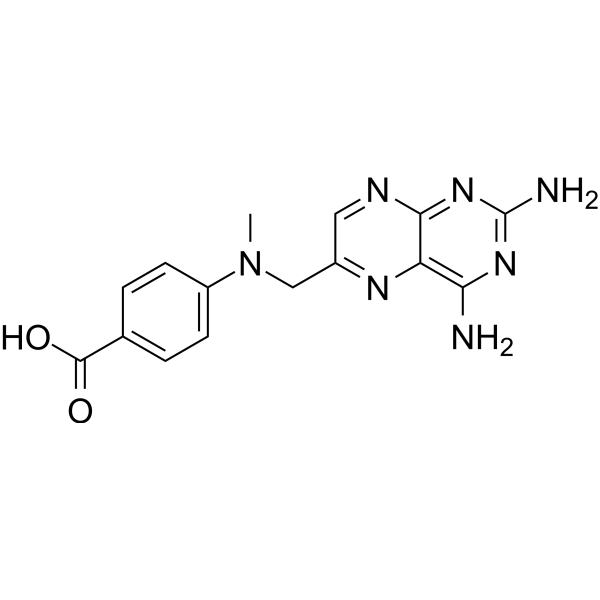
- HY-N6769
-
|
Monorden
|
HSP
Bacterial
Antibiotic
Parasite
|
Infection
|
|
Radicicol is an inhibitor of Hsp90 with an IC50 value < 1 μM, and leads to proteasomal degradation . Radicicol exhibits inhibition on PDK with IC50s of 230 μM (PDK1) and 400 μM (PDK3). Radicicol is an antifungal and antimalarial antibiotic, impairs mitochondrial replication by targeting P. falciparum topoisomerase VIB . Radicicol is also an inhibitor of fat mass and obesity-associated protein (FTO), with an IC50 value of 16.04 μM .
|
-
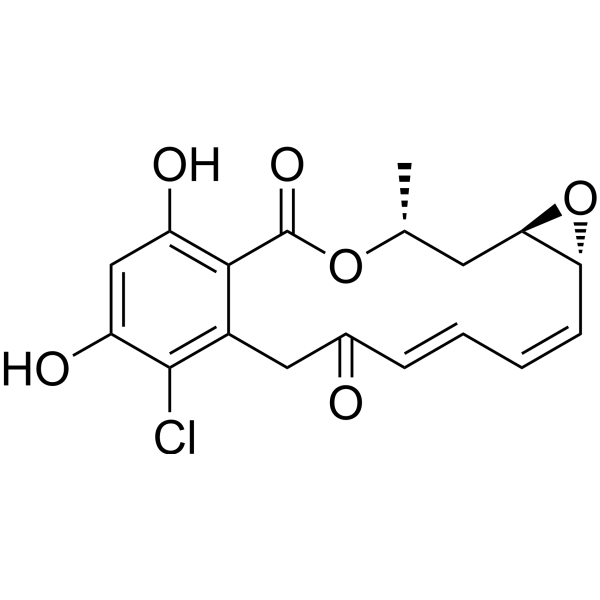
- HY-135855
-
|
|
SARS-CoV
Parasite
|
Infection
|
|
SARS-CoV-IN-1 is an effective inhibitor of SARS-CoV replication. SARS-CoV-IN-1 shows anti-Coronavirus activity with an EC50 of 4.9 μM in Vero cells. SARS-CoV-IN-1 inhibits the 3D7 and W2 strains of P. falciparum with IC50s of 15.4 and 133.2 nM; and IC90s of 25.7 and 459.1 nM; respectively. Antimalarial and antiviral activities .
|
-
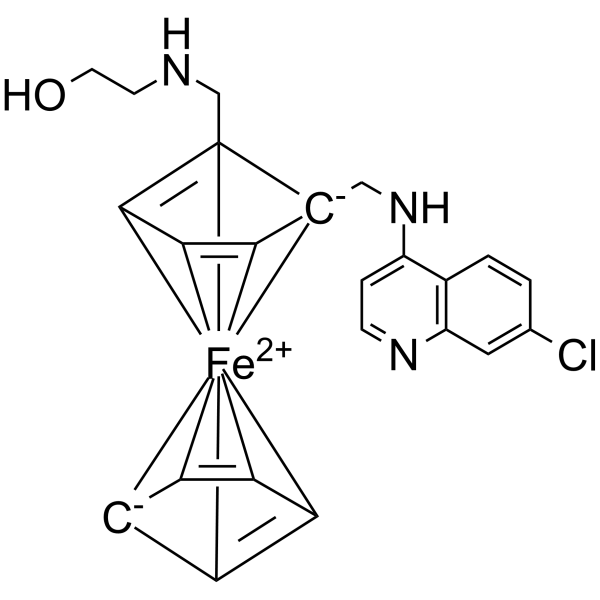
- HY-117025A
-
|
Keramamine A hydrochloride
|
GSK-3
CDK
Parasite
Proton Pump
HSV
Autophagy
|
Infection
Neurological Disease
Cancer
|
|
Manzamine A hydrochloride, an orally active beta-carboline alkaloid, inhibits specifically GSK-3β and CDK-5 with IC50s of 10.2 μM and 1.5 μM, respectively. Manzamine A hydrochloride targets vacuolar ATPases and inhibits autophagy in pancreatic cancer cells. Manzamine A hydrochloride has antimalarial and anticancer activities. Manzamine A hydrochloride also shows potent activity against HSV-1 .
|
-
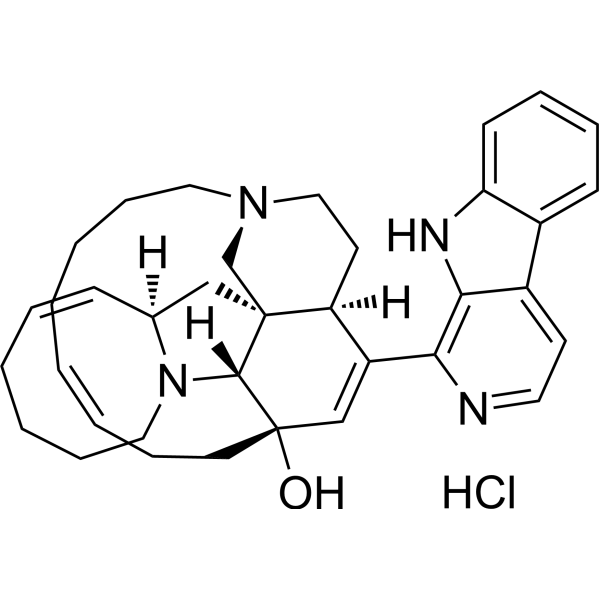
- HY-135810S1
-
|
Desethylhydroxychloroquine-d4-1
|
Isotope-Labeled Compounds
Influenza Virus
Parasite
|
Infection
Inflammation/Immunology
|
|
Cletoquine-d4-1 is the deuterium labeled Cletoquine. Cletoquine (Desethylhydroxychloroquine) is a major active metabolite of Hydroxychloroquine. Cletoquine is produced in the liver by CYP2D6, CYP3A4, CYP3A5, and CYP2C8 isoenzymes. Cletoquine is also a Chloroquine derivative and has the ability to against the chikungunya virus (CHIKV). Cletoquine has antimalarial effects and has the potential for autoimmune diseases treatment[1][2].
|
-

- HY-13832S3
-
|
cis-Atavaquone-d4
|
Isotope-Labeled Compounds
Parasite
Cytochrome P450
Antibiotic
|
Infection
|
|
cis-Atovaquone-d4 is deuterium labeled Atovaquone. Atovaquone (Atavaquone) is a potent, selective and orally active inhibitor of the parasite’s mitochondrial cytochrome bc1 complex. Atovaquone is against human and P. falciparum cytochrome bc1 activity with IC50 values of 460 nM and 2.0 nM, respectively. Atovaquone is an antimalarial agent and has the potential for the investigation of neumocystis pneumonia, toxoplasmosis, malaria, and babesia[1][2].
|
-

- HY-117025
-
|
Keramamine A
|
GSK-3
CDK
Parasite
Proton Pump
HSV
Autophagy
|
Infection
Neurological Disease
Cancer
|
|
Manzamine A, an orally active beta-carboline alkaloid, inhibits specifically GSK-3β and CDK-5 with IC50s of 10.2 μM and 1.5 μM, respectively. Manzamine A targets vacuolar ATPases and inhibits autophagy in pancreatic cancer cells. Manzamine A has antimalarial and anticancer activities. Manzamine A also shows potent activity against HSV-1 .
|
-

- HY-B1322R
-
|
|
Nuclear Hormone Receptor 4A/NR4A
Parasite
Histone Methyltransferase
|
Infection
Neurological Disease
Inflammation/Immunology
|
|
Amodiaquine (dihydrochloride dihydrate) (Standard) is the analytical standard of Amodiaquine (dihydrochloride dihydrate). This product is intended for research and analytical applications. Amodiaquine dihydrochloride dihydrate (Amodiaquin dihydrochloride dihydrate), a 4-aminoquinoline class of antimalarial agent, is a potent and orally active histamine N-methyltransferase inhibitor. Amodiaquine dihydrochloride dihydrate is also a Nurr1 agonist and specifically binds to Nurr1-LBD (ligand binding domain) with an EC50 of ~20 μM. Anti-inflammatory effect .
|
-

- HY-13832R
-
|
|
Parasite
Cytochrome P450
Antibiotic
Bacterial
|
Infection
Cancer
|
|
Atovaquone (Standard) is the analytical standard of Atovaquone. This product is intended for research and analytical applications. Atovaquone (Atavaquone) is a potent, selective and orally active inhibitor of the parasite’s mitochondrial cytochrome bc1 complex. Atovaquone is against human and P. falciparum cytochrome bc1 activity with IC50 values of 460 nM and 2.0 nM, respectively. Atovaquone is an antimalarial agent and has the potential for the investigation of neumocystis pneumonia, toxoplasmosis, malaria, and babesia .
|
-

- HY-N0790
-
Lupeol
3 Publications Verification
Clerodol; Monogynol B; Fagarasterol
|
Androgen Receptor
Apoptosis
|
Cancer
|
|
Lupeol (Clerodol; Monogynol B; Fagarasterol) is an active pentacyclic triterpenoid, has anti-oxidant, anti-mutagenic, anti-tumor and anti-inflammatory activity. Lupeol is a potent androgen receptor (AR) inhibitor and can be used for cancer research, especially prostate cancer of androgen-dependent phenotype (ADPC) and castration resistant phenotype (CRPC) .
|
-

- HY-N6742
-
|
Treponemycin
|
CDK
Parasite
Apoptosis
Antibiotic
|
Infection
|
|
Borrelidin (Treponemycin) is a bacterial and eukaryal threonyl-tRNA synthetase inhibitor which is a nitrile-containing macrolide antibiotic isolated from Streptomyces rochei . Borrelidin is an inhibitor of Cdc28/Cln2 of the budding yeast, with an IC50 of 24 μM . Borrelidin is a potent angiogenesis inhibitor, with an IC50 of 0.8 nM. Borrelidin induces apoptosis in the tube-forming cells . Borrelidin has strong antimalarial activities, with IC50s of 1.9 nM and 1.8 nM against K1 and FCR3 strains of Plasmodium falciparum, respectively .
|
-
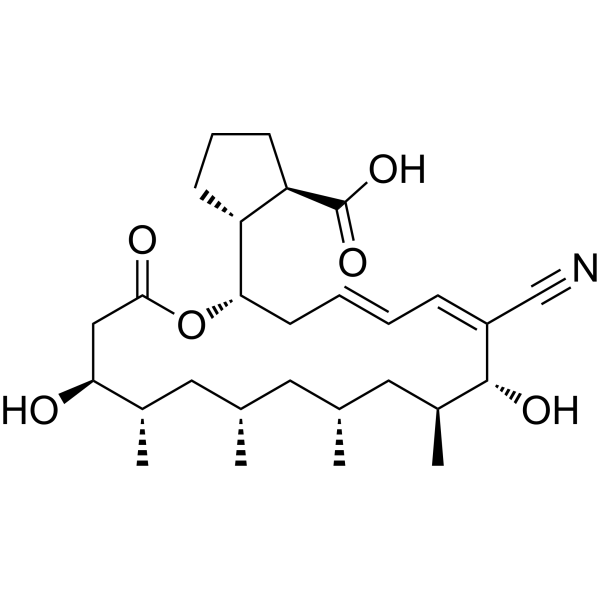
- HY-W020111
-
|
|
Sirtuin
Parasite
|
Infection
|
|
7-Chloro-4-(piperazin-1-yl)quinolone is an important scaffold in medicinal chemistry. 7-Chloro-4-(piperazin-1-yl)quinolone is a potent sirtuin inhibitor and also inhibits the serotonin uptake (IC50 of 50 μM). 7-Chloro-4-(piperazin-1-yl)quinolone exhibits antimalarial activity on D10 and K1 strains of P. falciparum with IC50s of 1.18 μM and 0.97 μM, respectively .
|
-
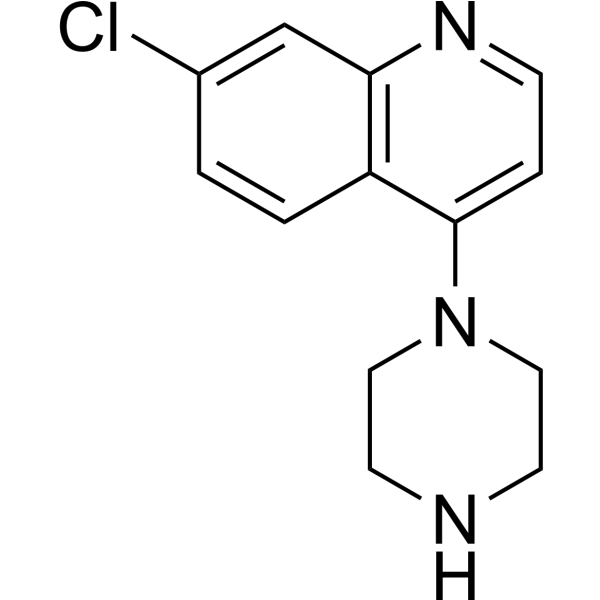
- HY-135856
-
|
|
SARS-CoV
Parasite
HIV
|
Infection
|
|
SARS-CoV-IN-2 is an effective inhibitor of SARS-CoV replication. SARS-CoV-IN-2 shows anti-Coronavirus activity with an EC50 of 1.9 μM in Vero cells. SARS-CoV-IN-2 inhibits the 3D7 and W2 strains of P. falciparum with IC50s of 21.5 and 30 nM; and IC90s of 51.0 and 99.9 nM; respectively. SARS-CoV-IN-2 reduces HIV-1-induced cytopathic effect with an EC50 of 2.9 μM in MT-4 cells. Antimalarial and Antiviral Activities .
|
-

- HY-155846
-
|
|
Parasite
Bacterial
|
Infection
|
|
Antileishmanial agent-22 (compound 15b) is a parasite inhibitor and an antibacterial agent, with antileishmanial, antimalarial, and anti-tubercular activities. Antileishmanial agent-22 inhibits leishmanial (IC50=0.408 μM) based on antifolate mechanism. And, Antileishmanial agent-22 inhibits Folic acid and Folinic acid at 100 μM with inhibitory rates of 88% and 94%, respectively. Antileishmanial agent-22 inhibits P. berghei in vivo and in vitro, with 96.67% suppression under 48.4 μM/kg/day and 0.038 μM (IC50), respectively. Moreover, Antileishmanial agent-22 inhibits M. tuberculosis with MIC of 28.44 μM .
|
-
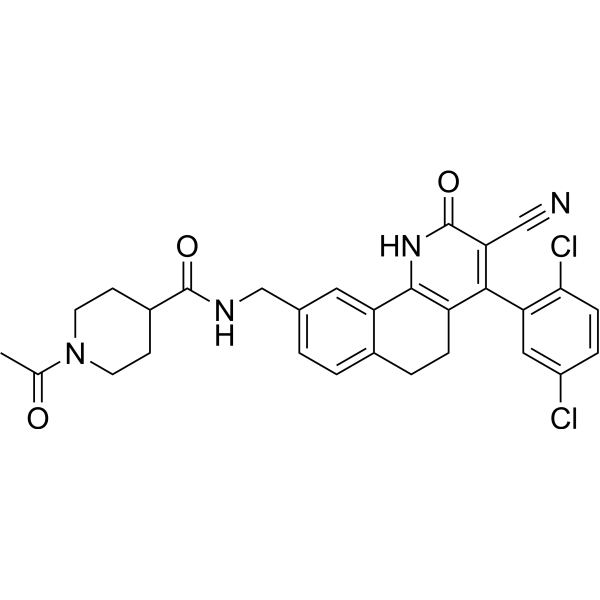
| Cat. No. |
Product Name |
Type |
| Cat. No. |
Product Name |
Target |
Research Area |
-
- HY-P2261
-
|
|
PKA
|
Infection
|
|
STAD 2 is a potent and selective disruptor of PKA-RII, with a Kd of 6.2 nM. STAD 2 disrupts interactions between PKA and AKAP in an isoform-selective manner. STAD 2 displays antimalarial activity through a PKA-independent mechanism .
|
-
- HY-P3914
-
|
Oct-CA(1-7)M(2-9)
|
Bacterial
|
Infection
|
|
Cecropin A (1-7)-Melittin A (2-9) is an antimicrobial peptide with antimicrobial activity against a broad spectrum of Gram-positive and Gram-negative aerobic bacteria, as well as antimalarial activity, without the adverse hemolytic properties of bee venom peptides .
|
-
- HY-P10338
-
| Cat. No. |
Product Name |
Category |
Target |
Chemical Structure |
-
- HY-B0433A
-
-

-
- HY-N2899
-
-

-
- HY-N2900
-
-

-
- HY-N2903
-
-

-
- HY-D0143A
-
-

-
- HY-B0433B
-
-

-
- HY-W010668
-
|
|
Source classification
Plants
|
Flavivirus
Dengue virus
Parasite
Potassium Channel
|
|
Quinine sulfate hydrate (2:1:4) is an orally active alkaloid extracted from cinchona bark and can be used in anti-malarial studies. Quinine sulfate hydrate (2:1:4) is a potassium channel inhibitor that inhibits WT mouse Slo3 (KCa5.1) channel currents evoked by voltage pulses to +100 mV with an IC50 of 169 μM .
|
-

-
- HY-13557
-
-

-
- HY-N0402
-
-

-
- HY-N7030
-
|
|
Infection
Structural Classification
Flavonoids
Classification of Application Fields
Flavones
Source classification
Rutaceae
Plants
Disease Research Fields
Murraya exotica L. Mant.
|
Fungal
Parasite
Bacterial
|
|
5,7,3',4'-Tetramethoxyflavone, an orally active polymethoxyflavones (PMFs) that can be isolated from M. exotica, possesses various bioactivities, including anti-fungal, anti-malarial, anti-mycobacterial, and anti-inflammatory activities. 5,7,3',4'-Tetramethoxyflavone exhibits chondroprotective activity by targeting β-catenin signaling .
|
-

-
- HY-N2281
-
-

-
- HY-10529
-
-

-
- HY-N12077
-
-

-
- HY-107566
-
-

-
- HY-B0094
-
-

-
- HY-N1074
-
-

-
- HY-N1457
-
-

-
- HY-N0674A
-
-

-
- HY-N0674
-
-

-
- HY-N0498
-
-

-
- HY-N0674B
-
-

-
- HY-N4238
-
-

-
- HY-N3957
-
-

-
- HY-118494
-
-

-
- HY-N4106
-
-

-
- HY-N2384
-
-

-
- HY-N2384A
-
-

-
- HY-N0352
-
-

-
- HY-N12276
-
-

-
- HY-N5029
-
-

-
- HY-N1075
-
-

-
- HY-W007771
-
-

-
- HY-121002
-
-

-
- HY-N0176A
-
-

-
- HY-124301
-
-

-
- HY-N7190
-
-

-
- HY-N9438
-
-

-
- HY-N7634
-
-

-
- HY-N7314
-
-

-
- HY-N0941
-
-

-
- HY-N2753
-
-

-
- HY-N7281
-
-

-
- HY-N8338
-
-

-
- HY-N8455
-
-

-
- HY-N12700
-
-

-
- HY-N0978
-
-

-
- HY-N2759
-
-

-
- HY-N8345
-
-

-
- HY-N7512
-
-

-
- HY-N10368
-
-

- HY-100711
-
-

- HY-N1678
-
-

- HY-N1984
-
-

- HY-N2876
-
-

- HY-W011241
-
-

- HY-100711A
-
-

- HY-N12151
-
-

- HY-N7173
-
-

- HY-B0770
-
-

- HY-N5018
-
-

- HY-N3283
-
-

- HY-N8285
-
-

- HY-114489A
-
-

- HY-114489B
-
-

- HY-120607
-
-

- HY-106338
-
-

- HY-N7516
-
-

- HY-126601
-
-

- HY-N7926
-
-

- HY-N2208
-
-

- HY-120104
-
-

- HY-Y0152
-
-

- HY-N8521
-
-

- HY-145379
-
-

- HY-Y0152A
-
-

- HY-N0173
-
-

- HY-N2416
-
-

- HY-N6769
-
-

- HY-117025A
-
-

- HY-117025
-
-

- HY-N0790
-
-

- HY-N6742
-
-

| Cat. No. |
Product Name |
Chemical Structure |
-
- HY-B0803S1
-
|
|
|
Lumefantrine-d9 is the deuterium labeled Lumefantrine. Lumefantrine is an antimalarial drug, used in combination with Artemether. The artemether-lumefantrine (AL) as the first- and second-line anti-malarial drugs.
|
-

-
- HY-14749AS
-
|
|
|
Pyronaridine-d4 (tetraphosphate) is the deuterium labeled Pyronaridine tetraphosphate[1]. Pyronaridine tetraphosphate is an orally active Mannich base anti-malarial agent. Pyronaridine tetraphosphate is active against P. falciparum and Echinococcus granulosus infection[2][3].
|
-

-
- HY-B0094S
-
|
|
|
Artemisinin-d3 is the deuterium labeled Artemisinin. Artemisinin (Qinghaosu), a sesquiterpene lactone, is an anti-malarial agent isolated from the aerial parts of Artemisia annua L. plants[1]. Artemisinin inhibits AKT signaling pathway by decreasing pAKT in a dose-dependent manner. Artemisinin reduces cancer cell proliferation, migration, invasion, tumorigenesis and metastasis and has neuroprotective effects[2].
|
-

-
- HY-B0094S3
-
|
|
|
Artemisinin- 13C,d4 is 13C and deuterated labeled Artemisinin (HY-B0094). Artemisinin (Qinghaosu), a sesquiterpene lactone, is an anti-malarial agent isolated from the aerial parts of Artemisia annua L. plants . Artemisinin inhibits AKT signaling pathway by decreasing pAKT in a dose-dependent manner. Artemisinin reduces cancer cell proliferation, migration, invasion, tumorigenesis and metastasis and has neuroprotective effects .
|
-

-
- HY-B1896S
-
|
|
|
Piperaquine-d6 is the deuterium labeled Piperaquine[1]. Piperaquine is a bisquinoline antimalarial agent. Piperaquine can be used in antimalarial research in combination with Artemisinin[2][3].
|
-

-
- HY-118865S
-
|
|
|
Piperaquine-d6 (tetraphosphate) is the deuterium labeled Piperaquine tetraphosphate. Piperaquine tetraphosphate is a bisquinoline antimalarial agent. Piperaquine phosphate can be used in antimalarial research in combination with Artemisinin[1][2].
|
-

-
- HY-B0803S
-
|
|
|
Lumefantrine-d18 is the deuterium labeled Lumefantrine, which is an antimalarial agent.
|
-

-
- HY-B0806S
-
|
|
|
Proguanil-d6 is the deuterium labeled Proguanil, which is a prophylactic antimalarial agent.
|
-

-
- HY-N0402S
-
|
|
|
Artemether-d3 is the deuterium labeled Artemether. Artemether is an antimalarial for the treatment of resistant strains of falciparum malaria.
|
-

-
- HY-B0273S1
-
|
|
|
Sulfadiazine- 13C6 is a labeled Sulfadiazine (HY-B0273). Sulfadiazine is a sulfonamide?antibiotic with antimalarial activity[1].
|
-

-
- HY-A0130S
-
|
|
|
Sulfalene- 13C6 is the 13C6 labeled Sulfalene. Sulfalene (Sulfametopyrazine) is an antimalarial agent. Sulfalene is also a long-acting sulfonamide antibacterial .
|
-

-
- HY-B0806AS
-
|
|
|
Proguanil-d4 (hydrochloride) is the deuterium labeled Proguanil hydrochloride. Proguanil hydrochloride, an antimalarial proagent, is metabolized to the active metabolite Cycloguanil (HY-12784). Proguanil hydrochloride is a dihydrofolate reductase (DHFR) inhibitor[1][2].
|
-

-
- HY-100662S
-
|
|
|
Didesethyl chloroquine-d4 is the deuterium labeled Didesethyl chloroquine. Didesethyl chloroquine (Bisdesethylchloroquine) is a major metabolite of the antimalarial agent Chloroquine. Didesethyl chloroquine is a potent myocardial depressant[1][2].
|
-

-
- HY-B0806S1
-
|
|
|
Proguanil-d4 is the deuterium labeled Proguanil[1]. Proguanil, an antimalarial proagent, is metabolized to the active metabolite Cycloguanil (HY-12784). Proguanil is a dihydrofolate reductase (DHFR) inhibitor[2][3].
|
-

-
- HY-B0806AS1
-
|
|
|
Proguanil-d6 hydrochloride is the deuterium labeled Proguanil hydrochloride (HY-B0806A). Proguanil hydrochloride, an antimalarial proagent, is metabolized to the active metabolite Cycloguanil (HY-12784). Proguanil hydrochloride is a dihydrofolate reductase (DHFR) inhibitor .
|
-

-
- HY-W031727S
-
|
|
|
Hydroxychloroquine-d4-1 (sulfate) is the deuterium labeled Hydroxychloroquine. Hydroxychloroquine is a synthetic antimalarial agent which can also inhibit Toll-like receptor 7/9 (TLR7/9) signaling. Hydroxychloroquine is efficiently inhibits SARS-CoV-2 infection in vitro[1][2][3].
|
-

-
- HY-W031727S1
-
|
|
|
Hydroxychloroquine-d5 is the deuterium labeled Hydroxychloroquine[1]. Hydroxychloroquine is a synthetic antimalarial agent which can also inhibit Toll-like receptor 7/9 (TLR7/9) signaling. Hydroxychloroquine is efficiently inhibits SARS-CoV-2 infection in vitro[2][3][4].
|
-

-
- HY-B1370S
-
|
|
|
Hydroxychloroquine-d4 (sulfate) is the deuterium labeled Hydroxychloroquine sulfate. Hydroxychloroquine sulfate (HCQ sulfate) is a synthetic antimalarial agent which can also inhibit Toll-like receptor 7/9 (TLR7/9) signaling. Hydroxychloroquine sulfate is efficiently inhibits SARS-CoV-2 infection in vitro[1][2][3].
|
-

-
- HY-B1322AS
-
|
|
|
Amodiaquine-d10 is the deuterium labeled Amodiaquine. Amodiaquine (Amodiaquin), a 4-aminoquinoline class of antimalarial agent, is a potent and orally active histamine N-methyltransferase inhibitor. Amodiaquine is also a Nurr1 agonist and specifically binds to Nurr1-LBD (ligand binding domain) with an EC50 of ~20 μM. Anti-inflammatory effect[1][2][3][4].
|
-

-
- HY-17589AS
-
1 Publications Verification
|
|
Chloroquine-d5 is deuterium labeled Chloroquine. Chloroquine is an antimalarial and anti-inflammatory agent widely used to treat malaria and rheumatoid arthritis. Chloroquine is an autophagy and toll-like receptors (TLRs) inhibitor. Chloroquine is highly effective in the control of SARS-CoV-2 (COVID-19) infection in vitro (EC50=1.13 μM)[1][2][3][4].
|
-

-
- HY-17589S1
-
|
|
|
Chloroquine-d4 (phosphate) is the deuterium labeled Chloroquine phosphate. Chloroquine phosphate is an antimalarial and anti-inflammatory agent widely used to treat malaria and rheumatoid arthritis. Chloroquine phosphate is an autophagy and toll-like receptors (TLRs) inhibitor. Chloroquine phosphate is highly effective in the control of SARS-CoV-2 (COVID-19) infection in vitro (EC50=1.13 μM)[1][2][3][4].
|
-

-
- HY-17589S
-
|
|
|
Chloroquine-d5 (diphosphate) is the deuterium labeled Chloroquine (phosphate). Chloroquine phosphate is an antimalarial and anti-inflammatory agent widely used to treat malaria and rheumatoid arthritis. Chloroquine phosphate is an autophagy and toll-like receptors (TLRs) inhibitor. Chloroquine phosphate is highly effective in the control of SARS-CoV-2 (COVID-19) infection in vitro (EC50=1.13 μM)[1][2][3][4].
|
-

-
- HY-B1322AS1
-
|
|
|
Amodiaquine-d10 hydrochloride is deuterated labeled Amodiaquine (HY-B1322A). Amodiaquine (Amodiaquin), a 4-aminoquinoline class of antimalarial agent, is a potent and orally active histamine N-methyltransferase inhibitor. Amodiaquine is also a Nurr1 agonist and specifically binds to Nurr1-LBD (ligand binding domain) with an EC50 of ~20 μM. Anti-inflammatory effect .
|
-

-
- HY-135810S
-
|
|
|
Cletoquine-d4 is deuterium labeled Cletoquine. Cletoquine (Desethylhydroxychloroquine) is a major active metabolite of Hydroxychloroquine. Cletoquine is produced in the liver by CYP2D6, CYP3A4, CYP3A5, and CYP2C8 isoenzymes. Cletoquine is also a Chloroquine derivative and has the ability to against the chikungunya virus (CHIKV). Cletoquine has antimalarial effects and has the potential for autoimmune diseases treatment[1][2].
|
-

-
- HY-13832S2
-
|
|
|
Atovaquone-d5 is the deuterium labeled Atovaquone. Atovaquone (Atavaquone) is a potent, selective and orally active inhibitor of the parasite’s mitochondrial cytochrome bc1 complex. Atovaquone is against human and P. falciparum cytochrome bc1 activity with IC50 values of 460 nM and 2.0 nM, respectively. Atovaquone is an antimalarial agent and has the potential for the investigation of neumocystis pneumonia, toxoplasmosis, malaria, and babesia[1][2].
|
-

-
- HY-135810S1
-
|
|
|
Cletoquine-d4-1 is the deuterium labeled Cletoquine. Cletoquine (Desethylhydroxychloroquine) is a major active metabolite of Hydroxychloroquine. Cletoquine is produced in the liver by CYP2D6, CYP3A4, CYP3A5, and CYP2C8 isoenzymes. Cletoquine is also a Chloroquine derivative and has the ability to against the chikungunya virus (CHIKV). Cletoquine has antimalarial effects and has the potential for autoimmune diseases treatment[1][2].
|
-

-
- HY-13832S3
-
|
|
|
cis-Atovaquone-d4 is deuterium labeled Atovaquone. Atovaquone (Atavaquone) is a potent, selective and orally active inhibitor of the parasite’s mitochondrial cytochrome bc1 complex. Atovaquone is against human and P. falciparum cytochrome bc1 activity with IC50 values of 460 nM and 2.0 nM, respectively. Atovaquone is an antimalarial agent and has the potential for the investigation of neumocystis pneumonia, toxoplasmosis, malaria, and babesia[1][2].
|
-

Your information is safe with us. * Required Fields.
Inquiry Information
- Product Name:
- Cat. No.:
- Quantity:
- MCE Japan Authorized Agent:





























































































































































































































































































